y harveyorgan · in Uncategorized · Leave a comment·Edit
by harveyorgan · in Uncategorized · Leave a comment·Edit
GOLD PRICE CLOSE: DOWN $26.50 to $1643.70
SILVER PRICE CLOSE: DOWN $0.77 to $18,20
Access prices: closes
Gold ACCESS CLOSE 1643.50
Silver ACCESS CLOSE: 18.26
New: early yesterday morning//
Bitcoin morning price: $19,698 UP 333
Bitcoin: afternoon price: $19,195 DOWN 170.
Platinum price closing DOWN $6.10 AT $901.40
Palladium price; closing DOWN $113.75 at $2006.80
END
Due to the huge rise in the dollar, we must look at gold and silver in currencies other than the dollar to understand where we are heading
I will now provide gold in Canadian dollars, British pounds and Euros/4: 15 PM ACCESS
CANADIAN GOLD $2281 CDN DOLLARS PER OZ DOWN $8.98 CDN DOLLARS
BRITISH GOLD IN POUNDS: 1468.95 POUNDS PER OZ DOWN 2.82 BRITISH POUNDS PER OZ/
EURO GOLD: 1688.70 EUROS PER OZ// DOWN 14.30 EUROS PER OZ///
DONATE
Click here if you wish to send a donation. I sincerely appreciate it as this site takes a lot of preparation.
EXCHANGE: COMEX
EXCHANGE: COMEX
CONTRACT: OCTOBER 2022 COMEX 100 GOLD FUTURES
SETTLEMENT: 1,670.000000000 USD
INTENT DATE: 10/13/2022 DELIVERY DATE: 10/17/2022
FIRM ORG FIRM NAME ISSUED STOPPED
118 C MACQUARIE FUT 2
132 C SG AMERICAS 1
323 C HSBC 495
435 H SCOTIA CAPITAL 57
624 C BOFA SECURITIES 1
661 C JP MORGAN 203 17
690 C ABN AMRO 251
800 C MAREX SPEC 5
TOTAL: 516 516
MONTH TO DATE: 22,205
JPMORGAN STOPPED 17/516
GOLD: NUMBER OF NOTICES FILED FOR OCT CONTRACT: 516 NOTICES FOR 51,600 OZ or 1.6049 TONNES
total notices so far: 22,205 contracts for 2,220,500 oz (69.066 tonnes)
SILVER NOTICES: 0 NOTICE(S) FILED FOR nil OZ/
total number of notices filed so far this month 418 : for 2,090,000 oz
END
Russia is a major supplier of silver to London while Mexico supplies the COMEX
With the sanctions, London has no way to obtain silver other than compete with NY.
GLD
WITH GOLD DOWN $26.50
WITH RESPECT TO GLD WITHDRAWALS: (OVER THE PAST FEW MONTHS):
GOLD IS “RETURNED” TO THE BANK OF ENGLAND WHEN CALLING IN THEIR LEASES: THE GOLD NEVER LEAVES THE BANK OF ENGLAND IN THE FIRST PLACE. THE BANK IS PROTECTING ITSELF IN CASE OF COMMERCIAL FAILURE
ALSO INVESTORS SWITCHING TO SPROTT PHYSICAL (PHYS) INSTEAD OF THE FRAUDULENT GLD//BIG CHANGES IN GOLD INVENTORY AT THE GLD: /////A WITHDRAWAL OF 1.16 TONNES INTO THE GLD//
INVENTORY RESTS AT 944.31 TONNES
Silver//SLV
WITH NO SILVER AROUND AND SILVER DOWN 77 CENTS
AT THE SLV// :/BIG CHANGES IN SILVER INVENTORY AT THE SLV//: A HUGE DEPOSIT OF 2.211 MILLION OZ INTO THE SLV
INVESTORS ARE SWITCHING SLV TO SPROTT’S PSLV
CLOSING INVENTORY: 484.920 MILLION OZ
Let us have a look at the data for today
SILVER//OUTLINE
SILVER COMEX OI ROSE BY A GIGANTIC SIZED 3097 CONTRACTS TO 131,153 AND CLOSER TO THE RECORD HIGH OI OF 244,710, SET FEB 25/2020 AND THE GIGANTIC GAIN IN COMEX OI WAS ACCOMPLISHED DESPITE OUR $0.02 LOSS IN SILVER PRICING AT THE COMEX ON THURSDAY. OUR BANKERS/HFT WERE SUCCESSFUL IN KNOCKING THE PRICE OF SILVER DOWN (IT FELL BY $0.02)., BUT UNSUCCESSFUL IN KNOCKING OFF ANY SPEC LONGS. SOME SPECS CONTINUE TO ADD TO THEIR SHORTFALLS FROM WHICH OUR BANKERS CONTINUE TO BE PURCHASERS OF NET COMEX LONGS.
WE MUST HAVE HAD:
I) MINIMAL SPECULATOR SHORT COVERINGS ////CONTINUED BANKER OI COMEX ADDITIONS /// CONSIDERABLE NEWBIE SPEC SHORT ADDITIONS. II) WE ALSO HAD SOME REDDIT RAPTOR BUYING//. iii) A GOOD ISSUANCE OF EXCHANGE FOR PHYSICALS iiii) AN INITIAL SILVER STANDING FOR COMEX SILVER MEASURING AT 1.580 MILLION OZ FOLLOWING A 60,000 OZ QUEUE JUMP / // V) GIGANTIC SIZED COMEX OI GAIN/
I AM NOW RECORDING THE DIFFERENTIAL IN OI FROM PRELIMINARY TO FINAL: — 51
HISTORICAL ACCUMULATION OF EXCHANGE FOR PHYSICALS OCT. ACCUMULATION FOR EFP’S SILVER/JPMORGAN’S HOUSE OF BRIBES/STARTING FROM FIRST DAY/MONTH OF OCT:
TOTAL CONTRACTS for 12 days, total 52,302 contracts: 26.151 million oz OR 2.179MILLION OZ PER DAY. (435 CONTRACTS PER DAY)
TOTAL EFP’S FOR THE MONTH SO FAR: 26.151 MILLION OZ
.
LAST 17 MONTHS TOTAL EFP CONTRACTS ISSUED IN MILLIONS OF OZ:
MAY 137.83 MILLION
JUNE 149.91 MILLION OZ
JULY 129.445 MILLION OZ
AUGUST: MILLION OZ 140.120
SEPT. 28.230 MILLION OZ//
OCT: 94.595 MILLION OZ
NOV: 131.925 MILLION OZ
DEC: 100.615 MILLION OZ
JAN 2022// 90.460 MILLION OZ
FEB 2022: 72.39 MILLION OZ//
MARCH: 207.430 MILLION OZ//A NEW RECORD FOR EFP ISSUANCE
APRIL: 114.52 MILLION OZ FINAL//LOW ISSUANCE
MAY: 105.635 MILLION OZ//
JUNE: 94.470 MILLION OZ
JULY : 87.110 MILLION OZ
AUGUST: 65.025 MILLION OZ
SEPT. 74.025 MILLION OZ///FINAL
OCT. 26.151 MILLION OZ INITIAL
RESULT: WE HAD A GIGANTIC SIZED INCREASE IN COMEX OI SILVER COMEX CONTRACTS OF 3097 DESPITE OUR $0.02 LOSS IN SILVER PRICING AT THE COMEX// THURSDAY.,. THE CME NOTIFIED US THAT WE HAD A HUGE SIZED EFP ISSUANCE CONTRACTS: 1155 CONTRACTS ISSUED FOR DEC AND 0 CONTRACTS ISSUED FOR ALL OTHER MONTHS) WHICH EXITED OUT OF THE SILVER COMEX TO LONDON AS FORWARDS THE DOMINANT FEATURE TODAY: /STRONG BANKER ADDITIONS // STRONG SHORT ADDITIONS//CONSIDERABLE NEWBIE SPEC LONG ADDITIONS// /// WE HAVE A GOOD INITIAL SILVER OZ STANDING FOR OCT. OF 1.580 MILLION OZ FOLLOWED BY TODAY’S 60,000 QUEUE JUMP .. WE HAD AN ATMOSPHERIC SIZED GAIN OF 4252 OI CONTRACTS ON THE TWO EXCHANGES FOR 21.26 MILLION OZ..
WE HAD 0 NOTICE(S) FILED TODAY FOR nil OZ
THE SILVER COMEX IS NOW BEING ATTACKED FOR METAL BY LONDONERS ET AL.
GOLD//OUTLINE
IN GOLD, THE COMEX OPEN INTEREST ROSE BY A SMALL SIZED 224 CONTRACTS TO 435.797 AND CLOSER TO THE RECORD (SET JAN 24/2020) AT 799,541 AND PREVIOUS TO THAT: (SET JAN 6/2020) AT 797,110. WE WILL PROBABLY SEE THE COMEX OI FALL TO AROUND 380,000 AS OUR SPECS GET ANNIHILATED.
THE DIFFERENTIAL FROM PRELIMINARY OI TO FINAL OI IN GOLD TODAY: REMOVED — -632 CONTRACTS.
.
THE SMALL SIZED INCREASE IN COMEX OI CAME WITH OUR LOSS IN PRICE OF $0.40//COMEX GOLD TRADING/THURSDAY // MINIMAL SPECULATOR SHORT COVERINGS ACCOMPANYING OUR FAIR SIZED EXCHANGE FOR PHYSICAL ISSUANCE./. WE HAD ZERO LONG LIQUIDATION //AND CONTINUED ADDITIONS TO OUR BANKER LONGS!! THE COMEX WILL BLOW UP AS THE SPECS CANNOT DELIVER GOLD TO OUR BANKER LONGS.
WE ALSO HAD A HUGE INITIAL STANDING IN GOLD TONNAGE FOR OCT. AT 66.099 TONNES ON FIRST DAY NOTICE FOLLOWED BY TODAY’S QUEUE. JUMP OF 56,300 OZ//NEW STANDING 70.793 TONNES (QUEUE JUMPING = EXERCISING LONDON BASED EFP’S WILL CONTINUE UNTIL MONTH’S END)
YET ALL OF..THIS HAPPENED WITH OUR LOSS IN PRICE OF $0.40 WITH RESPECT TO THURSDAY’S TRADING
WE HAD A FAIR SIZED GAIN OF 2337 OI CONTRACTS 7.269 PAPER TONNES) ON OUR TWO EXCHANGES..
E.F.P. ISSUANCE
THE CME RELEASED THE DATA FOR EFP ISSUANCE AND IT TOTALED A FAIR SIZED 2113 CONTRACTS:
The NEW COMEX OI FOR THE GOLD COMPLEX RESTS AT 435,797
IN ESSENCE WE HAVE A FAIR SIZED INCREASE IN TOTAL CONTRACTS ON THE TWO EXCHANGES OF 2337 CONTRACTS WITH 224 CONTRACTS INCREASED AT THE COMEX AND 2113 EFP OI CONTRACTS WHICH NAVIGATED OVER TO LONDON. THUS TOTAL OI GAIN ON THE TWO EXCHANGES OF 2337 CONTRACTS OR 7.269 TONNES.
CALCULATIONS ON GAIN/LOSS ON OUR TWO EXCHANGES
WE HAD A FAIR SIZED ISSUANCE IN EXCHANGE FOR PHYSICALS (2113) ACCOMPANYING THE SMALL SIZED GAIN IN COMEX OI (224): TOTAL GAIN IN THE TWO EXCHANGES 2337 CONTRACTS. WE NO DOUBT HAD 1) ZERO SPECULATOR SHORT COVERINGS// CONTINUED GOOD BANKER ADDITIONS///NEWBIE SPEC SHORT ADDITIONS ,2.) STRONG INITIAL STANDING AT THE GOLD COMEX FOR OCT. AT 66.099 TONNES FOLLOWED BY TODAY’S 56,300 OZ QUEUE. JUMP ///NEW STANDING 70.793 TONNES//. 3) ZERO LONG LIQUIDATION //// //.,4) SMALL SIZED COMEX OPEN INTEREST GAIN 5) FAIR ISSUANCE OF EXCHANGE FOR PHYSICAL/
HISTORICAL ACCUMULATION OF EXCHANGE FOR PHYSICALS IN 2022 INCLUDING TODAY
OCT
ACCUMULATION OF EFP’S GOLD AT J.P. MORGAN’S HOUSE OF BRIBES: (EXCHANGE FOR PHYSICAL) FOR THE MONTH OF OCT. :
26,861 CONTRACTS OR 2,686,100 OZ OR 83.54 TONNES 12 TRADING DAY(S) AND THUS AVERAGING: 2230 EFP CONTRACTS PER TRADING DAY
TO GIVE YOU AN IDEA AS TO THE SIZE OF THESE EFP TRANSFERS : THIS MONTH IN 12 TRADING DAY(S) IN TONNES: 83.54 TONNES
TOTAL ANNUAL GOLD PRODUCTION, 2021, THROUGHOUT THE WORLD EX CHINA EX RUSSIA: 3555 TONNES
THUS EFP TRANSFERS REPRESENTS 83.54/3550 x 100% TONNES 2.36% OF GLOBAL ANNUAL PRODUCTION
ACCUMULATION OF GOLD EFP’S YEAR 2021 TO 2022
JANUARY/2021: 265.26 TONNES (RAPIDLY INCREASING AGAIN)
FEB : 171.24 TONNES ( DEFINITELY SLOWING DOWN AGAIN)..
MARCH:. 276.50 TONNES (STRONG AGAIN/
APRIL: 189..44 TONNES ( DRAMATICALLY SLOWING DOWN AGAIN//GOLD IN BACKWARDATION)
MAY: 250.15 TONNES (NOW DRAMATICALLY INCREASING AGAIN)
JUNE: 247.54 TONNES (FINAL)
JULY: 188.73 TONNES FINAL
AUGUST: 217.89 TONNES FINAL ISSUANCE.
SEPT 142.12 TONNES FINAL ISSUANCE ( LOW ISSUANCE)_
OCT: 141.13 TONNES FINAL ISSUANCE (LOW ISSUANCE)
NOV: 312.46 TONNES FINAL ISSUANCE//NEW RECORD!! (INCREASING DRAMATICALLY)//SIGN OF REAL STRESS//SURPASSING THE MARCH 2021 RECORD OF 276.50 TONNES OF EFP
DEC. 175.62 TONNES//FINAL ISSUANCE//
JAN:2022 247.25 TONNES //FINAL
FEB: 196.04 TONNES//FINAL
MARCH: 409.30 TONNES INITIAL( THIS IS NOW A RECORD EFP ISSUANCE FOR MARCH AND FOR ANY MONTH.
APRIL: 169.55 TONNES (FINAL VERY LOW ISSUANCE MONTH)
MAY: 247,44 TONNES FINAL//
JUNE: 238.13 TONNES FINAL
JULY: 378.43 TONNES FINAL
AUGUST: 180.81 TONNES FINAL
SEPT. 193.16 TONNES FINAL
OCT: 83.54 TONNES INITIAL ( MUCH SMALLER THAN LAST MONTH)
SPREADING OPERATIONS
(/NOW SWITCHING TO GOLD) FOR NEWCOMERS, HERE ARE THE DETAILS
SPREADING LIQUIDATION HAS NOW COMMENCED AS WE HEAD TOWARDS THE NEW NON ACTIVE FRONT MONTH OF NOV. WE ARE NOW INTO THE SPREADING OPERATION OF BOTH SILVER AND GOLD (WILL BE SMALL AS SPREADERS DO NOT PAY ATTENTION TO NOVEMBER)
HERE IS A BRIEF SYNOPSIS OF HOW THE CROOKS FLEECE UNSUSPECTING LONGS IN THE SPREADING ENDEAVOUR ;MODUS OPERANDI OF THE CORRUPT BANKERS AS TO HOW THEY HANDLE THEIR SPREAD OPEN INTERESTS:HERE IS HOW THE CROOKS USED SPREADING AS WE ARE NOW INTO THE NON ACTIVE DELIVERY MONTH OF OCT HEADING TOWARDS THE NON ACTIVE DELIVERY MONTH OF NOV., FOR BOTH GOLD AND SILVER:
YOU WILL ALSO NOTICE THAT THE COMEX OPEN INTEREST STARTS TO RISE BUT SO IS THE OPEN INTEREST OF SPREADERS. THE OPEN INTEREST IN WILL CONTINUE TO RISE UNTIL ONE WEEK BEFORE FIRST DAY NOTICE OF AN UPCOMING ACTIVE DELIVERY MONTH (NOV), AND THAT IS WHEN THE CROOKS SELL THEIR SPREAD POSITIONS BUT NOT AT THE SAME TIME OF THE DAY. THEY WILL USE THE SELL SIDE OF THE EQUATION TO CREATE THE CASCADE (ALONG WITH THEIR COLLUSIVE FRIENDS) AND THEN COVER ON THE BUY SIDE OF THE SPREAD SITUATION AT THE END OF THE DAY. THEY DO THIS TO AVOID POSITION LIMIT DETECTION. THE LIQUIDATION OF THE SPREADING FORMATION CONTINUES FOR EXACTLY ONE WEEK AND ENDS ON FIRST DAY NOTICE.”
WHAT IS ALARMING TO ME, ACCORDING TO OUR LONDON EXPERT ANDREW MAGUIRE IS THAT THESE EFP’S ARE BEING TRANSFERRED TO WHAT ARE CALLED SERIAL FORWARD CONTRACT OBLIGATIONS AND THESE CONTRACTS ARE LESS THAN 14 DAYS. ANYTHING GREATER THAN 14 DAYS, THESE MUST BE RECORDED AND SENT TO THE COMPTROLLER, GREAT BRITAIN TO MONITOR RISK TO THE BANKING SYSTEM. IF THIS IS INDEED TRUE, THEN THIS IS A MASSIVE CONSPIRACY TO DEFRAUD AS WE NOW WITNESS A MONSTROUS TOTAL EFP’S ISSUANCE AS IT HEADS INTO THE STRATOSPHERE.
First, here is an outline of what will be discussed tonight:
1.Today, we had the open interest at the comex, in SILVER, ROSE BY A GIGANTIC SIZED 3097 CONTRACT OI TO 131,157 AND CLOSER TO OUR COMEX HIGH RECORD //244,710(SET FEB 25/2020). THE LAST RECORDS WERE SET IN AUG.2018 AT 244,196 WITH A SILVER PRICE OF $14.78/(AUGUST 22/2018)..THE PREVIOUS RECORD TO THAT WAS SET ON APRIL 9/2018 AT 243,411 OPEN INTEREST CONTRACTS WITH THE SILVER PRICE AT THAT DAY: $16.53). AND PREVIOUS TO THAT, THE RECORD WAS ESTABLISHED AT: 234,787 CONTRACTS, SET ON APRIL 21.2017 OVER 5 YEARS AGO.
EFP ISSUANCE 1155 CONTRACTS
OUR CUSTOMARY MIGRATION OF COMEX LONGS CONTINUE TO MORPH INTO LONDON FORWARDS AS OUR BANKERS USED THEIR EMERGENCY PROCEDURE TO ISSUE:
DEC 1155 ALL OTHER MONTHS: ZERO. TOTAL EFP ISSUANCE: 1155 CONTRACTS. EFP’S GIVE OUR COMEX LONGS A FIAT BONUS PLUS A DELIVERABLE PRODUCT OVER IN LONDON. IF WE TAKE THE COMEX OI GAIN OF 3097 CONTRACTS AND ADD TO THE 1155 OI TRANSFERRED TO LONDON THROUGH EFP’S,
WE OBTAIN AN ATMOSPHERIC SIZED GAIN OF 4252 OPEN INTEREST CONTRACTS FROM OUR TWO EXCHANGES.
THUS IN OUNCES, THE GAIN ON THE TWO EXCHANGES 21.260 MILLION OZ
OCCURRED DESPITE OUR LOSS IN PRICE OF $0.02
OUTLINE FOR TODAY’S COMMENTARY
1/COMEX GOLD AND SILVER REPORT
(report Harvey)
2 ) Gold/silver trading overnight Europe,
(Peter Schiff,
end
3. Egon von Greyerz///Matthew Piepenburg via GoldSwitzerland.com,
4. Chris Powell of GATA provides to us very important physical commentaries
end
5. Other gold commentaries
6. Commodity commentaries//
3. ASIAN AFFAIRS
i)FRIDAY MORNING// THURSDAY NIGHT
SHANGHAI CLOSED UP 58.35 PTS OR 1.85% //Hang Seng CLOSED UP 198.53 OR 1.21% /The Nikkei closed UP 853.34PTS OR 3.25% //Australia’s all ordinaires CLOSED UP 1.51% /Chinese yuan (ONSHORE) closed DOWN TO 7.1939 //OFFSHORE CHINESE YUAN DOWN 7.2286// /Oil DOWN TO 87.50 dollars per barrel for WTI and BRENT AT 92.73 / Stocks in Europe OPENED ALL GREEN. ONSHORE YUAN TRADING ABOVE LEVEL OF OFFSHORE YUAN/ONSHORE YUAN TRADING WEAKER AGAINST US DOLLAR/OFFSHORE WEAKER
a)NORTH KOREA/SOUTH KOREA
outline
b) REPORT ON JAPAN/
OUTLINE
3 C CHINA
OUTLINE
4/EUROPEAN AFFAIRS
OUTLINE
5. RUSSIAN AND MIDDLE EASTERN AFFAIRS
OUTLINE
6.Global Issues//COVID ISSUES/VACCINE ISSUES
OUTLINE
7. OIL ISSUES
OUTLINE
8 EMERGING MARKET ISSUES
COMEX DATA//AMOUNTS STANDING//VOLUME OF TRADING/INVENTORY MOVEMENTS
GOLD
LET US BEGIN:
THE TOTAL COMEX GOLD OPEN INTEREST ROSE BY A SMALL SIZED 224 CONTRACTS TO 435,797 AND CLOSER TO THE RECORD THAT WAS SET IN JANUARY/2020: {799,541 OI(SET JAN 16/2020)} AND PREVIOUS TO THAT: 797,110 (SET JAN 7/2020). AND THIS SMALL COMEX INCREASE OCCURRED WITH OUR FALL IN PRICE OF $0.40 IN GOLD PRICING THURSDAY’S COMEX TRADING. WE ALSO HAD A FAIR SIZED EFP (2113 CONTRACTS). . THEY WERE PAID HANDSOMELY NOT TO TAKE DELIVERY AT THE COMEX AND SETTLE FOR CASH. IT NOW SEEMS THAT THE COMMERCIALS HAVE GOADED THE SPECS TO GO MASSIVELY SHORT AND NOW THEY ARE DESPERATELY TRYING TO COVER THEIR FOLLY.
WE NORMALLY HAVE WITNESSED EXCHANGE FOR PHYSICALS ISSUED BEING SMALL AS IT JUST TOO COSTLY FOR THEM TO CONTINUE SERVICING THE COSTS OF SERIAL FORWARDS CIRCULATING IN LONDON. HOWEVER, MUCH TO THE ANNOYANCE OF OUR BANKERS, THE COMEX IS THE SCENE OF AN ASSAULT ON GOLD AS LONDONERS, NOT BEING ABLE TO FIND ANY PHYSICAL ON THAT SIDE OF THE POND, EXERCISE THESE CIRCULATING EXCHANGE FOR PHYSICALS IN LONDON AND FORCING DELIVERY OF REAL METAL OVER HERE AS THE OBLIGATION STILL RESTS WITH NEW YORK BANKERS. IT SEEMS THAT ARE BANKERS FRIENDS ARE EXERCISING EFP’S FROM LONDON AND NOW THEY ARE LOATHE TO ISSUE NEW ONES.
EXCHANGE FOR PHYSICAL ISSUANCE
WE ARE NOW IN THE ACTIVE DELIVERY MONTH OF OCT.. THE CME REPORTS THAT THE BANKERS ISSUED A FAIR SIZED TRANSFER THROUGH THE EFP ROUTE AS THESE LONGS RECEIVED A DELIVERABLE LONDON FORWARD TOGETHER WITH A FIAT BONUS.,
THAT IS 2113 EFP CONTRACTS WERE ISSUED: ;: , . 0 DEC :2113 & ZERO FOR ALL OTHER MONTHS:
TOTAL EFP ISSUANCE: 2113 CONTRACTS
WHEN WE HAVE BACKWARDATION, EFP ISSUANCE IS VERY COSTLY BUT THE REAL PROBLEM IS THE SCARCITY OF METAL AND IT IS FAR BETTER FOR OUR BANKERS TO PAY OFF INDIVIDUALS THAN RISK INVESTORS ESPECIALLY FROM LONDON STANDING FOR DELIVERY. THE LOWER PRICES IN THE FUTURES MARKET IS A MAGNET FOR OUR LONDONERS SEEKING PHYSICAL METAL. BACKWARDATION ALWAYS EQUAL SCARCITY OF METAL!
ON A NET BASIS IN OPEN INTEREST WE GAINED THE FOLLOWING TODAY ON OUR TWO EXCHANGES: A FAIR SIZED TOTAL OF 2337 CONTRACTS IN THAT 2113 LONGS WERE TRANSFERRED AS FORWARDS TO LONDON AND WE HAD A SMALL SIZED COMEX OI GAIN OF 224 CONTRACTS..AND THIS FAIR GAIN ON OUR TWO EXCHANGES HAPPENED WITH OUR FALL IN PRICE OF GOLD $0.40//WE HAD SPEC SHORTS ADDING TO THEIR POSITIONS WITH BANKERS TAKING THE OTHER SIDE AS BUYERS OF COMEX GOLD CONTRACTS. WE ALSO HAD SOME ADDITIONAL SPECS GOING LONG DUE TO THE ATTRACTIVE PRICE (EARLIER IN THE SESSION)
// WE HAVE A STRONG AMOUNT OF GOLD TONNAGE STANDING OCT (70.793),
HERE ARE THE AMOUNTS THAT STOOD FOR DELIVERY IN THE PRECEDING 12 MONTHS OF 2021-2022:
DEC 2021: 112.217 TONNES
NOV. 8.074 TONNES
OCT. 57.707 TONNES
SEPT: 11.9160 TONNES
AUGUST: 80.489 TONNES
JULY: 7.2814 TONNES
JUNE: 72.289 TONNES
MAY 5.77 TONNES
APRIL 95.331 TONNES
MARCH 30.205 TONNES
FEB ’21. 113.424 TONNES
JAN ’21: 6.500 TONNES.
TOTAL SO FAR THIS YEAR (JAN- DEC): 601.213 TONNES
YEAR 2022:
JANUARY 2022 17.79 TONNES
FEB 2022: 59.023 TONNES
MARCH: 36.678 TONNES
APRIL: 85.340 TONNES FINAL.
MAY: 20.11 TONNES FINAL
JUNE: 74.933 TONNES FINAL
JULY 29.987 TONNES FINAL
AUGUST:104.979 TONNES//FINAL
SEPT. 38.1158 TONNES
OCT: 70.793 TONNES
THE SPECS/HFT WERE UNSUCCESSFUL IN LOWERING GOLD’S PRICE //// (IT ROSE $0.40) AND WERE UNSUCCESSFUL IN KNOCKING OFF ANY SPECULATOR LONGS (THEY ADDED TO THEIR POSITIONS) AS WE HAD A FAIR SIZED TOTAL GAIN ON OUR TWO EXCHANGES OF 2969 CONTRACTS // WE HAVE REGISTERED A FAIR GAIN OF 7.269 PAPER TONNES ON TOTAL OI FROM OUR TWO EXCHANGES, ACCOMPANYING OUR GOLD TONNAGE STANDING FOR OCT. (70.793 TONNES)…THIS WAS ACCOMPLISHED WITH A RISE IN PRICE OF $0.40
WE HAD -632 CONTRACTS COMEX TRADES REMOVED. THESE WERE REMOVED AFTER TRADING ENDED LAST NIGHT
NET GAIN ON THE TWO EXCHANGES 2337 CONTRACTS OR 233700 OZ OR 7.269 TONNES
Estimated gold volume 178,705// poor//
final gold volumes/yesterday 252,515/ fair
INITIAL STANDINGS FOR OCT ’22 COMEX GOLD //OCT 14
| Gold | Ounces |
| Withdrawals from Dealers Inventory in oz | nil oz |
| Withdrawals from Customer Inventory in oz | 68,710.375oz JPMorgan 2010 kilobars Brinks 5kilobars Delaware 15 kilobars Manfra |
| Deposit to the Dealer Inventory in oz | nil |
| Deposits to the Customer Inventory, in oz | NIL oz |
| No of oz served (contracts) today | 516 notice(s) 51,600 OZ 1.6049 TONNES |
| No of oz to be served (notices) | 555 contracts 55500oz 1.726 TONNES |
| Total monthly oz gold served (contracts) so far this month | 22,205 notices 2,220,500 69.066 TONNES |
| Total accumulative withdrawals of gold from the Dealers inventory this month | NIL oz |
| Total accumulative withdrawal of gold from the Customer inventory this month | xxx oz |
total dealer deposit 0
total dealer deposit: nil oz
No dealer withdrawals
Customer deposits: 0
total deposits NIL oz
customer withdrawals:4
i) Out of JPMorgan: 64,623.510 oz (2010 kilobars)
ii) out of Delaware: 482.26 0z (15 kilobars)
iii) Out of Brinks 160.76 oz (5 kilobars
iv) Out of Manfra: 3443.84 oz
total: 68,710.375 oz
total in tonnes: 2.13 tonnes
Adjustments: 4// all dealer to customer
i)HSBC 5601.916 oz
ii) JPMorgan 34,433.718 ox
iii) Malca 7137.527 oz
iv) Manfra 289.354 oz
CALCULATIONS FOR THE AMOUNT OF GOLD STANDING FOR OCT.
For the front month of OCT we have an oi of 1071 contracts having GAINED 452 contracts . We had 111 contracts
filed on THURSDAY, so we GAINED A WHOPPING 563 contracts or an additional 56,300 oz will stand in this active delivery month of Oct. From this point
we should gain in total gold standing through to the end of Oct.( This is queue jumping and in reality it is the exercising of London based EFP;s for gold at the comex)
November GAINED 10 contracts to stand at 3141
December lost 4085 contracts down to 361,143
We had516 notice(s) filed today for 51,600 oz FOR THE OCT. 2022 CONTRACT MONTH.
Today, 0 notice(s) were issued from J.P.Morgan dealer account and 203 notices were issued from their client or customer account. The total of all issuance by all participants equate to 516 contract(s) of which 0 notices were stopped (received) by j.P. Morgan dealer and 17 notice(s) was (were) stopped/ Received) by J.P.Morgan//customer account and 0 notice(s) received (stopped) by the squid (Goldman Sachs)
To calculate the INITIAL total number of gold ounces standing for the OCT /2022. contract month,
we take the total number of notices filed so far for the month (22,205) x 100 oz , to which we add the difference between the open interest for the front month of (OCT 1071 CONTRACTS) minus the number of notices served upon today 516 x 100 oz per contract equals 2,286,000 OZ OR 70.793 TONNES the number of TONNES standing in this active month of OCT.
thus the INITIAL standings for gold for the OCT contract month:
No of notices filed so far (22,205) x 100 oz+ (1071) OI for the front month minus the number of notices served upon today (516} x 100 oz} which equals 2,286000, oz standing OR 70.793 TONNES in this NON active delivery month of OCTOBER.
TOTAL COMEX GOLD STANDING: 70.793 TONNES (A HUMONGOUS STANDING FOR OCT (GENERALLY THE POOREST DELIVERY MONTHS FOR AN ACTIVE MONTH)
WE WILL INCREASE IN GOLD TONNAGE STANDING FROM THIS DAY FORTH UNTIL THE END OF THE MONTH.
SOMEBODY IS AFTER A HUGE AMOUNT OF GOLD. THE EFPS ARE NOW BEING USED TO TAKE GOLD FROM THE COMEX. THUS THE AMOUNT OF GOLD STANDING FOR SEPT. WILL RISE EXPONENTIALLY.
XXXXXXXXXXXXXXXXXXXXXXXXXXXXXXXXXXXXXXXXXXXXXXXXXXXXXXXXXXXXX
COMEX GOLD INVENTORIES/CLASSIFICATION
NEW PLEDGED GOLD:
241,794.285 oz NOW PLEDGED /HSBC 5.94 TONNES
204,937.290 PLEDGED MANFRA 3.08 TONNES
83,657.582 PLEDGED JPMorgan no 1 1.690 tonnes
265,999.054, oz JPM No 2
1,152,376.639 oz pledged Brinks/
Manfra: 33,758.550 oz
Delaware: 193.721 oz
International Delaware:: 11,188.542 o
total pledged gold: 1,968,238.247 OZ 61.220 tonnes
TOTAL OF ALL GOLD ELIGIBLE AND REGISTERED: 25,746,418.721 OZ
TOTAL REGISTERED GOLD: 12,267,870.325 OZ (381.58 tonnes)..dropping fast
TOTAL OF ALL ELIGIBLE GOLD: 13,478,148.396 OZ
REGISTERED GOLD THAT CAN BE SERVED UPON: 10,299,632 OZ (REG GOLD- PLEDGED GOLD) 320.36 tonnes//rapidly declining
END
SILVER/COMEX
OCT 14//INITIAL OCT SILVER CONTRACT
| Silver | Ounces |
| Withdrawals from Dealers Inventory | NIL oz |
| Withdrawals from Customer Inventory | 1,238,792.498oz Brinks CNT Delaware Int. Delaware |
| Deposits to the Dealer Inventory | nil OZ |
| Deposits to the Customer Inventory | 957,251.160 oz CNT HSBC JPM Manfra |
| No of oz served today (contracts) | 0 CONTRACT(S) (nil OZ) |
| No of oz to be served (notices) | 105 contracts (525,000 oz) |
| Total monthly oz silver served (contracts) | 418 contracts 2,090,000 oz) |
| Total accumulative withdrawal of silver from the Dealers inventory this month | NIL oz |
| Total accumulative withdrawal of silver from the Customer inventory this month |
And now for the wild silver comex results
i) 0 dealer deposit
total dealer deposits: nil oz
i) We had 0 dealer withdrawal
total dealer withdrawals: oz
We have 4 deposits into the customer account
i) into CNT 13m635.870 oz
ii) Into HSBC: 600,081.690 oz
iii) Into JPMorgan: 305,489.900 oz
iv) Into Manfra: 38,043.700 oz
Total deposits: 957.251.160 oz
JPMorgan has a total silver weight: 161.106million oz/309.122million =52.12% of comex
Comex withdrawals: 4
i)Brinks 595,807.37 oz
ii) Out of CNT 598,055.327 oz
iii) Out of Delaware 7941.011 oz
iv) Out of Int. Delaware 36,968.790 oz
total withdrawals: 1,238,792.498 oz
adjustments: 0
the silver comex is in stress!
TOTAL REGISTERED SILVER: 40.077 MILLION OZ (declining rapidly)
TOTAL REG + ELIG. 309.122 MILLION OZ (also declining)
CALCULATION OF SILVER OZ STANDING FOR SEPT
silver open interest data:
FRONT MONTH OF OCT OI: 105 CONTRACTS HAVING GAINED 11 CONTRACT(S.)
WE HAD 1 NOTICE FILED ON THURSDAY SO WE GAINED 12
SILVER CONTRACTS OR AN ADDITIONAL 60,000 OZ WILL STAND FOR OCT.
NOVEMBER GAINED 1 CONTRACTS TO STAND AT 398
DECEMBER SAW A GAIN OF 2005 CONTRACTS UP TO 106,475
.
.
TOTAL NUMBER OF NOTICES FILED FOR TODAY: 0 for NIL oz
Comex volumes:65,610// est. volume today// good
Comex volume: confirmed yesterday: 77,237 contracts ( good)
To calculate the number of silver ounces that will stand for delivery in OCT we take the total number of notices filed for the month so far at 418 x 5,000 oz = 2,090,000 oz
to which we add the difference between the open interest for the front month of OCT(105) and the number of notices served upon today 0 x (5000 oz) equals the number of ounces standing.
Thus the standings for silver for the OCT./2022 contract month: 418 (notices served so far) x 5000 oz + OI for front month of OCT (105) – number of notices served upon today (0) x 5000 oz of silver standing for the OCT contract month equates 2,615,000 oz. .
the record level of silver open interest is 234,787 contracts set on April 21./2017 with the price on that day at $18.42. The previous record was 224,540 contracts with the price at that time of $20.44
Comex volumes:56,736// est. volume today// poor
Comex volume: confirmed yesterday: 64,896 contracts ( poor)
END
GLD AND SLV INVENTORY LEVELS
OCT 14/WITH GOLD DOWN $26.50 TODAY: BIG CHANGES IN GOLD INVENTORY AT THE GLD: A WITHDRAWAL OF 1.16 TONNES FROM THE GLD///INVENTORY RESTS AT 944.31 TONNES
OCT 13/WITH GOLD DOWN $0.40 TODAY: A DEPOSIT OF 1.16 TONNES INTO THE GLD// CHANGE IN GOLD INVENTORY AT THE GLD//INVENTORY RESTS AT 945.47 TONNES
OCT 12/WITH GOLD UP $4.00 TODAY: NO CHANGES IN GOLD INVENTORY AT THE GLD//INVENTORY RESTS AT 944.31 TONNES
OCT 11/WITH GOLD UP $10.30 TODAY: NO CHANGES IN GOLD INVENTORY AT THE GLD//INVENTORY RESTS AT 944.31 TONNES
OCT 10//WITH GOLD DOWN $33.50 TODAY: BIG CHANGES IN GOLD INVENTORY AT THE GLD: A WITHDRAWAL OF 2.03 TONNES OF GOLD FROM THE GLD////INVENTORY RESTS AT 944.31 TONNES
OCT 7/WITH GOLD DOWN $10.70: NO CHANGES IN GOLD INVENTORY AT THE GLD///INVENTORY RESTS AT 946.34 TONNES
OCT 6/WITH GOLD UP $.70 TODAY: BIG CHANGES IN GOLD INVENTORY AT THE GLD: A DEPOSIT OF 3.45 TONNES INTO THE GLD//INVENTORY RESTS AT 946.34 TONNES
OCT 4/WITH GOLD UP $28.65 TODAY: HUGE CHANGES IN GOLD INVENTORY AT THE GLD: A DEPOSIT OF 3.19 TONNES INTO THE GLD//INVENTORY RESTS AT 942.89 TONNES
OCT 3.WITH GOLD UP $29.30 TODAY: BIG CHANGES IN GOLD INVENTORY AT THE GLD AND A BIG SURPRISE: A WITHDRAWAL OF 1.45 TONNES FROM THE GLD////INVENTORY RESTS AT 939.70 TONNES
SEPT 30 WITH GOLD UP $3.75 TODAY : BIG CHANGES IN GOLD INVENTORY AT THE GLD: A WITHDRAWAL OF 2.01 TONNES FROM THE GLD////INVENTORY RESTS AT 941.15 TONNES
SEPT 29/WITH GOLD DOWN $.85 TODAY: BIG CHANGES IN GOLD INVENTORY AT THE GLD: A DEPOSIT OF 3.3 TONNES INTO THE GLD//INVENTORY RESTS AT 943.16 TONNES
SEPT 28/WITH GOLD UP $32.30: BIG CHANGES IN GOLD INVENTORY AT THE GLD: A WITHDRAWAL OF 2.61 TONNES FORM THE GLD////INVENTORY RESTS AT 940.549 TONNES
SEPT 27/WITH GOLD UP $1.75: BIG CHANGES IN GOLD INVENTORY AT THE GLD: A WITHDRAWAL OF 3.76 TONNES FROM THE GLD////INVENTORY RESTS AT 943.47 TONNES
SEPT 26/WITH GOLD DOWN $17.15: BIG CHANGES IN GOLD INVENTORY AT THE GLD: A WITHDRAWAL OF 2.90 TONNES FROM THE GLD////INVENTORY RESTS AT 947.23 TONNES
SEPT 23/WITH GOLD DOWN $24.60: BIG CHANGES IN GOLD INVENTORY AT THE GLD: A WITHDRAWALOF 2.03 TONNES FORM THE GLD//INVENTORY RESTS AT 950.13 TONNES
SEPT 22/WITH GOLD UP $5.20; NO CHANGES IN GOLD INVENTORY AT THE GLD//INVENTORY RESTS AT 952.16 TONNES
SEPT 21/WITH GOLD UP $4.70: BIG CHANGES IN GOLD INVENTORY AT THE GLD: A WITHDRAWAL OF 5.79 TONNES FROM THE GLD///INVENTORY RESTS AT 952.16 TONNES
SEPT 20/WITH GOLD DOWN $6.65; HUGE CHANGES IN GOLD INVENTORY AT THE GLD: A WITHDRAWAL OF 2.90 TONNES FROM THE GLD////INVENTORY RESTS AT 957.95 TONNES
SEPT 19/WITH GOLD DOWN $4.80: BIG CHANGES IN GOLD INVENTORY AT THE GLD: A WITHDRAWAL OF 1.16 TONES FROM THE GLD//INVENTORY RESTS AT 960.85 TONNES
SEPT 16.WITH GOLD UP $5.70: BIG CHANGES IN GOLD INVENTORY AT THE GLD: A DEPOSIT 1,45 TONNES INTO THE GLD//INVENTORY RESTS AT 962.01 TONNES
SEPT 15/WITH GOLD DOWN $30.20: HUGE CHANGES IN GOLD INVENTORY AT THE GLD: A WITHDRAWAL OF 2.35 TONNES FROM THE GLD.//INVENTORY RESTS AT 960.56 TONNES
SEPT 14/WITH GOLD DOWN $7.70: BIG CHANGES IN GOLD INVENTORY AT THE GLD: A WITHDRAWAL OF 2.03 TONNES FROM THE GLD////INVENTORY REST AT 962.88 TONNES
SEPT 13/WITH GOLD DOWN $22.85 : BIG CHANGES IN GOLD INVENTORY AT THE GLD: A WITHDRAWAL OF 1.73ONNES FROM THE GLD////INVENTORY RESTS AT 964.91 TONNES
SEPT 12/WITH GOLD UP $12.30: NO CHANGES IN GOLD INVENTORY AT THE GLD//INVENTORY RESTS AT 966.64 TONNES
SEPT 9/WITH GOLD UP $7.85: 2 BIG CHANGES IN GOLD INVENTORY AT THE GLD: A WITHDRAWAL OF 2.90 AND ANOTHER 1.51 TONNES FROM THE GLD////INVENTORY RESTS AT 966.64 TONNES
SEPT 8/WITH GOLD DOWN $6.10:NO CHANGES IN GOLD INVENTORY AT THE GLD//INVENTORY RESTS AT 971.05 TONNES
SEPT 7/WITH GOLD UP $13.70: BIG CHANGES IN GOLD INVENTORY AT THE GLD: A WITHDRAWAL OF 2.03 TONNES FROM THE GLD////INVENTORY RESTS AT 971.05 TONNES
SEPT 6 WITH GOLD DOWN $9.40: NO CHANGES IN GOLD INVENTORY AT THE GLD//INVENTORY RESTS AT 973.08 TONNES//
SEPT 2/WITH GOLD UP $7.00// SMALL CHANGES IN GOLD INVENTORY AT THE GLD: A WITHDRAWAL OF .29 TONNES FROM THE GLD/ //INVENTORY RESTS AT 973.08 TONNES
SEPT 1/WITH GOLD DOWN $26.70: NO CHANGES IN GOLD INVENTORY AT THE GLD//INVENTORY RESTS AT 973.37 TONNES
GLD INVENTORY: 944.31 TONNES
Now the SLV Inventory/( vehicle is a fraud as there is no physical metal behind them
OCT 14/WITH SILVER DOWN 77 CENTS TODAY: BIG CHANGES IN SILVER INVENTORY AT THE SLV: A DEPOSIT OF 2.211 MILLION OZ INTO THE SLV//INVENTORY RESTS AT 484.920 MILLION OZ//
OCT 13/WITH SILVER DOWN 2 CENTS TODAY: BIG CHANGE IN SILVER INVENTORY AT THE SLV: A DEPOSIT OF 4.513 MILLION OZ INTO THE SLV//INVENTORY RESTS AT 482.709 MILLION OZ//
Oct 12/WITH SILVER DOWN 18 CENTS TODAY: NO CHANGES IN SILVER INVENTORY AT THE SLV//INVENTORY RESTS AT 478.196 MILLION OZ
OCT 11/WITH SILVER DOWN 11 CENTS TODAY: HUGE CHANGES IN SILVER INVENTORY AT THE SLV: A DEPOSIT OF 5.066 MILLION OZ INTO THE SLV///INVENTORY RESTS AT 478.196 MILLION OZ
OCT 10//WITH SILVER DOWN 65 CENTS TODAY: NO CHANGES IN SILVER INVENTORY AT THE SLV//INVENTORY RESTS AT 473.130 MILLION OZ/
OCT 7/WITH SILVER DOWN 37 CENTS TODAY: BIG CHANGES IN SILVER INVENTORY AT THE SLV: A WITHDRAWAL OF 2.447 MILLION OZ FROM THE SLV///INVENTORY RESTS AT 473.130 MILLION OZ/
OCT 6/WITH SILVER UP 11 CENTS TODAY: BIG CHANGES IN SILVER INVENTORY AT THE SLV/INVENTORY: A WITHDRAWAL OF 5.3 MILLION OZ FROM THE SLV//INVENTORY RESTS AT 475.617 MILLION OZ//
OCT 4WITH SILVER UP $.51 TODAY: NO CHANGES IN SILVER INVENTORY AT THE SLV//INVENTORY RESTS AT 480.917 MILLION OZ
OCT 3/WITH SILVER UP $1.46 : NO CHANGES IN SILVER INVENTORY AT THE SLV//INVENTORY RESTS AT 480.917 MILLION OZ//
SEPT 30/WITH SILVER UP 31 CENTS TODAY: SMALL CHANGES IN SILVER INVENTORY AT THE SLV: A DEPOSIT OF 1.013 MILLION OZ FROM THE SLV//INVENTORY RESTS AT 480.917 MILLION OZ//
SEPT 29/WITH SILVER DOWN 15 CENTS: BIG CHANGES IN SILVER INVENTORY AT THE SLV//A WITHDRAWAL OF 645,000 OZ FROM THE SLV//INVENTORY RESTS AT 479.904 MILLION OZ//
SEPT 28/WITH SILVER UP $.52 TODAY: BIG CHANGES IN SILVER INVENTORY AT THE SLV A WITHDRAWAL OF 645,000 OZ FROM THE SLV.//INVENTORY RESTS AT 480.549 MILLION OZ//
SEPT 27/WITH SILVER DOWN 7 CENTS TODAY: NO CHANGES IN SILVER INVENTORY AT THE SLV//INVENTORY RESTS AT 481.194 MILLION OZ
SEPT 26/WITH SILVER DOWN 43 CENTS : BIG CHANGES IN SILVER INVENTORY AT THE SLV: A WITHDRAWAL OF 737.000 OZ FROM THE SLV////INVENTORY RESTS AT 481.194 MILLION OZ//
SEPT 23/WITH SILVER DOWN 68 CENTS: BIG CHANGES IN SILVER INVENTORY AT THE SLV: A DEPOSIT OF .507 MILLION OZ INTO THE SLV////INVENTORY RESTS AT 481.931 MILLION
SEPT 22/WITH SILVER UP 10 CENTS TODAY; SMALL CHANGES IN SILVER INVENTORY AT THE SLV: A WITHDRAWAL OF .691 MILLION OZ FROM THE SLV////INVENTORY RESTS AT 481.424 MILLION OZ/
SEPT 21/WITH SILVER UP 33 CENTS TODAY; BIG CHANGES IN SILVER INVENTORY AT THE SLV: A DEPOSIT OF 2.902 MILLION OZ INTO THE SLV////INVENTORY RESTS AT 482.115 MILLION OZ//
SEPT 20/WITH SILVER DOWN 18 CENTS/HUGE CHANGES IN SILVER INVENTORY AT THE SLV: A DEPOSIT OF 1.475 MILLION OZ//INVENTORY RESTS AT 479.213 MILLION OZ//
SEPT 19/WITH SILVER DOWN 2 CENTS TODAY: GIGANTIC CHANGES IN SILVER INVENTORY AT THE SLV: A DEPOSIT OF 8.108 MILLION OZ INTO THE SLV/INVENTORY RESTS AT 477.738 MILLION OZ
SEPT 16/WITH SILVER UP 8 CENTS TODAY:BIG CHANGES IN SILVER INVENTORY AT THE SLV: A DEPOSIT OF 2.58 MILLION OZ INTO THE SLV////INVENTORY RESTS AT 469.63 MILLION OZ//
SEPT 15/WITH SILVER DOWN $.25 TODAY; BIG CHANGES IN SILVER INVENTORY AT THE SLV: A DEPOSIT OF 1.151 MILLION OZ INTO THE SLV/////INVENTORY RESTS AT 467.050 MILLION OZ//
SEPT 14/WITH SILVER UP $0.06 TODAY: NO CHANGES IN SILVER INVENTORY AT THE SLV//INVENTORY RESTS AT 465.899 MILLION OZ/
SEPT 13/WITH SILVER DOWN $.31 TODAY:BIG CHANGES IN SILVER INVENTORY AT THE SLV: A WITHDRAWAL OF 2.672 MILLION OZ FROM THE SLV////INVENTORY RESTS AT 465.899 MILLION OZ//
SEPT 12/WITH SILVER UP 1.04 TODAY; SMALL CHANGES IN SILVER INVENTORY AT THE SLV: TWO DEPOSIT OF 553,000 OZ AND 464,000 OZ INTO THE SLV////INVENTORY REST AT 468.571 MILLION OZ///
SEPT 9/WITH SILVER UP 31 CENTS TODAY: SMALL CHANGES IN SILVER INVENTORY AT THE SLV: A DEPOSIT OF 138,000 OZ INTO THE SLV////INVENTORY RESTS AT 467.557 MILLION OZ/
SEPT 8/WITH SILVER UP 16 CENTS TODAY:NO CHANGES IN SILVER INVENTORY AT THE SLV//INVENTORY RESTS AT 467.419 MILLION OZ//
SEPT 7/WITH SILVER UP 34 CENTS : BIG CHANGES IN SILVER INVENTORY AT THE SLV: A DEPOSIT OF 830,000 OZINTO THE SLV////INVENTORY RESTS AT 467.419 MILLION OZ//
SEPT 6/WITH SILVER UP ONE CENT: SMALL CHANGES IN SILVER INVENTORY AT THE SLV: A WITHDRAWAL OF 533,000 OZ FROM THE SLV//INVENTORY RESTS AT 466.589 MILLION OZ//
SEPT 2/WITH SILVER UP 13 CENTS TODAY: BIG CHANGES IN SILVER INVENTORY AT THE SLV: A DEPOSIT OF 1.567 MILLION OZ INTO THE SLV//INVENTORY RESTS AT 467.140 MILLION OZ//
SEPT 1/WITH SILVER DOWN 58 CENTS TODAY: NO CHANGES IN SILVER INVENTORY AT THE SLV//INVENTORY RESTS AT 465.573 MILLION OZ//
CLOSING INVENTORY 484.920 MILLION OZ//
PHYSICAL GOLD/SILVER STORIES
1.PETER SCHIFF
2. Lawrie Williams//Pam and Russ Martens/Jim Rickards/Mathew Piepenburg/Von Greyerz
Egon Von Greyerz…
WITH STOCKS AND DEBT UP 50X IN 50 YEARS HOW FAR WILL THEY COLLAPSE?
Egon von Greyerz
October 14, 2022
With stocks, bonds and property in major bear markets, investors are desperately hoping (and praying) that the Fed and other Central banks will come to their rescue. But this time it is different. (You have heard that before). Central banks are determined to kill off inflation and with that the economy. They will of course panic at regular intervals, just like the Bank of England recently did with their £65 billion emergency injection to save the pension funds and the gilt market.
But just like the bull market in stocks is turning into a long term bear market, the 40 year down trend in rates finished in 2021. As inflation rages around the world, the coming rapid rise in interest rates will not just shock investors. It will turn the global $300 trillion debt and the $2 quadrillion derivatives (mainly interest derivatives) into a lethal weapon of mass destruction.
Yes, Central banks will panic occasionally and lower rates. But the heavy weight of the debt will lead to both private and sovereign defaults and sell offs which will put continuous upward pressure on rates.
As the world enters the biggest economic and (geo)-political storm in history, few investors are prepared for the total annihilation of their wealth.
DOW UP 55X
In December 1974, the Dow bottomed at 677 and47 years later the Dow peaked at 37,000 – an increase of 55X. With a compound annual growth of 9%, the Dow doubled every 8 years during this period.
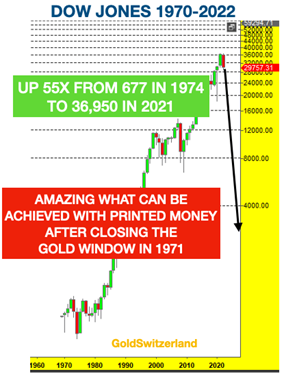
WILL ALFRED LOSE ALL HIS MONEY
Let’s return to Alfred a US citizen who was born at the end of WWII, I wrote an article about him in February 2019 called “Stock Investors like Alfred to Lose 98% of their Investment”
Well, Alfred was very lucky throughout his investment life. By putting all his savings and excess earnings into the Dow Jones he managed to amass a fortune of $14 million until the end of February 2019. He was even more fortunate to see the US market gain another 45% (including dividends) until the end of 2021. So his wealth had by that time grown another $6 million to $20.3 million.
As I wrote in the 2019 article, Alfred never sold and sat through every vicious correction for 77 years. So until January 2022, buy and hold had worked like a dream.
By the end of the first week of October 2022 Alfred’s portfolio is down from $20.3 in January to $16.2 million which is a loss of $4.1 million in 2022.
Currently Alfred is not the slightest bit worried as he has seen many corrections of 20% to 60% in the last 77 years.
Based on his experience, Alfred is not concerned although $4 million is a big paper loss.
But what if the dream is over for Alfred and turns into a nightmare with all his gains evaporating in a market collapse of 90% or more like in 1929-32?
Well, in my view the odds are very high that we will see a fall of that magnitude.
A DEBT INFESTED WORLD
A debt infested world has lived on borrowed time since the debt feast started in 1971 when Nixon took the dollar, and therefore most currencies, off the gold standard.
And what a feast it has been with total US debt going from $1.7 trillion in 1971 to $92 trillion today.
That is a staggering 54X increase in US debt in 52 years!
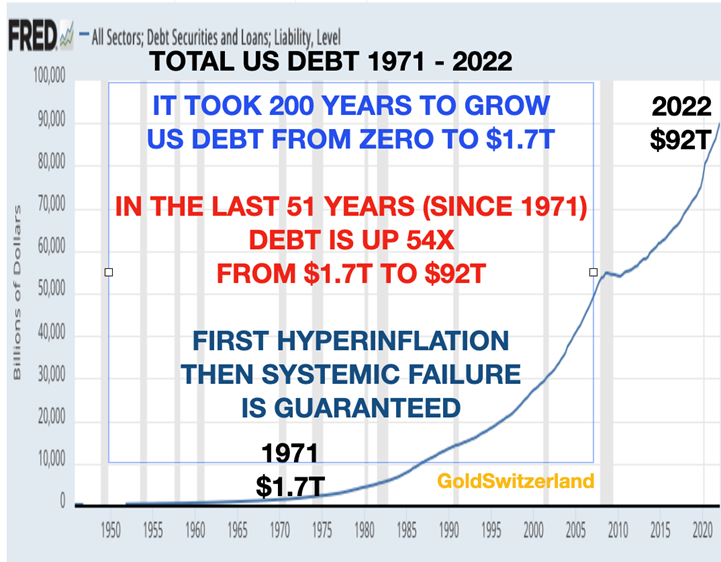
Just look at the Dow Jones chart at the beginning of the article which shows a 55X increase in the index during the same time period.
It is clearly no coincidence that stocks are up 54X and debt 55X since the early 1970s
Stocks have not risen due to a sound and well managed economy. No, stocks only went up because printed money was handed to investors to inflate the economy and asset prices.
We must remember that during the same period since 1971 when the gold window was closed that the US dollar has lost 98% of its value in real terms.
Thus the debt explosion has created inflated values which will deflate much faster when the debt implodes in the next few years.
So it took 200 years to go from zero debt to $1.7t. But when you remove the shackles of the monetary discipline that the gold standard enforces, irresponsible and incompetent governments and central bankers only have one objective. Their principal policy is to hang on to power for as long as possible.
When money runs out, like it did in 1971, there is only one way to stay in power and that is to buy votes. Thus the creation of $90 trillion debt since 1971 has been the most expensive bribery in history.
We must also remember that US Federal debt has increased every year since 1930 (with only a handful of years with surpluses).
The dilemma of creating money out of thin air of such a magnitude is that it leads to debts that can never be repaid, fake asset values which will implode and false human values resulting in misery and decadence. The inevitable consequences are economic and financial collapse. And that sadly is what the US and the world is facing next.
So what will be the market consequences of the coming (hyper)-inflationary depression followed by a deflationary implosion?
Let’s look at some enlightening charts:
1. THE BUFFETT INDICATOR – VALUE OF STOCK MARKET TO GDP
The total value of US stocks (Wilshire 5000) to GDP is one of Warren Buffett’s favourite indicators. It reached almost 200% in November 2021. The previous record valuations were 140% in 2000 (Dot Com Bubble) and 106% in 2007 (Sub Prime Crisis). A strong support area is the lows in the1970s at around 33%.
I doubt however that the 1970s support will hold after the Epic mega bubble we have just seen totally fueled by tens of trillions of exploding dollar debt.
Especially since 2009, the debt intoxication of investors has driven stocks to dizzy heights which is likely to result in a hangover that will not only take years but probably decades to recover from.
So poor Alfred, this is not what he needed at the tail end of his investment life. But sadly he like most investors don’t know better since the Fed until now has saved them.
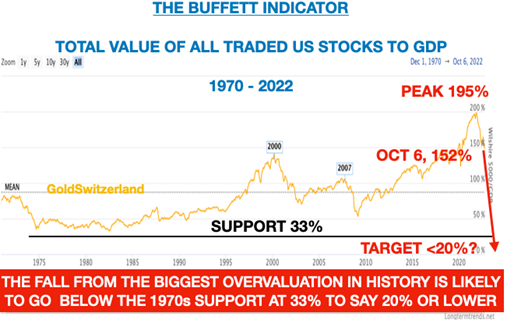
2. PRICE EARNINGS RATIO – BOTH PRICE AND EARNINGS TO DECLINE
I remember well when I moved to the UK in 1972 and worked for Dixons first as Finance Director and later as Vice-Chairman. Dixons was a camera and audio/TV retailer at the time, quoted on the London stock exchange. I received my first options at £1.32.
Two years later after an oil crisis in the Middle East and a coal miners’ strike in the UK (with only 3 days of electricity) stocks crashed across the globe. Dixons’ share price collapsed from 132 English pence to 10 pence. So my options were 93% out of the money!
Dixons had a strong balance sheet and was still profitable. But profits declined by around 75%. (It wasn’t easy to demonstrate TVs and HIFI in candle light.)
So Dixons’ earnings per share of 6.6 pence in 1972 went down by 75% to 1.6 pence and the PE ratio went from 20 to 6. That was the best lesson I ever learnt to as a young man to experience what can happen to markets. Anyway, I then joined the board at 29 and we went on to build the business to the biggest consumer electronics retailer in the UK and a FTSE 100 company.
Most investors today, including Alfred, would not believe that the shares of a successful company can decline as much as 93% but I was fortunate to experience this when I was young and did not have much to lose.

So as the debt bubble fueled market collapses from a historical and epic uber-valuation, I would would not be surprised to see the S&P PE ratio to undershoot the 7 level in 1980 and go below 5 as shown in the chart above.
3. DOW / GOLD RATIO TO GO TO HISTORICAL LOWS
Since the gold window was closed in 1971, the fluctuations in the Dow/Gold ratio have been dramatic. This is what can be expected when most of the gold trading takes place in a heavily manipulated paper market. The whole false financial system based on worthless paper assets is now under tremendous pressure.
For example, the UK’s mini-budget two weeks ago led to a massive decline in the pound and a near collapse of the UK bond market. The bank of England, at the request of pension funds, had to support the bond market to the extent of 65 billion pounds.
This shows the fragility of markets today when a relatively minor event can lead to a near collapse of the UK financial system and therefore also the global system, since everything is connected.
The problem was as expected in the $2 quadrillion derivative market which had been used to hedge interest risk by the pension funds. Virtually every financial instrument traded today includes a major element of derivatives.
So when we look at the Dow/Gold Chart we must bear in mind that most of the trading in the Dow and Gold is in derivatives and that by a multiple of many 100 times.
The Dow/Gold ratio was at 1 in 1980 which means that the Dow was 850 and gold $850. The ratio then reached a peak in 1999 as gold fell and the Dow was strong. Since then the ratio has gone down to 17 or 62%. This means that gold has strongly outperformed the Dow.
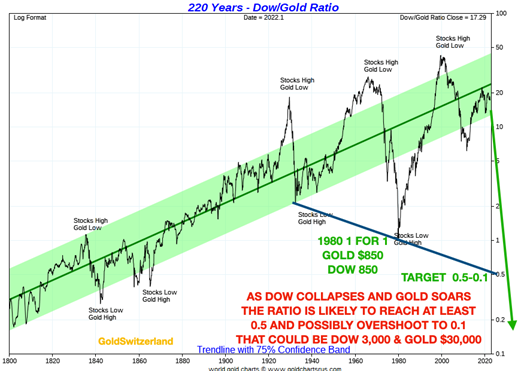
If the Dow goes down by over 90% like in 1932, we would expect the ratio to reach the support of 0.5 which means for example 3500 Dow and $7,000 gold.
But the current massive over valuation of stocks and undervaluation of gold is likely to take the ratio to the 0.2 level of the early 1800s and even overshoot.
As the gold paper market collapses, and gold can trade freely but with massive physical demand and very little gold available, I would not be surprised to see a 0.1 ratio. That could lead to 3,500 Dow and $35,000 gold.
That gold price would also more accurately reflect the massive growth in money supply as gold today is massively under valued in relation to the growth in US money supply as the chart below shows.
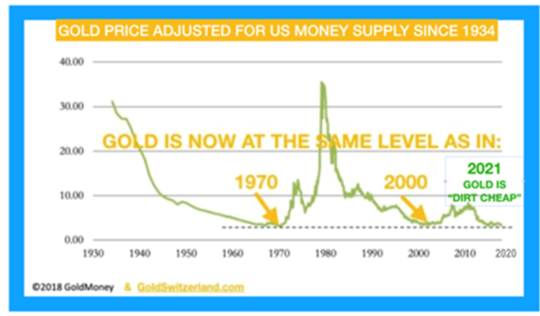
FORECASTNG IS A MUG’S GAME
By definition, a forecast will always be wrong. Only future historians will give the world the correct retrospective forecast since hindsight is the most perfect of all sciences.
Thus the above projections are just an indication where the biggest global bubble asset market in history could implode to when things go really wrong – which I fear they will do.
The most important thought I would like to leave investors with is that risk is today at a historical extreme.
Therefore today is not the time for greed, hoping that markets will grow to the sky. Instead, now is the time for wealth preservation and protecting what you have. Otherwise, wealth which has been acquired over several decades could easily evaporate in the next few years.
Physical gold and silver have throughout history acted as the ultimate insurance of wealth. This time will not be different.
end
Lawrie Williams
END
3.Chris Powell of GATA provides to us very important physical commentaries
This is a must read
(Alasdair Macleod)
Alasdair Macleod: Banking crisis prompts the great unwind
Submitted by admin on Thu, 2022-10-13 12:11Section: Daily Dispatches
By Alasdair Macleod
GoldMoney, Toronto
Thursday, October 13, 2022
There is a growing feeling in markets that a financial crisis of some sort is now on the cards. Credit Suisse’s very public struggle to refinance itself is proving to be a wake-up call for markets, alerting investors to the parlous state of global banking.
This article identifies the principal elements leading us into a global financial crisis. Behind it all is the threat from a new trend of rising interest rates, and the natural desire of commercial banks everywhere to reduce their exposure to falling financial asset values both on their balance sheets and held as loan collateral. And there are specific problems areas, which we can identify.
The phenomenal growth of over-the-counter derivatives and regulated futures has been against a background of generally declining interest rates since the mid-1980s. That trend is now reversing, so we must expect the $600 trillion of global OTC derivatives and a further $100 trillion of futures to contract as banks reduce their derivative exposure.
In the last two weeks, we have seen the consequences for the gilt market in London, warning us of other problem areas to come.
Commercial banks are overleveraged, with notable weak spots in the eurozone, Japan, and the UK. It will be something of a miracle if banks in these jurisdictions manage to survive contracting bank credit and derivative blow-ups. If they are not prevented, even the better-capitalized American banks might not be safe.
Central banks are mandated to rescue the financial system in troubled times. However, we find that the European Central Bankand its entire euro system of national central banks, the Bank of Japan, and the U.S. Fed are all deeply in negative equity and in no condition to underwrite the financial system in this rising interest rate environment. …
… For the remainder of the analysis:
https://www.goldmoney.com/research/banking-crisis-the-great-unwind?gmrefcode=gata
end
Demand for gold/silver coins huge at the UK’s royal mint
(London Financial Times/GATA)
UK’s Royal Mint lifted by market turmoil as demand for gold surges
Submitted by admin on Thu, 2022-10-13 17:13Section: Daily Dispatches
By Daniel Thomas
Financial Times, London
Thursday, October 13, 2022
Market turmoil during the past year has boosted the performance of the Royal Mint as demand for gold coins and precious metals surged, pushing the profits of the UK’s oldest surviving manufacturer to a record high.
The wholly state-owned company has supplied the country’s coins since the reign of King Alfred the Great more than 1,100 years ago. But in its modern form it has expanded into sales of precious metals, historic coins, jewellery, and luxury collectibles.
A record number of investors hedged their portfolios with physical precious metals such as gold and silver during the course of its latest financial year to the end of March, pushing the Mint’s pre-tax profits to L18 millon, up from L 12.4 millon in the previous 12 months. Revenues rose from £ 1.1 billionn to £1.4 billion. …
… For the remainder of the report:
https://www.ft.com/content/1591cafa-6ff1-4a53-99ae-778af37b6f43
end
4. OTHER PHYSICAL SILVER/GOLD
5.OTHER COMMODITIES:
end
COMMODITIES IN GENERAL/
END
END
6.CRYPTOCURRENCIES
7. GOLD/ TRADING
Your early currency/gold and silver pricing/Asian and European bourse movements/ and interest rate settings FRIDAY morning 7:30 AM
ONSHORE YUAN: CLOSED DOWN 7.1939
OFFSHORE YUAN: 7.2286
SHANGHAI CLOSED UP 58.35 PTS OR 1.85%
HANG SENG CLOSED UP 198.53 OR 1.21%
2. Nikkei closed UP 853.34 PTS OR 3.25%
3. Europe stocks SO FAR: ALL GREEN
USA dollar INDEX UP TO 113.15/Euro FALLS TO 0.97144
3b Japan 10 YR bond yield: FALLS TO. +.243/ !!!!(Japan buying 100% of bond issuance)/Japanese yen vs usa cross now at 146.73/JAPANESE YEN COLLAPSING AS WELL AS LONG TERM YIELDS RISING BREAKING THE JAPANESE CENTRAL BANK.
3c Nikkei now ABOVE 17,000
3d USA/Yen rate now well ABOVE the important 120 barrier this morning
3e Gold DOWN /JAPANESE Yen DOWN CHINESE YUAN: DOWN -// OFF- SHORE: DOWN
3f Japan is to buy the equivalent of 108 billion uSA dollars worth of bond per month or $1.3 trillion. Japan’s GDP equals 5 trillion usa./“HELICOPTER MONEY” OFF THE TABLE FOR NOW /REVERSE OPERATION TWIST ON THE BONDS: PURCHASE OF LONG BONDS AND SELLING THE SHORT END
Japan to buy 100% of all new Japanese debt and by 2018 they will have 25% of all Japanese debt. EIGHTY percent of Japanese budget financed with debt.
3g Oil DOWN for WTI and DOWN FOR Brent this morning
3h European bond buying continues to push yields lower on all fronts in the EMU. German 10yr bund DOWN TO +2.205%***/Italian 10 Yr bond yield RISES to 4.663%*** /SPAIN 10 YR BOND YIELD FALLS TO 3.378%…** DANGEROUS//
3i Greek 10 year bond yield FALLS TO 4.785//
3j Gold at $1654.90//silver at: 18.68 7 am est) SILVER NEXT RESISTANCE LEVEL AT $30.00
3k USA vs Russian rouble;// Russian rouble UP 1 AND06/100 roubles/dollar; ROUBLE AT 62.58//
3m oil into the 87 dollar handle for WTI and 92 handle for Brent/
3n Higher foreign deposits out of China sees huge risk of outflows and a currency depreciation. This can spell financial disaster for the rest of the world/
JAPAN ON JAN 29.2016 INITIATES NIRP. THIS MORNING THEY SIGNAL THEY MAY END NIRP. TODAY THE USA/YEN TRADES TO 147.75DESTROYING JAPANESE CITIZENS WITH HIGHER FOOD INFLATION
30 SNB (Swiss National Bank) still intervening again in the markets driving down the FRANC. It is not working: USA/SF this 1.0042– as the Swiss Franc is still rising against most currencies. Euro vs SF 0.9755well above the floor set by the Swiss Finance Minister. Thomas Jordan, chief of the Swiss National Bank continues to purchase euros trying to lower value of the Swiss Franc.
USA 10 YR BOND YIELD: 3.895 DOWN 6 BASIS PTS…GETTING DANGEROUS
USA 30 YR BOND YIELD: 3.879 DOWN 5 BASIS PTS//(USA 30 YR INVERTED TO THE USA 10)
USA DOLLAR VS TURKISH LIRA: 18,59…GETTTING DANGEROUS
end
Overnight: Newsquawk and Zero hedge:
FIRST, ZEROHEDGE
Futures Flat Amid Firehose Of News, Start Of Earnings Season
FRIDAY, OCT 14, 2022 – 08:34 AM
Welcome to the final day of the week and first day of Q3 earnings season, which coming after yesterday’s torrid post-CPI reversal, has already seen a flood of newsflow and market volatility: while JPM reported solid earnings this morning to launch the latest earnings season helping push its stock higher in the premarket, followed by mediocre results from Wells and Citi and a soggy update from Morgan Stanley which sent its price down 3%, the big news of the day is the unexpected termination of UK chancellor Kwasi Kwarteng who was summarily fired as a scapegoat for the unprecedented chaos gripping the UK over the past month.
And with traders desperately scrambling to stay on top of all the flashing red headlines, futures are surprisingly flat, as S&P 500 and Nasdaq 100 futures flip between losses and gains as corporate results started rolling in. US banks are expected to post the biggest profit decline of any S&P 500 Index sector, according to data compiled by Bloomberg Intelligence, even as energy props up the entire market. The fear is Fed tightening will spark defaults and force banks to set aside higher provisions against losses.
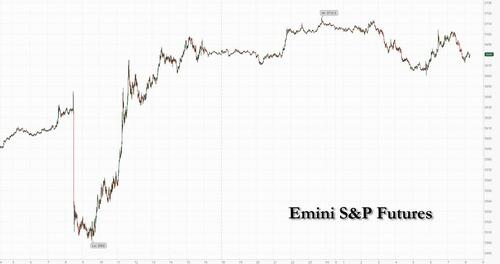
In premarket trading, tech shares continued to weaken as Jefferies became the latest bank to highlight the impact of higher rates and US restrictions on shipments to China. Nutanix shares rose as much as 18% in premarket trading after Dow Jones reported that the company is exploring a sale after receiving takeover interest, citing people familiar with the matter. Here are some other notable premarket movers:
- Delta Air Lines (DAL US) shares gain 1.3% in premarket trading after Cowen upgraded the carrier to outperform from market perform, noting that the third quarter was strong outside of Hurricane Ian, which took earnings slightly below the broker’s estimates.
- Beyond Meat (BYND US) shares fell 10% in premarket trading after the company lowered its 2022 revenue outlook and said it’s reducing current workforce by approximately 200 employees.
- Keep an eye on Blue Owl (OWL US) as the stock was initiated with an overweight recommendation at Piper Sandler, which says the asset management firm is well positioned to take advantage of long-term industry tailwinds.
- Travere Therapeutics (TVTX US) fell 5.1% in postmarket trading on Thursday as the company announced that it sees a three-month extension of the previously assigned PDUFA target action date for its application for accelerated approval of sparsentan for the treatment of IgA nephropathy.
“Even though investors may look through a disappointing CPI print, it will be a much higher bar to look through weak corporate earnings.” Invesco global market strategist David Chao told clients. “Growth is below trend and decelerating because the Fed is still tightening. This is a tough backdrop for risk assets.”
In Europe, the Stoxx 50 adds 1%. IBEX outperforms peers, climbing 1.1%, DAX lags, adding 0.8%. Utilities, real estate and chemicals are the strongest-performing sectors. Here are the biggest movers:
- Bystronic shares rise as much as 1.9%, the most since June, after company reported a net revenue beat yoy for the nine-month period. Analysts welcome a more specified and positive outlook.
- Ahold Delhaize shares advance as much as 2.3% after Bryan Garnier said a potential Kroger-Albertsons tie-up removes concerns about Ahold merging with Albertsons, which had been rumored over the summer.
- Arcadis gains as much 5.3%, the most intraday in three months, after KBC Securities raised its rating on the engineering company to buy from accumulate, saying recent acquisitions have increased the company’s exposure to growth trends, while the stock’s valuation is “conservative.”
- Kone shares fall, paring earlier gains of as much as 4.3%, after the Finnish elevator firm reported preliminary adjusted Ebit for the third quarter that missed estimates.
- Temenos shares tumble as much as 23% to the lowest since 2016, after the banking software firm announced a sharp cut to FY Ebit target on the back of a 50% miss on bottom-line in 3Q.#
- International Distributions Services plunges as much as 17%, most since early days of Covid-19 pandemic, after reporting a loss at its Royal Mail unit and warning of possible job cuts in response to recent strike action.
- TomTom NV falls as much as 12%, the most since May 24, after it lowered guidance for free cash flow as a percentage of revenue to break-even from at least 5%.
In Britain, government bonds rallied sharply as Prime Minister Liz Truss prepared to reverse parts of her tax-cutting program and ousted chancellor Kwasi Kwarteng. The pound weakened. Her plans have roiled UK markets for weeks, forcing the Bank of England to launch an emergency bond-buying program. That program expires later on Friday.
“It does seem pretty clear that the government is preparing a U-turn on at least a very big chunk, if not half, the permanent tax cuts in the budget,” BlackRock Inc.’s chief macroeconomic strategist, Rupert Harrison, told Bloomberg Television. “And if we don’t get that, then the markets will react very negatively.”
Earlier in the session, Asian stocks took impetus from the aggressive rebound on Wall St where stocks made a remarkable comeback from the initial CPI-related selling with several factors attributed to the turnaround including a dovish ECB staff model view, speculation of a major U-turn in the UK’s fiscal plans and a touted short squeeze. ASX 200 was lifted in which energy led the broad strength across sectors and after Australian Treasurer Chalmers recently ruled out scrapping tax cuts in the budget. Nikkei 225 outperformed and breached the 27,000 level amid some earnings encouragement with index heavyweight Fast Retailing boosted after it posted a record annual profit. Hang Seng and Shanghai Comp. benefitted from the heightened risk appetite as the PBoC reiterated support pledges, while participants digested relatively inline inflation numbers and now await the latest Chinese trade data.
In FX, the Bloomberg Dollar Spot Index staged a modest rebound after yesterday’s loss and the greenback advanced versus most of its Group-of-10 peers.
- The pound led G-10 declines, halting a blistering rally that’s made it the best performer among major currencies this week amid reports of potential u-turns on the UK government’s proposed tax cuts.
- The euro pared some of yesterday’s advance, to trade at around $0.9750. Bunds and Italian bonds advanced for a second day, led by the belly.
- The Aussie was the best G-10 performer after China’s central bank pledged to do more to stimulate the economy. Shorter-maturity bonds declined, following losses in similar-dated Treasuries on Thursday.
- The yen headed for an eighth day of losses, but selling was tempered by speculation the authorities will step in to support the currency. A five-year auction drew solid demand
- The Hungarian forint rallied by as much as 3% versus the euro, the biggest jump in 11 years, after the central bank said it would provide 18% one-day deposit rate
In rates, Treasury yields fell by as much as 4bps, led by the front end following a sharp rally in gilts as UK bonds head toward their biggest weekly gains since 2011 amid expectations the British government is preparing to partially reverse its tax cuts plans. The UK curve aggressively bull-flattens with long-end yields richer by 30bp on the session; UK 2s10s, 5s30s spreads flatter by 17bp and 5bp. In the US, 10-year futures remain short of Thursday’s highs with cash yields richer by 3bp-5bp across the curve. Focal points of US session include retail sales data and three scheduled Fed speakers. US 10-year yields near lows of the day into early US session, richer by 4.5bp at around 3.90% with gilts outperforming by an additional 20bp in the sector; long-end of the US curve lags slightly, steepening 5s30s spread by ~1bp.
In commodities, WTI and Brent front-month futures are modestly softer on the day as the Dollar picked up in early European hours, but the contracts hold onto most of yesterday’s gains. Turkish President Erdogan has ordered the energy minister to build a gas hub in Turkey following talks with Russian President Putin; says both countries will immediately work on Putin’s proposal to transport Russian gas, via NTV cited by Reuters. Spot gold found resistance at it is 21 DMA (USD 1,671.50/oz) with the yellow metal edging lower as the USD extends on intraday highs. LME futures are mixed/contained with 3M copper holding onto levels above USD 7,500/t, but LME aluminium dips following the recent rise. Spot gold falls roughly $5 to trade near $1,662/oz.
Bitcoin posts modest gains after yesterday’s rebound, with the crypto above USD 19,500, whilst Ethereum holds a USD 1,300+ handle.
To the day ahead now, and data releases include US retail sales for September, and the University of Michigan’s preliminary consumer sentiment index for October. From central banks, we’ll hear from the ECB’s Holzmann, and the Fed’s George, Book and Waller. Finally, earnings releases include JPMorgan, Wells Fargo, Citigroup, Morgan Stanley and UnitedHealth.
Market Snapshot
- S&P 500 futures down 0.2% to 3,674.50
- STOXX Europe 600 up 1.1% to 393.36
- MXAP up 1.9% to 138.38
- MXAPJ up 1.7% to 446.58
- Nikkei up 3.3% to 27,090.76
- Topix up 2.3% to 1,898.19
- Hang Seng Index up 1.2% to 16,587.69
- Shanghai Composite up 1.8% to 3,071.99
- Sensex up 1.5% to 58,119.00
- Australia S&P/ASX 200 up 1.7% to 6,758.83
- Kospi up 2.3% to 2,212.55
- German 10Y yield little changed at 2.18%
- Euro down 0.3% to $0.9751
- Brent Futures down 0.6% to $93.97/bbl
- Gold spot down 0.2% to $1,663.18
- U.S. Dollar Index up 0.36% to 112.76
Top Overnight News from Bloomberg
- Hawkish European Central Bank officials aim to start unwinding the institution’s €5.1 trillion ($4.9 trillion) asset hoard by early 2023 while retaining interest rates as their primary monetary-policy tool, according to people familiar with the matter
- The euro-area economy may succumb to two consecutive quarters of contraction, European Central Bank Vice President Luis de Guindos told Verslo žinios, a Lithuanian newspaper
- Overstretched positioning in the options market is taking a hit after the dollar retreated following the release of the latest US inflation data
- Singapore’s central bank tightened monetary policy settings for a fifth time in the past year, warning of persistent price pressures and a clouded outlook for the global and local economy
- China’s consumer inflation remained subdued in September as lockdowns continued to impact spending habits, while soft commodity prices kept producer inflation in check. The consumer price index rose 2.8% last month from a year earlier
- A shift toward private markets is cushioning many of the world’s largest investors from the wreckage wrought by runaway inflation and spiraling interest rates
- Sweden’s nationalists, who emerged as the second largest political force in last month’s elections, will stay out of the new government that will take over from Magdalena Andersson’s Social Democrats
A more detailed look at global markets courtesy of Newsquawk
APAC stocks took impetus from the aggressive rebound on Wall St where stocks made a remarkable comeback from the initial CPI-related selling with several factors attributed to the turnaround including a dovish ECB staff model view, speculation of a major U-turn in the UK’s fiscal plans and a touted short squeeze. ASX 200 was lifted in which energy led the broad strength across sectors and after Australian Treasurer Chalmers recently ruled out scrapping tax cuts in the budget. Nikkei 225 outperformed and breached the 27,000 level amid some earnings encouragement with index heavyweight Fast Retailing boosted after it posted a record annual profit. Hang Seng and Shanghai Comp. benefitted from the heightened risk appetite as the PBoC reiterated support pledges, while participants digested relatively inline inflation numbers and now await the latest Chinese trade data.
Top Asian News
- Xi Faces ‘Rockiest Economy in Decades’ on Eve of Party Congress
- Singapore Unveils New $1.05 Billion Inflation-Relief Package
- Japan Keeps Up Yen Warnings, Declines to Say If Intervened
- Iron Ore Heads for Longest Run of Weekly Losses in Almost a Year
European bourses trade on a firmer footing in an extension of yesterday’s gains. There hasn’t been a clear factor behind today’s moves with some desks continuing to cite oversold conditions, evidence of disinflationary impulses in more timely indicators (e.g. NY Fed survey) and hopes of a policy u-turn in the UK. Sectors in Europe mostly firmer, with outperformance in Real Estate and Utilities. To the downside but still in positive territory, Tech, Autos and Telecom names lag peers. Stateside, Stateside, US futures are showing a more contained performance with the e-mini S&P back below 3700 as pausing for breath from yesterday’s rally.
Top European News
- UK PM Truss is to reverse some economic plans later today, according to Bloomberg sources.; UK PM Truss is to hold a press conference today (timing TBC), according to Bloomberg.
- UK Trade Department Minister Hands said there are absolutely no plans to change anything; there is no change to plans on corporation tax, according to Reuters.
- UK PM Truss and Chancellor Kwarteng are weighing up whether to announce corporation tax rise today after chancellor’s early flight back from the US, according to Times’ Swinford; no decision has yet been taken.
- UK Tory whips warned that UK PM Truss could face a leadership challenge if Chancellor Kwarteng’s economic statement on October 31st fails to end the turbulence in financial markets, according to the Daily Mail front page.
- UK senior Tories are reportedly holding talks about replacing PM Truss with a joint ticket of Rishi Sunak and Penny Mordaunt, according to The Times.
- The 1922 Committee is ready to suspend the rule that prevents a vote to oust the Conservative leader within a year of taking office, according to the New Statesman.
- ECB’s Lagarde said inflation in the EZ is far too high, and likely to stay above the ECB’s target for an expected period of time; governing council expects to raise the interest rate further over the next several meetings
- ECB’s Kazimir said 75bps hike in October is appropriate; Deposit Rate must rise above Neutral but start of balance sheet reduction can wait until next year
FX
- DXY attempts to claw back some of yesterday’s losses and briefly reclaimed 113.00 to the upside vs yesterday’s 113.92 peak.
- GBP sits as the laggard as it unwinds some of the prior day’s gains.
- USD/JPY topped yesterday’s high of 147.67 whilst BoJ Kuroda reiterated the need to maintain stimulus.
- HUF strengthened following an unexpected NBH hike to the Overnight Collateral Loan Rate.
- Hungarian Central Bank unexpectedly hikes the Overnight Collateral Loan Rate to 25% from 15.5%. NBH will launch a new one-day deposit tender from today with an 18% interest rate.
Fixed Income
- Bunds are well within a 136.75-138.52 range vs their prior 136.22 prior close.
- Gilts are back above 97.00 between from yesterday’s 94.52 Liffe settlement amidst further reports that some economic plans may be reversed by the PM later today.
- T-note towards the top of its 111-14/110-27 overnight extremes ahead of US retail sales and Fed speakers
Commodities
- WTI and Brent front-month futures are modestly softer on the day as the Dollar picked up in early European hours, but the contracts hold onto most of yesterday’s gains.
- Turkish President Erdogan has ordered the energy minister to build a gas hub in Turkey following talks with Russian President Putin; says both countries will immediately work on Putin’s proposal to transport Russian gas, via NTV cited by Reuters.
- Spot gold found resistance at it is 21 DMA (USD 1,671.50/oz) with the yellow metal edging lower as the USD extends on intraday highs.
- LME futures are mixed/contained with 3M copper holding onto levels above USD 7,500/t, but LME aluminium dips following the recent rise.
Geopolitics
- Japan’s Chief Cabinet Secretary Matsuno said North Korea’s repeated ballistic missile launches are unacceptable and he believes North Korea will take further provocative action including a possible nuclear test. Matsuno added it is getting more difficult to detect North Korea’s missiles early and react, while they are considering all options including counterattack capabilities, according to Reuters.
- North Korea fires artillery shells off sea, according to South Korean military; into the buffer zones in the east and west seas during the afternoon, Yonhap reported
US event calendar
- 08:30: Sept. Import Price Index YoY, est. 6.2%, prior 7.8%
- 08:30: Sept. Import Price Index MoM, est. -1.1%, prior -1.0%
- 8:30: Sept. Export Price Index YoY, est. 9.3%, prior 10.8%
- 08:30: Sept. Export Price Index MoM, est. -1.0%, prior -1.6%
- 08:30: Sept. Retail Sales Advance MoM, est. 0.2%, prior 0.3%
- 08:30: Sept. Retail Sales Control Group, est. 0.3%, prior 0%
- 08:30: Sept. Retail Sales Ex Auto MoM, est. -0.1%, prior -0.3%
- 10:00: Aug. Business Inventories, est. 0.9%, prior 0.6%
- 10:00: Oct. U. of Mich. 5-10 Yr Inflation, est. 2.8%, prior 2.7%
- 10:00: Oct. U. of Mich. 1 Yr Inflation, est. 4.6%, prior 4.7%
- 10:00: Oct. U. of Mich. Expectations, est. 58.2, prior 58.0
- 10:00: Oct. U. of Mich. Current Conditions, est. 59.5, prior 59.7
- 10:00: Oct. U. of Mich. Sentiment, est. 58.8, prior 58.6
DB’s Jim Reid concludes the overnight wrap
The term rollercoaster is one of the most overused, lazy terms to describe markets, but the last 24 hours are best summed up by being a major rollercoaster ride and actually home to one of the biggest intra-day turnarounds in living memory.
The white-knuckle ride started with a boost amidst reports of a potential fiscal U-turn out of the UK before then slumping on another upside surprise in US inflation, before rallying again (and rallying very hard) for no obvious reason other than potentially stretched bearish positioning ahead of the CPI. If that was the case one can only imagine how bullish markets would have been if CPI was soft. If you’re looking to further explain the unexplainable, Bloomberg suggested that the S&P 500 had given back 50% of the post-covid rally at the lows which triggered technical buy programs. Who knows if this was true.
To give you an idea of the ride, futures on the S&P were up +1.57% before CPI, down -2.40% around an hour later, but with the main index closing +2.60% and thus putting a spectacular end to a run of 6 consecutive declines, in spite of a CPI report that was another case of bad news from whatever angle you wanted to look at it. The index had a remarkable intraday range of 5.52%. Let’s see what US bank earnings bring today as they herald in the unofficial start of earnings season.
In terms of the details of that CPI report, the headline price gains for the month came in at +0.4%, which was above the +0.2% reading expected and meant that the year-on-year measure only ticked down to +8.2% (vs. +8.1% expected). Second, and more concerning from the Fed’s point of view, core CPI was also stronger than expected, with monthly core CPI at +0.6% (vs. +0.4% expected) for a second month running, thus taking the year-on-year measure up to +6.6%, which is the fastest that core inflation has been since 1982. Third, it wasn’t just a case of outliers driving inflation higher, since it continued to remain broad-based across the consumer basket. In fact, the Cleveland Fed’s trimmed mean measure that excludes the biggest outliers in either direction was still up +0.56% on the month (or +6.96% on an annualised basis), so still far from levels that the Fed can be comfortable with. And fourth, if you look at the Atlanta Fed’s measure that divides the consumer basket into sticky prices that change slowly and flexible prices that change quickly, then the monthly gain in sticky prices in September was the biggest since June 1982 at +0.68%, so things are getting even worse on that measure.
Against that backdrop, investors swiftly moved to upgrade their expectation of future tightening from the Federal Reserve, with a 75bp hike at the November meeting now fully priced in for the first time. In addition, markets placed a growing probability on the chances of the Fed continuing at a 75bps pace in December rather than slowing down. That’s in line with our US econ team’s updated call following the release, where they now expect the Fed to maintain the +75bp pace of hikes through December (link here). In markets a total of 143bps of hikes are now priced in by year-end. Looking further out into 2023, the peak rate priced for March rose +25.5bps on the day to a new high of 4.92% to reflect the extra 25bps of hikes, and the rate priced for end-2023 similarly rose +22.0bps to a fresh high of 4.57%.
With more tightening being priced in for the months ahead, Treasuries sold off across the curve with the front-end particularly impacted. By the close of trade, yields on 2yr Treasuries surged +17.2bps on the day to a post-2007 high of 4.46%, and their 10yr counterparts were also up +4.7bps to 3.94% after trading in a 23.8bps range. This morning yields are less than a bps lower across most of the curve.
Decomposing the S&P, the best performers were the cyclically-sensitive energy, financial, information tech, and materials sectors, which, again, bucks against the macro news from yesterday. The Nasdaq lagged slightly behind the S&P, gaining +2.23%. In overnight trading, US equity futures are pointing to further gains with contracts on the S&P 500 (+0.54%) and the NASDAQ 100 (+0.47%) higher ahead of the big bank earnings.
Whilst there was plenty of interest in the US CPI, here in the UK there was also lots of market action going on amidst speculation that the government could be on the verge of a U-turn over their recent mini-budget. Sterling surged on the reports, which came from multiple outlets all suggesting that talks were taking place on reversing course. The biggest centre of speculation was with regard to corporation tax, which had been set to go up to 25% from April before Truss came to office, before that was then scrapped by Truss. Not going ahead with that increase was one of the biggest single items in terms of cost in the mini-budget, which totalled £19bn of the £45bn package of tax cuts announced, although it’s not clear yet to what extent they’ll reverse, and whether that might be to a lower rate than 25%. Overnight it’s been confirmed that Chancellor Kwarteng has left the IMF conference early which has further raised speculation of an imminent U-turn.
For now we haven’t had anything officially confirmed, but sterling surged by +2.04% on the day. Admittedly it had a helping hand from general dollar weakness, but that was still the largest daily increase in sterling since the Covid-related volatility of March 2020, so not the sort of moves we’re used to seeing every day. In the meantime, there was also an incredible rally for gilts as speculation of a U-turn mounted, with the 10yr yield down -23.5bps to 4.19% and 30yr yields down -26.1bps to 4.54% having been 5.09% at the highs in the previous session. That also came as the Bank of England bought a record £4.68bn of bonds yesterday, which is the largest so far, ahead of the scheduled end to their intervention in the gilt market today. Whether that actually happens we’ll see next week.
That sovereign bond rally was echoed elsewhere in Europe, with yields on 10yr bunds (-2.8bps), OATs (-3.7bps) and BTPs (-6.0bps) all moving lower on the day. And Euro equities put in a decent performance too, with the STOXX 600 recovering from its initial losses to gain +0.85%. That came in spite of investors also moving to ratchet up their expectations of future ECB tightening, with the rate priced in by year-end up +1.9bps on the day. Nevertheless, there was some better news on the inflation side from natural gas futures, which dropped to their lowest levels since early July, falling -3.98% on the day to €154 per megawatt-hour.
This morning in Asia, stock markets are tracking US equities with the Nikkei (+3.44%) leading gains and the Hang Seng (+3.38%) trading sharply higher while the Kospi (+2.45%), the CSI (+2.14%) and the Shanghai Composite (+1.74%) are also trading in positive territory.
Moving on to China, inflation has remained subdued amid persistent lockdowns and soft commodity prices. Early morning data showed that CPI advanced +2.8% y/y in September, up from +2.5% in August, pushed higher by food costs. While it rose at the fastest pace since April 2020, it fell short of market forecasts for a +2.9% gain. At the same time, the producer price index (PPI) dropped to its slowest pace in 20 months, rising by +0.9% (v/s +1.0% expected), down from +2.3% growth in August.
In the FX market, the Japanese yen has hit a fresh 32-yr low of 147.45 versus the US dollar, below the level when the Japanese authorities intervened last month. Yesterday, the BOJ Governor Haruhiko Kuroda in a speech indicated that he intends to stick to his policy of large-scale monetary easing as raising interest rates now seems inappropriate given Japan’s economic and price conditions.
The CPI was the main data focus yesterday, but we also got the weekly initial jobless claims from the US, which showed an increase to 228k in the week through October 8. That was a bit above the 225k reading expected and above the 219k reading the previous week, although it partly reflected a rise in Florida claims following Hurricane Ian.
To the day ahead now, and data releases include US retail sales for September, and the University of Michigan’s preliminary consumer sentiment index for October. From central banks, we’ll hear from the ECB’s Holzmann, and the Fed’s George, Book and Waller. Finally, earnings releases include JPMorgan, Wells Fargo, Citigroup, Morgan Stanley and UnitedHealth.
AND NOW NEWSQUAWK
Gilts soar amidst further reports that some UK economic plans may be reversed; European bourses trade on a firmer footing – Newsquawk US Market Open

FRIDAY, OCT 14, 2022 – 06:56 AM
- European bourses trade on a firmer footing in an extension of yesterday’s gains; US futures are more contained
- DXY hovers around 113.00; GBP sits as the laggard as it unwinds some of the prior day’s gains, USD/JPY topped yesterday’s high of 147.67
- Gilts are back above 97.00 amidst further reports that some economic plans may be reversed by the UK PM later today who to hold a press conference today at 14:00BST/09:00EDT
- North Korea fires artillery shells off sea, according to South Korean military; into the buffer zones in the east and west seas during the afternoon
- Looking ahead, highlights include US Retail Sales, US University of Michigan Prelim Survey, Speeches from BoE’s Bailey, Fed’s George, Cook & Waller, earnings from JP Morgan, Wells Fargo, Morgan Stanley, Citigroup
View the full premarket movers and news report.
Or why not try Newsquawk’s squawk box free for 7 days?
14th October 2022

- Click here for the Week Ahead preview.
EUROPEAN TRADE
EQUITIES
- European bourses trade on a firmer footing in an extension of yesterday’s gains.
- There hasn’t been a clear factor behind today’s moves with some desks continuing to cite oversold conditions, evidence of disinflationary impulses in more timely indicators (e.g. NY Fed survey) and hopes of a policy u-turn in the UK.
- Sectors in Europe mostly firmer, with outperformance in Real Estate and Utilities. To the downside but still in positive territory, Tech, Autos and Telecom names lag peers.
- Stateside, Stateside, US futures are showing a more contained performance with the e-mini S&P back below 3700 as pausing for breath from yesterday’s rally.
- Click here for more detail.
FX
- DXY attempts to claw back some of yesterday’s losses and briefly reclaimed 113.00 to the upside vs yesterday’s 113.92 peak.
- GBP sits as the laggard as it unwinds some of the prior day’s gains.
- USD/JPY topped yesterday’s high of 147.67 whilst BoJ Kuroda reiterated the need to maintain stimulus.
- HUF strengthened following an unexpected NBH hike to the Overnight Collateral Loan Rate.
- Hungarian Central Bank unexpectedly hikes the Overnight Collateral Loan Rate to 25% from 15.5%. NBH will launch a new one-day deposit tender from today with an 18% interest rate.
- Click here for more detail.
FIXED INCOME
- Bunds are well within a 136.75-138.52 range vs their prior 136.22 prior close.
- Gilts are back above 97.00 between from yesterday’s 94.52 Liffe settlement amidst further reports that some economic plans may be reversed by the PM later today.
- T-note towards the top of its 111-14/110-27 overnight extremes ahead of US retail sales and Fed speakers.
- Click here for more detail.
COMMODITIES
- WTI and Brent front-month futures are modestly softer on the day as the Dollar picked up in early European hours, but the contracts hold onto most of yesterday’s gains.
- Turkish President Erdogan has ordered the energy minister to build a gas hub in Turkey following talks with Russian President Putin; says both countries will immediately work on Putin’s proposal to transport Russian gas, via NTV cited by Reuters.
- Spot gold found resistance at it is 21 DMA (USD 1,671.50/oz) with the yellow metal edging lower as the USD extends on intraday highs.
- LME futures are mixed/contained with 3M copper holding onto levels above USD 7,500/t, but LME aluminium dips following the recent rise.
- Click here for more detail.
NOTABLE EUROPEAN HEADLINES
- UK PM Truss is to reverse some economic plans later today, according to Bloomberg sources.; UK PM Truss is to hold a press conference today (timing TBC), according to Bloomberg.
- No announcements are expected today on the UK mini-Budget, according to Sky News’ Beth Rigby.
- UK Trade Department Minister Hands said there are absolutely no plans to change anything; there is no change to plans on corporation tax, according to Reuters.
- UK PM Truss and Chancellor Kwarteng are weighing up whether to announce corporation tax rise today after chancellor’s early flight back from the US, according to Times’ Swinford; no decision has yet been taken.
- UK Tory whips warned that UK PM Truss could face a leadership challenge if Chancellor Kwarteng’s economic statement on October 31st fails to end the turbulence in financial markets, according to the Daily Mail front page.
- UK senior Tories are reportedly holding talks about replacing PM Truss with a joint ticket of Rishi Sunak and Penny Mordaunt, according to The Times.
- The 1922 Committee is ready to suspend the rule that prevents a vote to oust the Conservative leader within a year of taking office, according to the New Statesman.
- ECB’s Lagarde said inflation in the EZ is far too high, and likely to stay above the ECB’s target for an expected period of time; governing council expects to raise the interest rate further over the next several meetings
- ECB’s Kazimir said 75bps hike in October is appropriate; Deposit Rate must rise above Neutral but start of balance sheet reduction can wait until next year
NOTABLE EUROPEAN DATA
- EU Eurostat Trade NSA, Eur (Aug) -50.9B EU (Prev. -34.0B EU, Rev. -33.9B EU)
NOTABLE US HEADLINES
- US President Biden’s administration renewed the COVID-19 emergency status, according to WSJ.
- Twitter (TWTR) said it is seeking correspondence between Elon Musk and federal authorities over federal probe into Musk’s conduct, while it sought correspondence between Musk and investigators ‘months ago’.
- US President Biden is to sign an order seeking new prescription drug cost savings, according to an official.
CRYPTO
- Bitcoin posts modest gains after yesterday’s rebound, with the crypto above USD 19,500, whilst Ethereum holds a USD 1,300+ handle.
GEOPOLITICS
- Japan’s Chief Cabinet Secretary Matsuno said North Korea’s repeated ballistic missile launches are unacceptable and he believes North Korea will take further provocative action including a possible nuclear test. Matsuno added it is getting more difficult to detect North Korea’s missiles early and react, while they are considering all options including counterattack capabilities, according to Reuters.
- North Korea fires artillery shells off sea, according to South Korean military; into the buffer zones in the east and west seas during the afternoon, Yonhap reported
APAC TRADE
EQUITIES
- APAC stocks took impetus from the aggressive rebound on Wall St where stocks made a remarkable comeback from the initial CPI-related selling with several factors attributed to the turnaround including a dovish ECB staff model view, speculation of a major U-turn in the UK’s fiscal plans and a touted short squeeze.
- ASX 200 was lifted in which energy led the broad strength across sectors and after Australian Treasurer Chalmers recently ruled out scrapping tax cuts in the budget.
- Nikkei 225 outperformed and breached the 27,000 level amid some earnings encouragement with index heavyweight Fast Retailing boosted after it posted a record annual profit.
- Hang Seng and Shanghai Comp. benefitted from the heightened risk appetite as the PBoC reiterated support pledges, while participants digested relatively inline inflation numbers and now await the latest Chinese trade data.
NOTABLE APAC HEADLINES
- PBoC Governor Yi reiterated to step up the implementation of prudent monetary policy and will provide stronger support for the real economy, while he added they will put emphasis on supporting infrastructure construction and will support financial institutions to issue equipment upgrade loans to key sectors including the manufacturing sector. Furthermore, they will quicken the pace of utilisation of loans to deliver home projects and promote the stable development of the real estate market, according to Reuters.
- China may issue specials bonds early to support growth, according to China Securities Journal.
- BoJ Governor Kuroda said the pace of Japan’s economic recovery is still slow so they must continue supporting the economy, while he added that raising rates now is inappropriate in light of Japan’s economic and price conditions, according to Reuters.
- IMF official Panth said Japan’s JPY buying was likely a signalling action and the impact of such intervention does not last long, while Panth added that it is not the time for the BoJ to tweak YCC, according to Reuters.
- Japanese MOF official said there will be cases where they will or will not disclose whether they intervened, when asked if the JPY’s jump on Thursday was due to intervention, according to Reuters.
- Monetary Authority of Singapore announced to tighten its FX-based policy in which it re-centred the mid-point of the SGD NEER policy band up to its prevailing level, but kept the width and slope of the band unchanged. MAS said inflation should moderate in the quarters ahead but will remain high for some time, while its policy stance will help dampen inflation in the near term and ensure medium-term price stability.
DATA RECAP
- Chinese CPI MM (Sep) 0.3% vs. Exp. 0.4% (Prev. -0.1%)
- Chinese CPI YY (Sep) 2.8% vs. Exp. 2.8% (Prev. 2.5%)
- Chinese PPI YY (Sep) 0.9% vs. Exp. 1.0% (Prev. 2.3%)
- Singapore GDP QQ (Q3 A) 1.5% vs. Exp. 0.7% (Prev. -0.2%)
- Singapore GDP YY (Q3 A) 4.4% vs. Exp. 3.5% (Prev. 4.4%
i)FRIDAY MORNING// THURSDAY NIGHT
SHANGHAI CLOSED UP 58.35 PTS OR 1.85% //Hang Seng CLOSED UP 198.53 OR 1.21% /The Nikkei closed UP 853.34PTS OR 3.25% //Australia’s all ordinaires CLOSED UP 1.51% /Chinese yuan (ONSHORE) closed DOWN TO 7.1939 //OFFSHORE CHINESE YUAN DOWN 7.2286// /Oil DOWN TO 87.50 dollars per barrel for WTI and BRENT AT 92.73 / Stocks in Europe OPENED ALL GREEN. ONSHORE YUAN TRADING ABOVE LEVEL OF OFFSHORE YUAN/ONSHORE YUAN TRADING WEAKER AGAINST US DOLLAR/OFFSHORE WEAKER
2 a./NORTH KOREA/ SOUTH KOREA/
///NORTH KOREA/SOUTH KOREA/
end
2B JAPAN
3c CHINA
end
4.EUROPEAN AFFAIRS//UK AFFAIRS
UK
Chaos in the UK as Truss sacks Kwarteng and will now unveil major U turn on tax cuts: exactly what Bailey wanted
(zerohedge)
UK Chaos: Truss Sacks Kwarteng, Set To Unveil Major U-Turn On Tax Cuts
UK Chaos: Truss Sacks Kwarteng, Appoints Hunt As New Chancellor Ahead Of Major U-Turn On Tax Cuts
FRIDAY, OCT 14, 2022 – 07:19 AM
Update (1036ET):
Truss’ press conference is now over, and it was relatively short.
Her speech highlights the planned policy reversal of tax cuts to increase the corporation tax. She said this would add £18bn in taxes for the country.
Truss said her new Chancellor Jeremy Hunt would help her succeed in her mission to spur economic growth.
She said she was “incredibly sorry” to sack Kwarteng as chancellor, calling him a “great friend.”
Here’s more from BBC’s chief political correspondent Nick Eardley about Truss’ admission to mistakes:
The prime minister is making clear she has not changed her fundamental position – that the economic priority has to be growth.
But she has admitted for the first time that the government went further and faster than the markets expected.
This is important – Truss seems to be admitting she and the former chancellor made mistakes in selling their plan.
Hence the U-turn on corporation tax, which she hopes will help show the markets the government is serious about balancing the books. To try and get back on track, she has junked a key pledge she made in the Conservative leadership race.
UK gilt YIELDS are rising after Truss’ speech. Earlier yields were falling on the news of a U-turn. The pound remains at session lows around $1.119
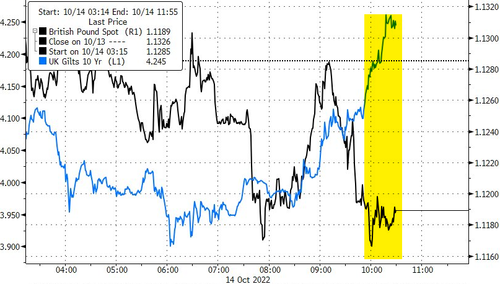
* * *
FRIDAY, OCT 14, 2022 – 07:19 AM
Update (0811ET):
kwarteng has confirmed in a statement on Twitter that Truss has sacked him. He must have written it while on the airplane back to London.
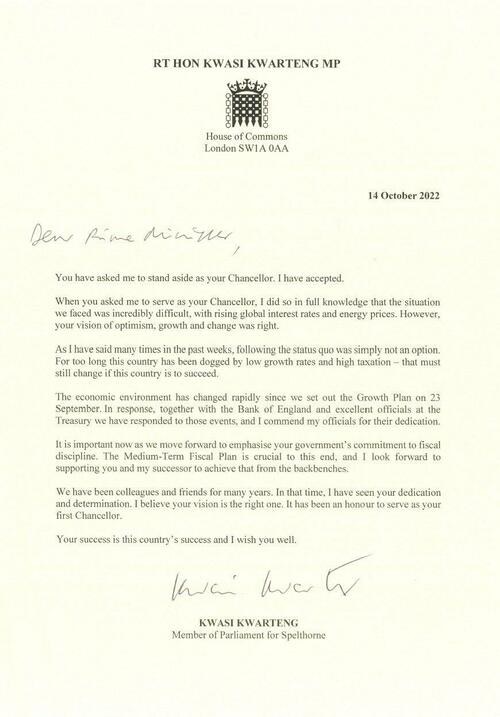
* * *
Update (0806ET):
Steven Swinford, a political editor at the Times, tweeted:
Multiple sources are now telling me that Jeremy Hunt will be the new chancellor, although I’ve not had official confirmation yet.
It’s being complicated by the fact he’s out of the country
Hunt was one of Sunak’s most prominent backers
Swinford said more officials could be sacked.
* * *
Update (0757ET):
News of Kwarteng being sacked as chancellor and Truss expected to make a U-turn of her disastrous mini-budget later today has led to a continued rally in UK bonds and a selloff in sterling.
Yields on the 10-year gilts are down about 23bps this week. This will be the most significant move since late May if the bond rally holds.
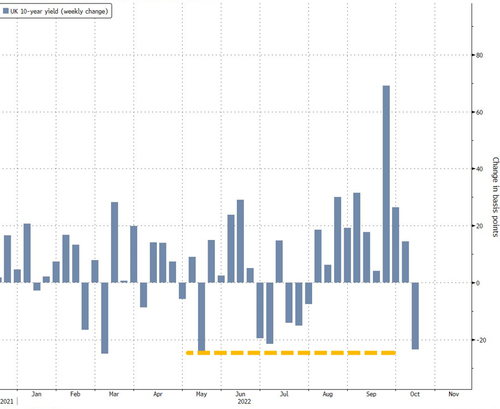
On the other hand, the pound has given up any gains and hit a new low in the session, trading below the $1.12 handle.
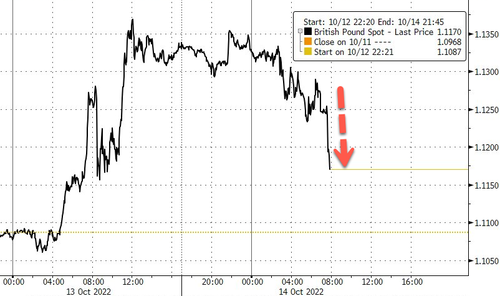
* * *
Update (0735ET):
Liz Truss sacked chancellor Kwasi Kwarteng after he recently unveiled plans for £45 billion worth of unfunded tax cuts that sparked financial armageddon and forced the Bank of England to restart buying bonds as the pound and gilt markets were thrown into turmoil.
Per BBC: Kwasi Kwarteng out as UK chancellor after mini-budget sparked financial turmoil and revolt from Conservative MPs
Kwarteng was only on the job for six weeks. His sacking makes him the shortest-servicing chancellor since 1970, according to The Guardian.
Former LBC presenter Matthew Stadlen notes the sacking of Kwarteng “isn’t a recipe for economic stability.”
Truss’ upcoming press conference is expected at 2 pm local time.
* * *
Just a few hours before the Bank of England ends its emergency bond-buying program, new reports indicate Prime Minister Liz Truss will hold a press conference later today in what could be one of the most significant political U-turns in decades. There are also reports that Chancellor of the Exchequer Kwasi Kwarteng will be sacked.
Bloomberg said Truss would reverse parts of her economic strategy in an upcoming news conference, following weeks of market turmoil in the pound and gilt markets after announcing £45 billion worth of unfunded tax cuts.
Daily Telegraph’s Ben Riley-Smith explained more about the upcoming news conference and historic reversal in a tweet:
Corporation Tax will **rise** to 25% from 19% this April, Liz Truss will announce at 2pm press conference today.
A huge climb down. Sticking to Rishi Sunak’s original plan. Removes central plank of her leadership bid.
Chancellor of the Exchequer Kwasi Kwarteng cut his International Monetary Fund (IMF) meetings short and landed in London Friday morning.
As Kwarteng arrived in London, Steven Swinford, a political editor at the Times, said, “Kwarteng is being sacked as Chancellor as Liz Truss prepares to reverse the mini-Budget.” He said it wasn’t clear who would replace him.
FT’s Henry Manc pointed out that Kwarteng has only been in office for 39 days — 25 fewer than his predecessor Nadhim Zahawi.
Here’s a list of chancellors and how long they spent in the office. Kwarteng is likely to be the shortest in the post-war era.
Some are saying Nadhim Zahawi or Sajid Javid could be Kwarteng’s replacement.
Torsten Bell, chief executive of the Resolution Foundation, explained why the U-turn is necessary right now:
UK government bonds continue a rally; the pound swung up and down on reports of Truss’ reversal plans and the sacking of Kwarteng.

Truss’ announcement later today and what appears to be the sacking of Kwarteng comes as an attempt to restore market confidence amid turmoil in the pound and gilt markets … but the question: Will it be enough?
END
SWITZERLAND/USA
Another $6.30 billion sent to SNB as their weak child, Credit Suisse is in trouble
(zerohedge)
Cue Dollar Squeeze Panic: Fed Sends A Record $6.3 Billion To Switzerland Via Swap Line
FRIDAY, OCT 14, 2022 – 01:42 PM
BofA Chief Investment Strategist Michael Hartnett (whose latest weekly note we will dissect shortly) has a favorite saying for when critical phase (to avoid the most hated word in the world “paradigm”) shifts take place in the market, one which may be the only word a trader in this day and age needs (or rather hopes for): “Markets stop panicking when central banks start panicking.”
So in what may be the best news to shellshocked bulls after the worst September and worst Q3 in generations, in a harrowing year for markets, and on a Friday which is set to reverse much of yesterday’s historic intraday reversal, the 5th biggest on record, central banks are starting to panic more with every passing day. First it was the BOJ, then the BOE and now, for the second week in a row, it’s Switzerland’s turn.
Recall that three weeks ago after the (first) panicked pivot by the BOE, when global markets were in freefall, we said that markets desperately needed some words of encouragement from the Fed, or failing that – and with the dollar soaring to new all time highs every day – the Fed had to make some pre-emptive announcement on USD Fx swap lines, if only to reassure global markets that amid this historic, US dollar short squeeze, at least someone can and will print as many as are needed to avoid systemic collapse.
So fast forward two weeks to October 5, when there still hasn’t been any formal announcement from the Fed, but every so quietly – and just as we expected – the Fed shuttled $3.1 billion to the Swiss National Bank to cover an emergency dollar shortfall.
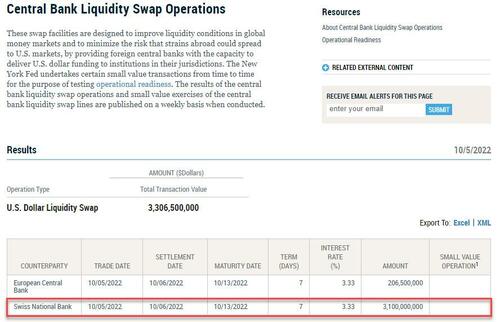
Remarkably, this was the first time the Fed sent dollars to the SNB this year, and the first time the Fed used the swap line in size (besides a token amount to the ECB every now and then)!
But it certainly won’t be the last time – as we have warned, expect far wider use of Fed swap line usage as the world chokes on the global dollar shortage – and sure enough overnight the Fed announced that as of Thursday it doubled the size of its USD swap with the world’s most pristine economy and its central bank, the Swiss National Bank, sending some $6.27 billion to avoid an emergency funding crunch.
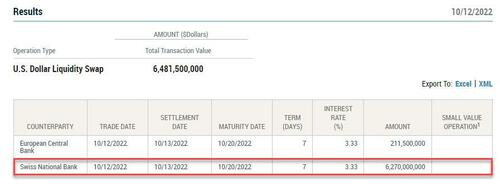
Remarkably, this was only the second time the Fed sent dollars to the SNB this year, and was also the largest single USD swap transfer in history!

The next logical question obviously is: why does Switzerland have a financial institution needing a record $6.3 billion in cheap (3.33%) overnight funding for the second week in a row. We don’t know the answer, but have a pretty good idea of who the culprit may be courtesy of Goldman which earlier this week issued the following note:
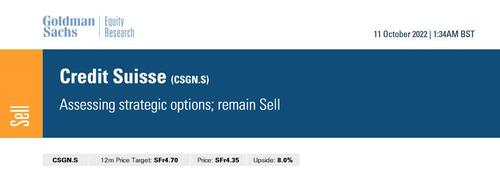
And speaking of the coming crisis, recall what we said at the start of September: the coming Fed pivot will have nothing to do with whether the Fed hits or doesn’t hit its inflation target, and everything to do with the devastation unleashed by the soaring dollar (a record margin call to the tune of some $20 trillion) on the rest of the world.
And speaking of the coming crisis, recall what we said at the start of September: the coming Fed pivot will have nothing to do with whether the Fed hits or doesn’t hit its inflation target, and everything to do with the devastation unleashed by the soaring dollar (a record margin call to the tune of some $20 trillion) on the rest of the world.
Today, none other than Bob Michele, the outspoken chief investment officer of J.P. Morgan Asset Management, told everyone that we were right: as paraphrased by Bloomberg, Bob said “the relentless dollar could forge a path to the next market upheaval.”
Michele has been in de-risking mode, sitting on a pile of cash which is near the highest level he has held in 10 years. And he is long the dollar. While a market crisis sparked by the greenback is not his base case, it’s a tail risk that he is monitoring closely.
Here’s how it could happen: Foreigners have snapped up dollar-denominated assets for higher yields, safety, and a brighter earnings outlook than most markets. A big chunk of those purchases are hedged back into local currencies such as the euro and the yen through the derivatives market, and it involves shorting the dollar. When the contracts roll, investors have to pay up if the dollar moves higher. That means they may have to sell assets elsewhere to cover the loss.
“I get concerned that a much stronger dollar will create a lot of pressure, particularly in hedging US dollar assets back to local currencies,” Michele said in an interview. “When the central bank steps on the brakes, something goes through the windshield. The cost of financing has gone up and it will create tension in the system.”
The market probably saw some of that pressure already: as we noted at the time, investment-grade credit spreads spiked close to 20 basis points toward the end of September. That’s coincidental with a lot of currency hedges rolling over at the end of the third quarter, he said — and it may be just “the tip of an iceberg.”
So far so good: and where we agree especially with Michele is what he thinks happens next: as Bloomberg writes, “the central bank will be so committed to combating inflation that it will keep raising rates and won’t pause or reverse course unless something really bad happens to markets or the economy, or both. If policy makers pause in response to market functionality, there has to be such a shock to the system that it creates potential insolvencies. And a rising dollar might do just that.”
And the fact that the Fed is already quietly shuttling billions of dollars to various central banks to plug dollar overnight funding holes, confirms that the rising dollar has already done just that. One look at the meltup in FRA-OIS is enough confirmation.

As for what happens next, we suggest that you i) quietly panic if you are still short USD, which so many since at last check (which was March 2020) JPMorgan calculated that the global dollar short was $12 trillion, some 60% of US GDP, a number which has conservatively grown to about $20 trillion as of today…
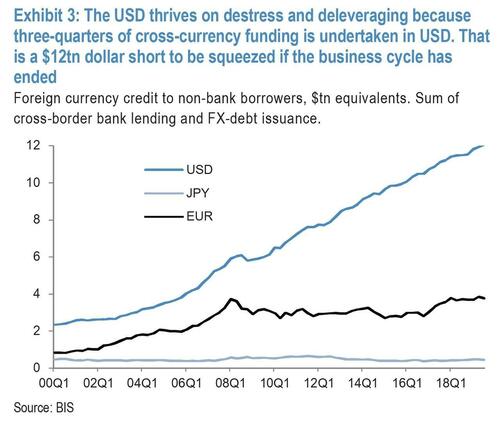
… and ii) keep a very close eye on this particular hotel.

EU/
Europe’s fuel supply fears worsening as now a major refinery malfunctions
(Paraskova/OilPrice.com )
Europe’s Fuel Supply Fears Worsen As Major Refinery Malfunctions
FRIDAY, OCT 14, 2022 – 03:30 AM
Authored by Tsvetana Paraskova via OilPrice.com,
The biggest refinery in Europe, Shell’s Pernis in the Netherlands, suffered a malfunction late on Wednesday, which could exacerbate an already worsening fuel supply situation in northwest Europe due to the strikes in France.

Shell Pernis said late on Wednesday that “Due to a malfunction on one of our installations, we are forced to flare.”
Shell is investigating the cause of the malfunction and is doing everything it can to solve the problem as soon as possible, and to limit the nuisance for the residents in the vicinity of the refinery near Rotterdam, the company said.
Governments have been informed about the malfunction at Europe’s largest refinery, Shell said in a statement carried by Bloomberg, but didn’t go into details about potential losses of fuel supply.
Fuel supply is already tight in Europe amid an ongoing strike at most of France’s refineries, and if the Dutch refinery malfunction leads to further supply losses, the European diesel market will find itself even shorter on supply, less than four months before the EU embargo on imports of Russian fuels by sea.
France’s fuel distribution continues to be disrupted by the ongoing strikes at refineries, with no end in sight to the industrial action that has left more than 60% of French refining capacity offline. Earlier this week, France said that it would requisition essential workers to staff Exxon’s French oil depot, and threatened to do the same for Total’s French refineries if talks failed to progress. But workers at Total’s Donges refinery decided on Tuesday to strike beginning on Wednesday, French union CGT said.
French ministers said today that TotalEnergies should raise the salaries of the workers, who have been on strike for two weeks now.
“If one knows the profits which they made … companies which have the capacity have a duty to raise wages and Total is one of them,” French Finance Minister Bruno Le Maire told local radio, as quoted by Reuters.
Energy Minister Agnes Pannier-Runacher on Thursday called on TotalEnergies to raise wages, saying that the company can afford to do so, and that “everyone must return to the negotiating table.”
END
EU leader, Borrell, warns of “black swans” everywhere!
(zerohedge)
“This Is A Perfect Storm” – EU Leader Warns Of “Black Swans” Everywhere, Says ‘Propaganda Is Our Battlefield’
FRIDAY, OCT 14, 2022 – 04:15 AM
“This is a perfect storm,” exclaims European Commission Vice President Josep Borrell in his opening speech to EU Ambassadors this week.
Having noted previously his warnings to The Fed that it is “bringing us to a world recession,” Borrell went considerably further in a surprisingly frank and plain-speaking address.
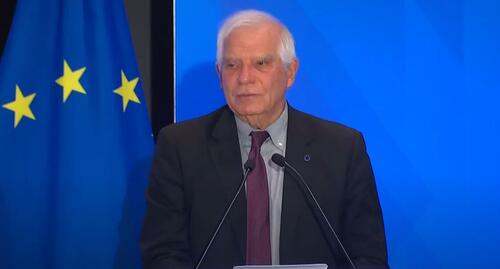
He began by warning that “the world we are facing is a world of radical uncertainty.”
The speed and scope of change is exceptional. We should not try to deny it. We should not try to resist it. It would be a futile effort. We have to accept it and to adapt [to] it, prioritising flexibility and resilience.
But uncertainty is the rule. Events that one could imagine that they will never happen, they are happening one after the other.
At this pace, the black swan will be the majority. It will not be white swans – all of them will be black – because one after the other, things have happened that had a very low probability of happening, nevertheless they happened, and they had a strong impact and certainly they happened.
The EC VP then goes on to try and summarize the extent of the European crisis and how they got there, admitting that they were entirely dependent on China (trade), Russia (energy), and US (security)…
I think that we Europeans are facing a situation in which we suffer the consequences of a process that has been lasting for years in which we have decoupled the sources of our prosperity from the sources of our security. This is a sentence to provide the headline, and I am taking that from Olivier Schmitt, who has been developing this thesis – I think – quite well.
Our prosperity has been based on cheap energy coming from Russia.
Russian gas – cheap and supposedly affordable, secure, and stable. It has been proved not [to be] the case.
And the access to the big China market, for exports and imports, for technological transfers, for investments, for having cheap goods.
I think that the Chinese workers with their low salaries have done much better and much more to contain inflation than all the Central Banks together.
So, our prosperity was based on China and Russia – energy and market.
Clearly, today, we have to find new ways for energy from inside the European Union, as much as we can, because we should not change one dependency for another. The best energy is the one that you produce at home. That will produce a strong restructuring of our economy – that is for sure. People are not aware of that but the fact that Russia and China are no longer the ones that [they] were for our economic development will require a strong restructuring of our economy.
The access to China is becoming more and more difficult. The adjustment will be tough, and this will create political problems.
On the other hand, we delegated our security to the United States. While the cooperation with the Biden Administration is excellent, and the transatlantic relationship has never been as good as it is today – [including] our cooperation with the United States and my friend Tony [Anthony] Blinken [US Secretary of State]: we are in a fantastic relationship and cooperating a lot; who knows what will happen two years from now, or even in November?
What would have happened if, instead of [Joe] Biden, it would have been [Donald] Trump or someone like him in the White House? What would have been the answer of the United States to the war in Ukraine? What would have been our answer in a different situation?
But, he admits, that can no longer be the case…
These are some questions that we have to ask ourselves. And the answer for me is clear: we need to shoulder more responsibilities ourselves. We have to take a bigger part of our responsibility in securing security.
You – the United States – take care of our security.
You – China and Russia – provided the basis of our prosperity.
This is a world that is no longer there.
So, we have a difficult cocktail – internal and external – and the old recipes do not work anymore. We have mounting security challenges and our internal cohesion is under threat.
Finally, his solution to all this is simple: more propaganda…
Communication is our battlefield: we fight in communication.
We provide you with materials and I have the feeling that you do not transmit the message strongly enough.
I need my delegations to step up on social media, on TV, in debates.
Retweet our messages, our [European] External Action Service materials. Certainly, my blog, which is the everyday “consigna”…
I need you to be much more engaged in this battle of narratives. It is not something secondary. It is not just winning the wars by sending tanks, missiles, and troops. It is a big battle: who is going to win the spirits and the souls of people?
…
Our fight is to try to explain that democracy, freedom, political freedom is not something that can be exchanged by economic prosperity or social cohesion. Both things have to go together.
Otherwise, our model will perish, will not be able to survive in this world.
So, the EU is planning to jawbone/propagandize its way out of dependence on China for its economic growth (internal cross-border trade?), Russia for cheap energy (by becoming more reliant on US?), and US for security (Macron’s European army rejuvenated?).
As Borrell noted at the very start of his speech: this is a perfect storm indeed… and winter is coming
end
5. RUSSIAN AND MIDDLE EASTERN AFFAIRS
RUSSIA/UKRAINE/
Russian thermal power plant on fire after a direct hit. Ukraine denies it was them stating it was an errant Russian missile
If it is Ukrainian, then this is a serious escalation
(zerohedge)
Russian Thermal Power Plant On Fire After Reported Cross-Border Missile Attack
FRIDAY, OCT 14, 2022 – 02:20 PM
Belgorod, a Russian city which lies just north of the Ukrainian border not far from Kharkiv, has reportedly come under repeat fire from Ukraine forces in the last 24 hours. “The governor of a Russian border region accused Ukraine of shelling an apartment block there on Thursday but a Kyiv official said a stray Russian missile was to blame, in only one of a series of apparent strikes on Russian border towns,” Reuters reported Thursday, citing that “a school had been damaged in a village close to the border, and that the top floor of an apartment block had been struck in the city of Belgorod.”
While this is not the first instance of Ukrainian cross-border strikes (Kiev’s denial of responsibility notwithstanding), on Friday things have escalated with a reported nighttime missile strike on Belgorod’s thermal power plant, with further reports that it has plunged much of the city into darkness.

If this is indeed the result of a confirmed Ukrainian missile strike, it will mark a massive escalation amid the past week of multiple serious escalations, including the Kerch Strait bridge attack, given it’s a major hit on Russian soil.
Does this marks the start of the Ukrainian side hitting back at Russia’s energy infrastructure? Early in the week President Vladimir Putin announced the start of aggressive targeting of Ukraine’s energy grid.
An additional question remains: are Ukraine forces utilizing longer-range missiles transferred from Western allies? If so, this could trigger a huge response from Moscow, despite Putin in an earlier Friday speech signaling he isn’t planning further large-scale airstrikes across Ukraine for the time being.
A reported missile strike and moment of impact against the power plant:
To review of Russia’s ramped up attacks Monday through Tuesday on Ukraine’s energy infrastructure, The New York Times wrote:
Electricity was out across wide swaths of Ukraine on Monday, as President Vladimir V. Putin said that Russia had deliberately targeted Ukraine’s energy system in a series of strikes across the country in response to an attack on a critical bridge linking Russia and Crimea that Mr. Putin blamed on Ukraine.
The flurry of missile strikes rained down on more than 10 cities from Kharkiv to Kyiv, a move that Ukrainian officials said was aimed crippling the nation’s energy system as winter nears. Ukraine’s emergency services said that five regions — Lviv, Poltava, Sumy, Kharkiv and Ternopil — were without power. Internet and heating outages also were reported.
Below: more footage of Belgorod thermal power station on fire after a reported attack…
Ukrainian sources and media are denying that this was the result of a Ukrainian attack, instead claiming that Russia’s own ‘errant’ missiles are to blame.
Many towns and cities across Ukraine have reportedly remained without heat as well following the early in the week Russian strikes, at a moment temperatures have begun dropping ahead of colder, winter months.

RUSSIA/UKRAINE/THE WEST
A must read
Pepe Escobar has got it right
(Pepe Escobar)
Escobar: The Thin Red Line – NATO Can’t Afford To Lose Kabul & Kiev
FRIDAY, OCT 14, 2022 – 02:00 AM
Let’s start with Pipelineistan. Nearly seven years ago, I showed how Syria was the ultimate Pipelineistan war.

Damascus had rejected the – American – plan for a Qatar-Turkey gas pipeline, to the benefit of Iran-Iraq-Syria (for which a memorandum of understanding was signed).
What followed was a vicious, concerted “Assad must go” campaign: proxy war as the road to regime change. The toxic dial went exponentially up with the instrumentalization of ISIS – yet another chapter of the war of terror (italics mine). Russia blocked ISIS, thus preventing regime change in Damascus. The Empire of Chaos-favored pipeline bit the dust.
Now the Empire finally exacted payback, blowing up existing pipelines – Nord Stream (NS) and Nord Steam 2 (NS2) – carrying or about to carry Russian gas to a key imperial economic competitor: the EU.
We all know by now that Line B of NS2 has not been bombed, or even punctured, and it’s ready to go. Repairing the other three – punctured – lines would not be a problem: a matter of two months, according to naval engineers. Steel on the Nord Streams is thicker than on modern ships. Gazprom has offered to repair them – as long as Europeans behave like grown-ups and accept strict security conditions.
We all know that’s not going to happen. None of the above is discussed across NATOstan media. That means that Plan A by the usual suspects remains in place: creating a contrived natural gas shortage, leading to the de-industrialization of Europe, all part of the Great Reset, rebranded “The Great Narrative”.
Meanwhile, the EU Muppet Show is discussing the ninth sanction package against Russia. Sweden refuses to share with Russia the results of the dodgy intra-NATO “investigation” of itself on who blew up the Nord Streams.
At Russian Energy Week, President Putin summarized the stark facts.
- Europe blames Russia for the reliability of its energy supplies even though it was receiving the entire volume it bought under fixed contracts.
- The “orchestrators of the Nord Stream terrorist attacks are those who profit from them”.
- Repairing Nord Stream strings “would only make sense in the event of continued operation and security”.
- Buying gas on the spot market will cause a €300 billion loss for Europe.
- The rise in energy prices is not due to the Special Military Operation (SMO), but to the West’s own policies.
Yet the Dead Can Dance show must go on. As the EU forbids itself to buy Russian energy, the Brussels Eurocracy skyrockets their debt to the financial casino. The imperial masters laugh all the way to the bank with this form of collectivism – as they continue to profit from using financial markets to pillage and plunder whole nations.
Which bring us to the clincher: the Straussian/neo-con psychos controlling Washington’s foreign policy eventually might – and the operative word is “might” – stop weaponizing Kiev and start negotiations with Moscow only after their main industrial competitors in Europe go bankrupt.
But even that would not be enough – because one of NATO’s key “invisible” mandates is to capitalize, whatever means necessary, on food resources across the Pontic-Caspian steppe: we’re talking about 1 million km2 of food production from Bulgaria all the way to Russia.
Judo in Kharkov
The SMO has swiftly transitioned into a “soft” CTO (Counter-Terrorist Operation) even without an official announcement. The no-nonsense approach of the new overall commander with full carte blanche from the Kremlin, General Surovikin, a.k.a. “Armageddon”, speaks for itself.
There are absolutely no indicators whatsoever pointing to a Russian defeat anywhere along the over 1,000 km-long frontline. The spun-to-death withdrawal from Kharkov may have been a masterstroke: the first stage of a judo move that, cloaked in legality, fully developed after the terrorist bombing of Krymskiy Most – the Crimea Bridge.
Let’s look at the retreat from Kharkov as a trap – as in Moscow graphically demonstrating “weakness”. That led the Kiev forces – actually their NATO handlers – to gloat about Russia “fleeing”, abandon all caution, and go for broke, even embarking on a terror spiral, from the assassination of Darya Dugina to the attempted destruction of Krymskiy Most.
In terms of Global South public opinion, it’s already established that General Armageddon’s Daily Morning Missile Show is a legal (italics mine) response to a terrorist state. Putin may have sacrificed, for a while, a piece on the chessboard – Kharkov: after all, the SMO mandate is not to hold terrain, but to demilitarize Ukraine.
Moscow even won post-Kharkov: all the Ukrainian military equipment accumulated in the area was thrown into offensives, just for the Russian Army to merrily engage in non-stop target practice.
And then there’s the real clincher: Kharkov set in motion a series of moves that allowed Putin to eventually go for checkmate, via the missile-heavy “soft” CTO, reducing the collective West to a bunch of headless chickens.
In parallel, the usual suspects continue to relentlessly spin their new nuclear “narrative”. Foreign Minister Lavrov has been forced to repeat ad nauseam that according to Russian nuclear doctrine, a strike may only happen in response to an attack “which endangers the entire existence of the Russian Federation.”
The aim of the D.C. psycho killers – in their wild wet dreams – is to provoke Moscow into using tactical nuclear weapons in the battlefield. That was another vector in rushing the timing of the Crimea Bridge terror attack: after all British intel plans had been swirling for months. That all came to nought.
The hysterical Straussian/neocon propaganda machine is frantically, pre-emptively, blaming Putin: he’s “cornered”, he’s “losing”, he’s “getting desperate” so he’ll launch a nuclear strike.
It’s no wonder the Doomsday Clock set up by the Bulletin of the Atomic Scientists in 1947 is now placed at only 100 seconds from midnight. Right on “Doom’s doorstep”.
This is where a bunch of American psychos is leading us.
Life at Doom’s doorstep
As the Empire of Chaos, Lies and Plunder is petrified by the startling Double Fail of a massive economic/military attack, Moscow is systematically preparing for the next military offensive. As it stands, it’s clear that the Anglo-American axis will not negotiate. It has not even tried for the past 8 years, and it’s not about to change course, even incited by an angelic chorus ranging from Elon Musk to Pope Francis.
Instead of going Full Timur, accumulating a pyramid of Ukrainian skulls, Putin has summoned eons of Taoist patience to avoid military solutions. Terror on the Crimea Bridge may have been a game-changer. But the velvet gloves are not totally off: General Armageddon’s daily aerial routine may still be seen as a – relatively polite – warning. Even in his latest landmark speech, which contained a savage indictment of the West, Putin made clear he’s always open for negotiations.
Yet by now, Putin and the Security Council know why the Americans simply can’t negotiate. Ukraine may be just a pawn in their game, but it’s still one of Eurasia’s key geopolitical nodes: whoever controls it, enjoys extra strategic depth.
The Russians are very much aware that the usual suspects are obsessed with blowing up the complex process of Eurasia integration – starting with China’s BRI. No wonder important instances of power in Beijing are “uneasy” with the war. Because that’s very bad for business between China and Europe via several trans-Eurasian corridors.
Putin and the Russian Security Council also know that NATO abandoned Afghanistan – an absolutely miserable failure – to place all their chips on Ukraine. So losing both Kabul and Kiev will be the ultimate mortal blow: that means abandoning the 21st Eurasian Century to the Russia-China-Iran strategic partnership.
Sabotage – from the Nord Streams to Krymskiy Most – gives away the desperation game. NATO’s arsenals are virtually empty. What’s left is a war of terror: the Syrianization, actually ISIS-zation of the battlefield. Managed by braindead NATO, acted on the terrain by a cannon fodder horde sprinkled with mercenaries from at least 34 nations.
So Moscow may be forced to go all the way – as the Totally Unplugged Dmitry Medvedev revealed: now this is about eliminating a terrorist regime, totally dismantle its politico-security apparatus and then facilitate the emergence of a different entity. And if NATO still blocks it, direct clash will be inevitable.
NATO’s thin red line is they can’t afford to lose both Kabul and Kiev.
Yet it took two acts of terror – on Pipelineistan and on Crimea – to imprint a much starker, burning red line: Russia will not allow the Empire to control Ukraine, whatever it takes.
That’s intrinsically linked to the future of the Greater Eurasia Partnership.
Welcome to life at Doom’s doorstep.
END
RUSSIA/EUROPE/FRANCE
Macron outlines stance on use of nukes against Russia — RT World News
| Robert Hryniak | 9:59 AM (13 minutes ago) |   | |
to |
Macron is really being truthful for all the criticism he is getting over this.
The combined West is in a very deep trouble–it desperately needs, US included, an off-ramp. The economic fallout has only begin and some people are seeing the light and they do not like what they see. And quite contrary to the balderdash of Russia using tactical nukes in the Ukraine it is just that, balderdash. This past week has clearly shown that Russia can if it so chooses to send Ukraine back to the Stone Age by destroying the electrical grid by hitting transformers and not power plants.
It is safe to assume (indicators are there) that Russia and the US are talking behind the scene, but the US has no serious leverage over Russia in any field, at this time. And the white flags are getting ready. Sadly for the US, it doesn’t have anymore a competent diplomacy and is not ready, yet, to start listening. The likes of Sullivan and others are hindering a rapid peaceful conclusion. But the US military is looking to get off, sooner than later. However, even with a deadbeat administration do expect an exit that will leave others hanging in the wind, just like in Afghanistan. It just will be a question of how it is spun for media.
Macron is aware of certain discussions and is making an early exit to stay relevant and not take flak while leaving others to carry the heat.
Creditability of this current administration drops lower by the day. There are even rumors that Treasury failed their audit with a trillion gone missing.
https://www.rt.com/news/564631-macron-nukes-russia-ukraine/
END
6.GLOBAL ISSUES////COVID ISSUES/VACCINE ISSUES
Vaccine//Covid issues:
We warned you of this!
(zerohedge)
“Severe Adverse Effects”: Doctors Warn Pfizer’s Paxlovid Can Interact With Common Medications
THURSDAY, OCT 13, 2022 – 06:00 PM
Pfizer’s Covid-19 treatment that’s definitely not a profitable Ivermectin knockoff (despite both functioning as protease inhibitors) turns out to pose an increased risk of severe illness in Covid-19 patients who have a history of cardiovascular disease.

Paxlovid – Pfizer’s Covid medication notably taken by Joe Biden, Jill Biden and Dr. Anthony Fauci – before all three had “rare” (and then not-so rare) cases of “rebound Covid” – can have dangerous interactions with some of the most common medications for cardiovascular disease, including various statins and heart failure therapies, according to a Wednesday paper published in the Journal of the American College of Cardiology.
In it, researchers found that the combination of nirmatrelvir and ritonavir, two antivirals which comprise Pfizer’s Paxlovid, can interact with a number of commonly prescribed cardiovascular medications. According to the paper, Ritonavir, which was approved to treat HIV in 1996, impacts the CYP450 pathway that’s involved in metabolizing a number of medications—as well as the P-glycoprotein drug efflux pump, the Epoch Times reports.
“Co-administration of [Paxlovid] with medications commonly used to manage cardiovascular conditions can potentially cause significant drug-drug interactions and may lead to severe adverse effects,” reads an abstract. “It is crucial to be aware of such interactions and take appropriate measures to avoid them.”
The paper also notes that interactions between Paxlovid and some blood thinners can cause a higher risk of bleeding, while interactions between Paxlovid and cholesterol medications such as Statins can be toxic, CNN reports, citing the paper.
“Awareness of the presence of drug-drug interactions of Paxlovid with common cardiovascular drugs is key. System-level interventions by integrating drug-drug interactions into electronic medical records could help avoid related adverse events,” said lead author Saru Ganatra, MD, who works at Lahey Hospital and Medical Center in Burlington, Massachusetts.
“Paxlovid could be incorporated into an order set, which allows physicians, whether it be primary care physicians or cardiology providers, to consciously rule out any contraindications to the co-administration of Paxlovid,” Ganatra continued, adding that there needs to be “consultation” with healthcare providers and pharmacists to avoid interactions.
As the Epoch Times notes, a U.S. Food and Drug Administration (FDA) fact sheet (pdf) of Paxlovid for health care providers goes into detail about possible drug interactions that can prompt life-threatening reactions.
The medications include but aren’t limited to anti-seizure medications, drugs for irregular heart rhythms, drugs for high blood pressure and high cholesterol, antidepressants and anti-anxiety medications, antidepressants and anti-anxiety medications, steroids, HIV treatments, blood thinners, and erectile dysfunction medications.
“The importance of medication reconciliation before initiation of nirmatrelvir/ritonavir cannot be overemphasized to avoid serious drug-drug interactions,” the authors of the paper wrote Wednesday, referring to Paxlovid.
end
We warned you on this: no data available to take the bivalent booster
(Pearson/EpochTimes)
No Data To Recommend ‘Preferential’ Omicron Booster Jabs: WHO Panel
THURSDAY, OCT 13, 2022 – 07:00 PM
Authored by Caden Pearson via The Epoch Times (emphasis ours),
There isn’t enough data to recommend COVID-19 booster jabs for Omicron subvariants over the original virus, the World Health Organization’s (WHO’s) panel of vaccine experts said on Tuesday.

Four variant-containing mRNA vaccines that either include bivalent Omicron subvariants BA.1 or BA.4–5 in combination with the “ancestral virus” have been authorized for use as booster doses.
The Strategic Advisory Group of Experts on Immunization (SAGE) said in a statement that it reviewed the “safety and immunogenicity” of bivalent vaccines when given as a booster in adults compared to the results of a clinical trial from another kind of vaccine.
Bivalent vaccines are designed to target two different strains of the virus. They contain both the mRNA of the original virus strain and that of the Omicron variant, which accounts for almost all virus samples collected in the last 30 days.
The bivalent jabs targeting the dominant subvariant might only offer a “minute incremental benefit,” according to SAGE, which determined that the highest public health priority is to achieve high rates of a primary dose of vaccine containing the “ancestral strain” of the virus.
“[C]urrently available data are not sufficient to support the issuance of any preferential recommendation for bivalent variant-containing vaccine boosters over ancestral-virus-only boosters,” SAGE added.
Either a monovalent jab designed for the original strain or a bivalent variant-containing shot can be used as boosters, according to the WHO panel.
The WHO panel said these shots given as boosters four to six months after the last dose provide “improved protection against currently circulating SARS-CoV-2.”
“The bulk of the benefit is from the provision of in particular the first booster dose, irrespective of whether it is a monovalent or bivalent vaccine,” SAGE said.
‘Modest Effect’ Only Seen in Labs, Not Clinical Settings
The variant-containing vaccines neutralize the virus to the same extent as ancestral shots but have a “slightly superior neutralization of the Omicron variant, according to SAGE Executive Secretary Joachim Hombach.
“It’s a relatively modest effect which we can see in the laboratory,” he said, adding that they cannot “relate these laboratory measures with an increase in clinical protection” because there’s no data on effectiveness.
Read more here…
end
The criminal action of Pfizer trying to silence Alex Berenson
(Alex Berenson(
Pfizer Board Member Scott Gottlieb Secretly Pressed Twitter To Censor Alex Berenson
FRIDAY, OCT 14, 2022 – 08:45 AM
Authored by Alex Berenson via Unreported Truths,
On August 24, 2021, Dr. Scott Gottlieb sent an urgent email about my reporting to a contact at Twitter.
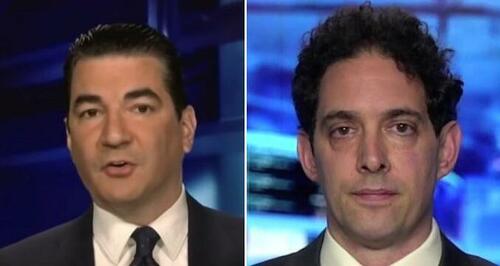
Gottlieb is the former commissioner of the Food and Drug Administration, a close colleague of many federal officials – and a senior board member of Pfizer, which has made $70 billion selling mRNA vaccines.
In his email, Gottlieb forwarded an article I had written about Dr. Anthony Fauci on this Substack and complained, “This is whats promoted on Twitter. This is why Tony needs a security detail.”
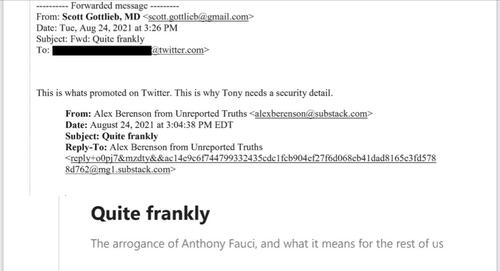
Thus Gottlieb — whom Pfizer pays almost $400,000 a year to serve on its board, including its highest-level “executive committee” — began the final act in a secret months-long conspiracy to suppress my basic American right to free speech.
The conspirators included corporate, private, and federal actors.
They wanted to block my reporting about the failure of the mRNA Covid vaccines. They wanted to suppress debate about the necessity for vaccine boosters or mandates.
They wanted Twitter, the most important global platform for journalism, to ban me, even though Twitter had repeatedly found my posts did not violate its rules. They wanted to soil my reputation as a reporter and damage me and my family financially.
For a time, they succeeded.
It should go without saying that my Substack piece about “Tony” did not threaten or harass him in any way. It merely called him “arrogant” and a “skilled courtier” and mocked his infamous comment that criticizing him was “attacking science.”
No matter.
Four days after Gottlieb sent that email – and just 24 hours after he had a secret conference call with Twitter employees about me – Twitter permanently banned me, claiming I had violated its rules on Covid misinformation.
Even then, Gottlieb was not done trying to silence me. He pursued me after the ban, quickly informing Twitter when he learned that I had taken over another account to provide a new avenue for my reporting.
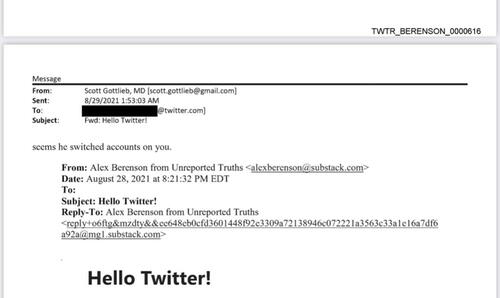
For a time, the conspirators must have believed they’d won.
But like the mRNA vaccines they have tried to force on people around the world, their success lasted only a few months and has now turned into an ugly, messy failure.
I filed a federal lawsuit over the ban against Twitter in San Francisco in December. In July Twitter settled the suit, restored my account, and admitted it had been wrong to suspend me.
Now, thanks to internal Twitter documents and emails that I have obtained as part of that lawsuit, the full extent of the conspiracy to censor me is emerging.
(Incredibly, on Saturday, Oct. 8, Twitter locked my account and barred me from making new posts, again for supposedly breaking its Covid misinformation rules. I believe Twitter simply wants to punish me because it knows this article will prove embarrassing to it, and at a minimum wishes to keep me from breaking this news on its platform.)
—
The conspiracy to censor me appears to have begun in earnest in April 2021, as I raised questions about the safety and efficacy of the mRNA Covid vaccines.
At its heart was Gottlieb’s colleague and friend Andy Slavitt. Slavitt and Gottlieb know each other well. In April 2020, they co-authored a letter to Congress demanding expanded Covid contact tracing efforts. They also appeared together on interviews, including on Slavitt’s own “In The Bubble” podcast, which Pfizer sponsors.
From January through June 2021, Slavitt served as senior advisor to the Biden Administration’s Covid response team. On April 21, 2021, Slavitt and other Biden Administration officials spoke to Twitter officials to complain about vaccine “misinformation.”
Afterwards, a Twitter employee told other employees in a private discussion over Slack that the White House had “one really tough question about why Alex Berenson hasn’t been kicked off from the platform.” The employee distinguished the question from others White House officials had asked, which the employee called “pointed but fair.”
Another employee wrote in a different Slack discussion that Slavitt had attacked me directly, calling my reporting an obstacle to convincing the “persuadable public” to take Covid vaccines.
But Twitter did not want to take action against me.
Jack Dorsey, the company’s founder, had begun following me in May 2020, and a Twitter executive had repeatedly assured me that I was not violating any of its rules. Twitter employees confirmed that view to each other in private. “I’ve taken a close look at his account, and I don’t think any of it is violative,” a Twitter employee wrote following the White House meeting.
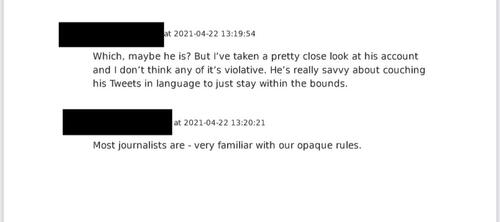
Nonetheless, under pressure from Slavitt, Twitter agreed to still another review of my account to try to find violations that would enable it to suspend me without breaking its terms of service:

Yet for almost three months after this “deep dive,” Twitter took no action against me.
Then, in July 2021, the censorship efforts took on a new urgency.
The reason was simple. The vaccines had begun to fail, much more quickly the public had been told to expect. In Israel, the first country to complete a mass vaccination campaign with Pfizer’s mRNA shot, infections soared. Hospitalizations and deaths rapidly followed.
The Biden Administration and Pfizer began preparing vaccinated people to take a third mRNA “booster” dose, despite a lack of clinical trial data on the safety or effectiveness of a booster. The administration also began to consider imposing politically divisive employment- and education-related vaccine mandates, despite earlier promises it would not.
So silencing vaccine skeptics became a top priority – for the White House and Pfizer. No one was more skeptical, or had a larger audience, than I did – as Slavitt had told Twitter in April.
Publicly, the conspirators did not focus on me. Instead, they spoke generically about their interest in combatting what they referred to as vaccine “misinformation,” and broadly encouraged Twitter and social media companies to do the same.
On July 16, Gottlieb told MSNBC, “I think the social media platforms do have an obligation to police the kind of misinformation that we’re seeing—things that are truly false—and we’ve seen them step in to do that,” he said.
On the same day, President Biden said social media companies were “killing people” by allowing dissenters to raise questions about the mRNA shots.
The pressure had immediate impact.
A few hours after Biden’s comment, Twitter locked me out of my account for the first time. On July 27, it gave me a third “strike,” and on July 30, a fourth – this time for a tweet that did nothing but accurately reflect the results of a Pfizer clinical trial.

Meanwhile, Slavitt – who was now outside the White House – continued to press Twitter to ban me.
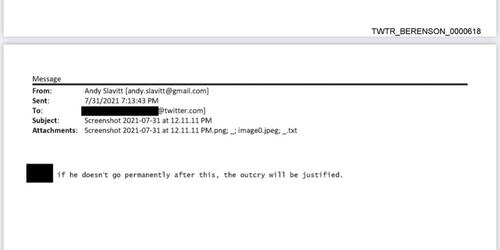
In a sign of just how closely Pfizer, Slavitt, and the Biden Administration were communicating, Pfizer chairman Albert Bourla appeared on a podcast with Slavitt on July 28, 2021 – the same day that Bourla traveled to the White House for a meeting that had been scheduled only one day before. The meeting was not publicly disclosed until the White House published its visitor logs months later.
Meanwhile, Gottlieb was also in touch with the Biden Administration.
Gottlieb is a Republican, but he spoke regularly to Democratic officials even before Biden’s inauguration. In December 2020, he told USA Today that he had “had a couple of discussions with the [Biden] transition team just to give them some advice… I’m available. I pick up the phone, I call people back, and I try to be helpful to whoever I can.”
Gottlieb remained in “pretty regular” contact with Slavitt and other Biden Administration officials throughout the winter and spring of 2021, according to a comment Slavitt made on his podcast on July 7, 2021.
Gottlieb had joined Pfizer’s board barely two years earlier, in June 2019, only three months after resigning as FDA commissioner. But he rapidly became a crucial member. He is the head of the board’s regulatory and compliance committee and one of seven members of the executive committee. He was an aggressive advocate for Pfizer’s mRNA shot, including signing a letter in August 2021 demanding that colleges and universities impose vaccine mandates on their students and staff.
Read more here…
end
| Chris Powell | 9:43 AM (6 minutes ago) |   | |
to me |
Scientists Find Antibodies That Neutralize All COVID Strains
By Joseph Mercola
The Epoch Times
Thursday, October 13, 2022
Previous monoclonal antibody treatments against COVID-19 have had mixed results against variants. However, new research uncovered two antibodies that work against all known strains of COVID-19.
STORY AT-A-GLANCE
Two antibodies have been uncovered that are so effective at neutralizing COVID-19 — and all of its variants — that they believe the antibodies could serve as an “effective substitute for vaccines”
The antibodies — TAU-1109 and TAU-2310 — bind to a different area of the spike protein than other antibodies, one that doesn’t undergo many mutations
TAU-1109 is 92% effective at neutralizing the omicron strain and 90% effective at neutralizing the delta strain
TAU-2310 has an efficacy rate of 84% at neutralizing omicron and a 97% efficacy rate against the delta variant
The researchers believe that with effective antibody treatment, “we will not have to provide booster doses to the entire population every time there is a new variant”
Researchers at Tel Aviv University revealed two antibodies that are so effective at neutralizing SARS-CoV-2 — and all of its variants — that they believe the antibodies could serve as an “effective substitute for vaccines.”1 One of the glaring failures surrounding COVID-19 shots is their lack of effectiveness against emerging COVID-19 strains.
By choosing the spike protein on which to base COVID-19 shots, scientists picked a protein that not only was known to be toxic to humans but was not the part of the virus that prompted the best immune response.
Spike protein mutates rapidly, which essentially destroys virtually any protection that the shot provides shortly after it’s given. The end result is a seemingly never-ending series of annual shots and boosters, which can only offer rapidly waning protection. If the Israeli researchers’ findings are verified and the antibodies turn out to be as effective as suspected, it could eliminate COVID-19 booster shots entirely.2
Previous Antibody Treatments Had Mixed Results
The U.S. Food and Drug Administration (FDA) has authorized multiple monoclonal antibody (mAb) cocktails for the treatment of COVID-19. However, as variants emerged, their effectiveness varied, with some becoming ineffective and others retaining their activity.
“This indicates that some antibodies elicited by infection are more variation-sensitive than others, and that antibody breadth of specificity, and not only potency, should be considered,” the researchers, from the department of clinical microbiology and immunology at Tel Aviv University’s Sackler Faculty of Medicine,3 wrote in the journal Communications Biology.4
For instance, in January 2022, the FDA limited the use of two monoclonal antibody treatments — bamlanivimab and etesevimab, which are administered together, and REGEN-COV (casirivimab and imdevimab) — to patients infected with a variant known to be susceptible to them.5 The two antibody treatments mentioned had lost much of their effectiveness against the omicron variant, leading to the usage restriction in people infected with omicron.
On the other hand, in February 2022, the FDA issued an emergency use authorization (EUA) for a monoclonal antibody treatment known as bebtelovimab, which retained activity against the omicron variant.6 According to the FDA:7
“Bebtelovimab works by binding to the spike protein of the virus that causes COVID-19, similar to other monoclonal antibodies that have been authorized for the treatment of high-risk patients with mild to moderate COVID-19 and shown a benefit in reducing the risk of hospitalization or death.”
The way the antibodies bind to the spike protein may hold the key to their ultimate effectiveness against various strains. In previous research conducted in October 2020, lead study author Natalia Freund and colleagues isolated nine antibodies from people who recovered from the original COVID-19 strain in Israel. Freund stated in a news release:8
“In the previous study, we showed that the various antibodies that are formed in response to infection with the original virus are directed against different sites of the virus. The most effective antibodies were those that bound to the virus’s ‘spike’ protein, in the same place where the spike binds the cellular receptor ACE2.
Of course, we were not the only ones to isolate these antibodies, and the global health system made extensive use of them until the arrival of the different variants of the coronavirus, which in fact rendered most of those antibodies useless.”
Two Antibodies Neutralize All COVID-19 Strains
The featured study picks up where the October 2020 study left off, revealing two antibodies — TAU-1109 and TAU-2310 — that bind to a different area of the spike protein — one that doesn’t undergo many mutations — making them capable of neutralizing all known strains of COVID-19. According to Freund:9
“In the current study, we proved that two other antibodies, TAU-1109 and TAU-2310, which bind the viral spike protein in a different area from the region where most of the antibodies were concentrated until now (and were therefore less effective in neutralizing the original strain) are actually very effective in neutralizing the Delta and Omicron variants.”
Specifically, they found TAU-1109 is 92% effective at neutralizing the omicron strain and 90% effective at neutralizing the delta strain. TAU-2310 has an efficacy rate of 84% at neutralizing omicron and a 97% efficacy rate against the delta variant.10 The study was conducted in collaboration with the University of California at San Diego, where the two antibodies were sent for additional testing against live viruses in laboratory cultures.
The antibodies were also tested against pseudoviruses at Bar-Ilan University in the Galilee. “The results were identical and equally encouraging in both tests,” according to a news release.11 What’s interesting is that the mutating virus may have played a part in making the two antibodies so effective. Freund explained:12
“The infectivity of the virus increased with each variant because each time, it changed the amino acid sequence of the part of the spike protein that binds to the ACE2 receptor, thereby increasing its infectivity and at the same time evading the natural antibodies that were created following vaccinations.
In contrast, the antibodies TAU-1109 and TAU-2310 don’t bind to the ACE2 receptor binding site, but to another region of the spike protein – an area of the viral spike that for some reason does not undergo many mutations – and they are therefore effective in neutralizing more viral variants. These findings emerged as we tested all the known COVID strains to date.”
COVID Booster Shots Are Not the Answer
Freund believes that the antibodies are so effective they could ultimately replace COVID-19 booster shots. This is welcome news, as most protection gained from COVID-19 shots, including boosters, doesn’t last.
One study funded by the U.S. Centers for Disease Control and Prevention involved data from 10 states collected from August 26, 2021, to January 22, 2022, periods during which both the delta and omicron variants were circulating.13 Within two months of the second COVID-19 shot, protection against emergency department and urgent care visits related to COVID-19 was at 69%. This dropped to 37% after five months post-shot.
The low effectiveness five months after the initial shot series is what prompted officials to recommend a booster dose — and the third shot “boosted” effectiveness to 87%. This boost was short-lived, however. Within four to five months post-booster, protection against emergency department (ED) and urgent care (UC) visits decreased to 66%, then fell to just 31% after five months or more post-booster.14
Rather than admitting defeat, health officials are planning to hand out even more doses of their embarrassingly ineffective boosters with new so-called “updated” shots. On August 31, 2022, the FDA amended the EUAs of Moderna and Pfizer’s COVID-19 shots to authorize bivalent formulations to be used as booster doses at least two months after a previous booster or primary serious of the shots.
“The bivalent vaccines, which we will also refer to as “updated boosters,” contain two messenger RNA (mRNA) components of SARS-CoV-2 virus, one of the original strain of SARS-CoV-2 and the other one in common between the BA.4 and BA.5 lineages of the omicron variant of SARS-CoV-2,” the FDA stated.15
In addition to the strong possibility that protection against COVID-19 will once again rapidly disappear following the booster, there’s a real risk of serious adverse events from repeatedly artificially inflating antibodies in your body via repeated booster shots.
This tricks your body into thinking it’s always infected with COVID-19, a condition that can only lead to a “death zone,” accelerating the development of autoimmune conditions such as Parkinson’s, Kawasaki disease and multiple sclerosis, according to tech leader and COVID analyst Marc Girardot, who urged a retreat from the COVID shot “death zone” before it’s too late.16
With Antibody Treatment ‘We Will Not Have to’ Use ‘Boosters’
There may be a light at the end of the tunnel, as Freund is confident the “cross-neutralizing capabilities of antibodies naturally elicited during wild type SARS-CoV-2 infection” may end up providing an alternative to booster shots. She stated:17
“For reasons we still don’t yet fully understand, the level of antibodies against COVID-19 declines significantly after three months, which is why we see people getting infected again and again, even after being vaccinated three times.
In our view, targeted treatment with antibodies and their delivery to the body in high concentrations can serve as an effective substitute for repeated boosters, especially for at-risk populations and those with weakened immune systems.
COVID-19 infection can cause serious illness, and we know that providing antibodies in the first days following infection can stop the spread of the virus. It is therefore possible that by using effective antibody treatment, we will not have to provide booster doses to the entire population every time there is a new variant.”
Natural Immunity Is Key
This is encouraging, though not exactly surprising considering what’s known about natural immunity — the type earned by recovering from infection. A 2022 study published in the New England Journal of Medicine (NEJM)18 is just one example of research showing natural COVID-19 immunity is not only effective but lasts longer than the immunity that’s acquired from COVID-19 shots.19
What’s more, prior COVID-19 infection — i.e., natural immunity — offered better protection against symptomatic omicron infection more than one year later than three doses of COVID-19 shots did after one month.
To put it into numbers, a graph in the New England Journal of Medicine shows that previous infection was 54.9% effective against symptomatic omicron infection after more than 12 months, while three doses of Pfizer’s COVID-19 shot were only 44.7% effective a month later. The same held true for three doses of Moderna’s COVID-19 shot, which were only 41.2 % effective after one month, compared to 53.5% effectiveness for natural immunity more than a year later.20
Another one of the most talked-about reports showing the superiority of natural immunity involved data presented July 17, 2021, to the Israeli Health Ministry, which revealed that, of more than 7,700 COVID-19 cases reported, only 72 occurred in people who had previously had COVID-19 — a rate of less than 1%. In contrast, more than 3,000 cases — or approximately 40% — occurred in people who had received a COVID-19 shot.21
In other words, those who were vaccinated were nearly 700% more likely to develop COVID-19 than those who had natural immunity from a prior infection.22
Why is there a good chance you haven’t heard about this news? Repeated booster shots equate to ongoing dollar signs for Big Pharma and the health agencies and officials it controls. So it remains to be seen whether an antibody treatment that targets every COVID-19 variant effectively will ever see the light of day in hospitals and outpatient clinics.
—
Originally published October 13, 2022 on Mercola.com
GLOBAL ISSUES
Two troubling developments which will hasten the global food crisis
1. Russia to reject the Black Sea grain agreement
2. Government data from the uSA shows American farmers could export the least amount of wheat in a half century
(zerohedge)
These Two Troubling Developments Could Reignite Global Food Crisis Fears
FRIDAY, OCT 14, 2022 – 02:45 AM
Two troubling developments may reignite global food crisis fears. The first is Russia’s Geneva UN ambassador is prepared to reject a Black Sea grain agreement renewal that would disrupt Ukraine’s farm goods exports. The second is government data from the US that shows American farmers could export the least amount of wheat in half a century.
The most breaking development is a Reuters report on Gennady Gatilov, Russia’s ambassador to the UN, who told the media outlet he delivered a letter to UN Secretary-General Antonio Guterres on Wednesday with a list of concerns about the grain deal and may decide against renewal next month if demands aren’t satisfied.
Turkey brokered the Black Sea grains deal over the summer, allowing Ukraine to restart grain exports worldwide. It helped stave off a global food crisis which led to a plunge in global food prices. We should point out that global food prices are still above the 2011 Arab Spring levels.
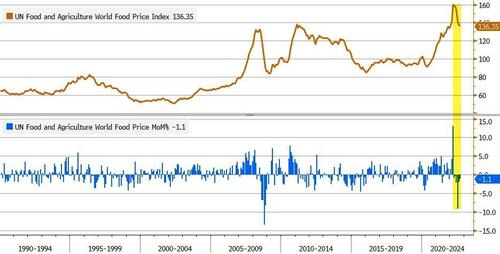
Reuters noted Moscow had “repeatedly” voiced concern about the deal because its implementation presented Russian exporters with challenges to sell farm goods and fertilizer into global markets
Gatilov told Reuters the letter has a list of complaints for Guterres, adding:
“If we see nothing is happening on the Russian side of the deal – export of Russian grains and fertilizers – then excuse us, we will have to look at it in a different way.”
Asked if Moscow would withhold support for the deal over concerns, he said:
“There is a possibility…We are not against deliveries of grains but this deal should be equal, it should be fair and fairly implemented by all sides.”
Wheat futures jumped more than 2% on the prospect of tighter supplies out of Ukraine.
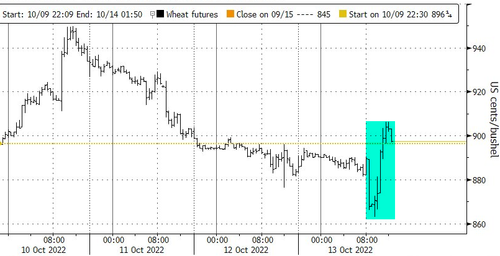
The second development is new US Department of Agriculture data that shows US wheat exports were lowered by 50 million bushels to 775 million, the lowest since 1971. Even though ending stocks for the grain were higher, export forecasts were reduced because the grain is expensive compared to other global competitors.
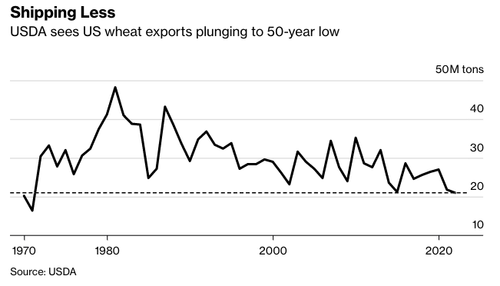
The combination of a possible grain deal bust between Russia and Ukraine and lower exports from the US could reignite fears of a global food crisis.
end
Global finance vs global energy: who will come out on top?
Robert Hryniak
For a long time, it has been obvious that there were two forces at play. One who toiled and produced things reliant on energy and the other a consuming force who gave up manufacturing for the privilege of printing money to enjoy its’ spoils while offering unwanted direction enforced by military might. This is consistent with people still believing the war ravaged Iraqi population should shoulder the burden of a newly minted Dinar to provide instant wealth to anyone fortunate to have bought for such currency for pennies. This is in keeping with a financial machine that produces many financial bubbles and modern day instruments like derivatives to fleece all those not understanding the game.
With the tossing of Russia off Swift, this all changed. Because energy could no longer be exchanged for simply printed dollars conjured up by the Fed to continue the facade that all was well and rosy. Since energy is vital to actual functioning economies the whole nature of settlement for value exchanged was instantly called into question. And on that day American unipolar hegemony died. And what we are now seeing is the reality of having to face up to a multipolar world where there is no singular nation dictating but a collective negotiating accommodations. Oddly, this is better understood outside of the West than within. This also means Western living standards will be adjusted to new realities, whether we like or not. That day of adjustment maybe put off somewhat by conflict but the reality is there. The best thing the West can do is stop and come to terms with reality and negotiate positions putting the skill sets of people to work in creating new technologies the world needs and wants. Because the high days of globalist finance are coming to an end as real capital comes to the forefront. Illusionary wealth of public companies comes under scrutiny by harsh light bringing many to face realities. It is one reason so many companies not long ago referred to as such things as unicorns have fallen. The same truth will hold for many western oligarchs who will find the future unfriendly.
While it may come to pass that prior Russian wealth derived from the sale of natural resources is simply looted by the West; the removal from Swift and thus the USD from settlement caused the Collective South to face the reality of a unreliable buyer using printed money for resources and then deciding to preclude a resource seller from attained bounty. Previously this was called piracy. Who has not heard of Pirates of the high Seas? Such entities were widely used to further national aspirations and not much has changed in this pursuit today. Whether it is the UAE or Saudi Arabia they both have understood the shifting sands so many western countries fail to see and have shown their direction by their presence in Astana, recently. And so it should have come as a surprise they have cut output as OPEC and non OPEC energy producers now sing off the same sheet of music. They do so in the comfort and knowledge that both China and Russia have their back in seeking a new order. And clearly this is not one that will or can be dictated by the West as that day is long gone.
The difference if there is one, is that nations realize the nature of what has occurred and no longer fear the boot or threat of sanctions as realization has occurred certainly amongst energy producing nations that their solidarity and discretion of who receives energy and at what price and under what conditions determines which nations prosper and which nations fold. Limited energy resources simply take away dictates from those who need energy. And while nations may cry loudly or a “woke” crowd may pander to misguided alternatives who have not seen prime time, the reality is that with affordable energy economies stop and wither away denying a once enjoyed lifestyle as payment for political ineptness.
There are distinct reasons why trade is coming to a standstill and a lot has to do with the fact no one wants funny money. People want money that has value behind it, and not simple printed digits that are stolen with out a blink. This is why the American Strategic Reserve is being emptied for real currency to pay bills. Most folks have a hard time understanding there are more USD outside the US than within. And no one wants their hard earned dollars to be polluted by runaway printing. Hence the panic in DC as an hourglass ticks away at ineptness and thievery that has reached a end point.
Read this article and you will understand.
https://thecradle.co/Article/Analysis/16825
end
PAUL ALEXANDER
LOCKDOWN lunatics Francis Collins, Fauci, Birx et al. damaged the immune systems of children, locking down too long & masks & school closures; so why do you think CDC’s own analysis is showing an
increase in medically attended ARI & asthma/RAD exacerbations in children and adolescents during summer 2022? Why? Unusually high number of young children are presenting to the emergency room; Why?
| Dr. Paul AlexanderOct 14 |
We may indeed be facing a dark winter for our children as their immune systems are weak.
We damaged our children and young people in terrible ways and their normally functional capacity immune system is deranged and dysregulated at present, both natural innate and acquired-adaptive. We are also threatening the training of the innate immune system (innate antibodies and NK natural killer cells) with these failed ineffective COVID gene shots.
After an extended period of low EV-D68 circulation during the COVID-19 pandemic, surveillance data suggest increased detection of rhinovirus/enterovirus and EV-D68, concurrent with increased emergency department visits by children and adolescents with acute respiratory illness and asthma/reactive airway disease during summer 2022
END
How Bill Gates & Partners’ money controlled the World’s Draconian Covid Plan’: DAILY EXPOSE; very interesting piece by RHODA WILSON
Remember, you do not read & listen to everything & believe it all, you have to discern what is credible or not & take what is trustworthy; but no one, no TECH, no one is to DECIDE what you read & hear
| Dr. Paul AlexanderOct 14 |
SOURCE:
end
Video: Dr. Paul Elias Alexander, PhD and Dr. Harvey Risch in Albany New York, May, speaking about the COVID lockdowns and COVID gene injections & Fauci and Birx
| Dr. Paul AlexanderOct 14 |
SOURCE:

VACCINE IMPACT/
1st Amendment Dies: $1 Billion Jury Verdict Against Alex Jones Bests Largest Defamation Case in U.S. History by Over $750 MillionOctober 13, 2022 5:13 pm No matter what your opinions are of Alex Jones, yesterday’s jury verdict in Connecticut to pay $965 million in damages to Sandy Hook families and an FBI agent for calling the mass shooting a “hoax” a decade ago, should shock you in terms of the status of the First Amendment in the Bill of Rights of the Constitution of the United States that protects freedom of speech, and freedom of the press. I have been a journalist in the Alternative Media for over a decade, and have faced numerous threats and accusations of defamation and other charges over the content of the articles we publish at Health Impact News, especially in our Medical Kidnapping category. It has forced me to retain some of the top 1st Amendment attorneys in the nation, so this is a topic I have quite a bit of experience in. While the First Amendment protects freedom of speech for the Press, one cannot print lies that cause harm to the entity being criticized. Prior to this jury’s verdict yesterday, the largest defamation case in U.S. history was a case in 1997 where a federal jury in Houston awarded $222.7 million to a local bond brokerage firm in a libel suit over a 1993 article in The Wall Street Journal. The brokerage firm, MMAR Group Inc., contended in its suit that the article made false statements that drove away its clients, causing the firm to close within a month of the article’s appearance. The jury set $200 million in punitive damages and $22.7 million in compensation against Dow Jones & Company, the publisher of The Wall Street Journal. This jury verdict in Connecticut, therefore, is unprecedented in U.S. law, and exceeds the 1997 case against the Wall Street Journal by over $750 million. While the plaintiff in the WSJ case claims to have lost clients and their business, something that can be assessed a monetary value to, what exactly did the alleged victims in the Sandy Hook families lose, that warranted such an enormous amount of money?Read More… No matter what your opinions are of Alex Jones, yesterday’s jury verdict in Connecticut to pay $965 million in damages to Sandy Hook families and an FBI agent for calling the mass shooting a “hoax” a decade ago, should shock you in terms of the status of the First Amendment in the Bill of Rights of the Constitution of the United States that protects freedom of speech, and freedom of the press. I have been a journalist in the Alternative Media for over a decade, and have faced numerous threats and accusations of defamation and other charges over the content of the articles we publish at Health Impact News, especially in our Medical Kidnapping category. It has forced me to retain some of the top 1st Amendment attorneys in the nation, so this is a topic I have quite a bit of experience in. While the First Amendment protects freedom of speech for the Press, one cannot print lies that cause harm to the entity being criticized. Prior to this jury’s verdict yesterday, the largest defamation case in U.S. history was a case in 1997 where a federal jury in Houston awarded $222.7 million to a local bond brokerage firm in a libel suit over a 1993 article in The Wall Street Journal. The brokerage firm, MMAR Group Inc., contended in its suit that the article made false statements that drove away its clients, causing the firm to close within a month of the article’s appearance. The jury set $200 million in punitive damages and $22.7 million in compensation against Dow Jones & Company, the publisher of The Wall Street Journal. This jury verdict in Connecticut, therefore, is unprecedented in U.S. law, and exceeds the 1997 case against the Wall Street Journal by over $750 million. While the plaintiff in the WSJ case claims to have lost clients and their business, something that can be assessed a monetary value to, what exactly did the alleged victims in the Sandy Hook families lose, that warranted such an enormous amount of money?Read More… |
VACCINE INJURY
Babies Born In Lockdown Less Likely To Speak Before First Birthday; New Study Finds
FRIDAY, OCT 14, 2022 – 06:30 AM
Authored by Steve Watson via Summit News,
A new study by researchers in Ireland has concluded that babies born during the COVID lockdown were less likely to be able to speak before their first birthday than children born previously.

The study, led by the Royal College of Surgeons in Ireland, found that children were less likely to be able to reach so called development milestones including waving ‘goodbye’ and pointing at objects.
The study, published in the Archives of Disease in Childhood, focused on 309 babies born in the first three months of lockdown in Ireland between March and May 2020, and tested for ten behavioural milestones at their first birthday, with results then compared against 2000 babies born between the years 2008 and 2011.
The study, titled Social communication skill attainment in babies born during the COVID-19 pandemic, found lockdown babies were 14 per cent less likely to have said their first word, nine per cent less likely to have started pointing, and six per cent less likely to wave goodbye.
Researchers believe that face masks limited the children’s ability to see people’s mouths and become accustomed to facial expressions, leading to enhanced difficulties learning to speak.
In addition, prohibiting relatives and friends of the parents from visiting the children is thought to have contributed to the stunting of social development.
“Lockdown measures may have reduced the repertoire of language heard and the sight of unmasked faces speaking to [infants],” a statement from researchers reads.
It continues, “It may also have curtailed opportunities to encounter new items of interest, which might prompt pointing, and the frequency of social contacts to enable them to learn to wave bye-bye.”
“They were still more likely to be crawling… which might be because they were more likely to have spent more time at home on the ground rather than out of the home in cars and strollers,” the statement also noted.
While the study was observational only, it adds to other evidence that lockdowns and masking in particular have had massively detrimental impacts upon children.
A study in Britain found that many children entering elementary school have severely underdeveloped verbal skills, with many are unable to even say their own name.
According to speech therapists, mask wearing has caused a 364% increase in patient referrals of babies and toddlers.
Another study revealed how mean IQ scores of young children born during the pandemic have tumbled by as much as 22 points while verbal, motor and cognitive performance have all suffered as a result of lockdown.
A study published in the Royal Society Open Science journal found that lockdowns in the UK caused around 60,000 children to suffer clinical depression.
Figures show that 400,000 British children were referred to mental health specialists last year for things like eating disorders and self-harm.
Education experts have asserted that forcing schoolchildren to wear face masks has caused long lasting psychological trauma.
An Ofsted report also warned of serious delays in learning caused by lockdown restrictions.
“Children turning two years old will have been surrounded by adults wearing masks for their whole lives and have therefore been unable to see lip movements or mouth shapes as regularly,” states the report.
Another study out of Germany which found that the reading ability of children has plummeted compared to pre-COVID times thanks to lockdown policies that led to the closure of schools.
Johns Hopkins University concluded that global lockdowns have had a much more detrimental impact on society than they have produced any benefit, with researchers urging that they “are ill-founded and should be rejected as a pandemic policy instrument.”
Yet, many are advocating bringing back restrictions:
As we highlighted last week, a new Centers for Disease Control and Prevention report highlights a record number of children are also now being hospitalised with common colds due to weakened immune systems.
The CDC data is consistent with research by scientists at Yale who warned that it is not normal to see children with combinations of seven common viruses, including adenovirus, rhinovirus, respiratory syncytial virus (RSV), human metapneumovirus, influenza and parainfluenza, as well as COVID-19.
As we previously highlighted, there has also been a global outbreak of hepatitis cases in children, with the media asserting the cause is “unknown.”
Biden administration officials have continuously pushed for children to keep wearing masks in schools, and there are still hordes of hypochondriacs forcing their children to do so, despite COVID posing virtually no risk to the health of children in normal circumstances.
Those who have continually pushed masking on children are the often the first ones to discard the masks themselves when they think no one is watching:
end
Hal Turner Radio Show – *****FLASH***** URGENT – European Member of Parliament Says COVID-19 Vaccines “FAKE” – Do no Good – Terminate Contract and Prosecute Pfizer!
| Robert Hryniak | 9:25 AM (1 minute ago) |   | |
to |
Credibility of all those who supported this falsehood is in question.
MICHAEL EVERY//RABOBANK
Michael Every on the major topics of the day
“After You”… “No, After You”
FRIDAY, OCT 14, 2022 – 10:16 AM
By Michael Every of Rabobank
Your Turn!
The summary of this week’s events feel like one of those cheesy “after you”, “no, after you” comedy scenes.
Basically, we’ve had the Bank of England tell the government “you turn!” after the mini-budget caused market turbulence, which was only met with the UK government telling the Bank “no, you turn!” instead. Behind closed doors the Bank of England then suggested to market participants “don’t worry, we’ll turn if we have to”, while Governor Bailey publicly maintained “we won’t turn”. Then, Chancellor Kwarteng essentially told the central bank “no, I insist, you turn!”, when he told Sky News that the Bank would be responsible for any renewed volatility after its temporary bond buying program ends. That’s the Chancellor throwing the Governor under the bus.
Meanwhile, Tories are screaming “Turn!!!” at the Prime Minister, with rumors of plans to replace Liz Truss, as well as rumours that 10 Downing Street may finally be backpedalling on parts of its fiscal plans. But regardless of how many changes the government makes, the government’s true uphill battle is reasserting to markets that they will be responsible with the UK’s budget. King Charles greeting Truss with “Dear, oh dear” underscores just how much of a mess the government has created.
Long-dated gilts dropped significantly yesterday, with the 10y yield declining ~25bp and the 30y gilt ending the day some 27bp lower. Yet, that could also be the result of another round of Bank interventions – while they still last. Because as much as any U-turn has been suggested, little actual turning has been done. So far, the only thing that has turned around is Chancellor Kwarteng’s airplane, as he left the IMF meeting in Washington a day early to return to London.
Over on that other side of the Atlantic, the US CPI data released yesterday removed any remaining doubts over whether the Fed might do a slight turn from their current trajectory: headline CPI inflation came in at 8.2%, which is slightly lower than last month’s (8.3%). However, the core reading accelerated by more than expected, to 6.6%. If anyone was still questioning if the FOMC might do another 75bp hike in November, this latest data point should give a clear signal that now is not the time to turn back to 50bp steps. Indeed, the market-implied expectations currently fully price a 75bp increase.
And that the ECB isn’t looking to do a quick U-turn on its policy either was already clear from the accounts of the September meeting. Recall that the ECB acknowledged that monetary policy was ill-equipped to deal with supply shocks, but that it clearly can affect the balance of supply and demand. To that avail, it was argued that “putting too much emphasis on supply-side problems could risk neglecting the fact that aggregate demand had to adjust to curb inflation.” In other words, the ECB will not be deterred by a moderate slowdown; in fact, it may actively need to cause one in order to bring down aggregate demand.
Unsurprisingly, outright support for another 75bp move this month has been growing since the previous meeting. More notably, though, Council member Simkus was the first to suggest that the ECB may have to opt for a hattrick, noting that a “75bp or 50bp hike is needed in December”. How many big hikes does it take before “frontloading” suffers the same fate as “transitory”?
Not only does that again put into question the ‘meeting-by-meeting’ approach that the ECB has adopted (and one would hope that policymakers have a bit of a longer-term view and strategy anyway), it also suggests that the ECB, too, will err on the cautious –in this case, read: hawkish– side as long as the inflation outlook does not show material improvement. Belgian central bank governor Wunsch told CNBC that he would not be surprised if the ECB has to hike above 3% at some point.
That said, the one policy area where there may have been some U-turning in the hawkish camp is quantitative tightening. Reducing liquidity is still very much on the Council’s agenda, and could start in the first half of 2023. But instead of active bond sales, the latest leaks suggest that a passive reduction of the balance sheet (i.e., not reinvesting the proceeds of maturing bond holdings) may be the preferred option. Before the Truss government made the Bank of England’s job impossible, some ECB policymakers were pointing at the plans of their UK peer to actively sell assets as an example. The ECB may have been taking notes as that plan unravelled rapidly. Although the backdrop for the ECB may be different than the UK’s situation, the central bank will have to remain mindful of the impact on spreads in order to avoid pushing any country into the ECB’s newly-created Transmission Protection Instrument, which would effectively see the ECB buy assets as it is reducing the balance sheet. These TPI purchases would be sterilized, but it would still render quantitative tightening partially self-defeating in terms of shrinking the ECB’s balance sheet.
END
7. OIL//OIL ISSUES//NATURAL GAS//ELECTRICITY ISSUES/USA//GLOBE
OPEC Decision To Cut Output May Lead To Supply Deficit In Oil Markets
FRIDAY, OCT 14, 2022 – 01:19 PM
By Irina Slav of OilPrice.com
Last week, OPEC+ said it would reduce its oil production target by 2 million barrels daily, with actual cuts of between 1 and 1.1 million bpd. The announcement pushed prices higher. By the end of the week, the resulting oil price rally had run out of steam, and prices were once again sliding on recession fears. And these fears might mask how the oil market tips into a shortage.
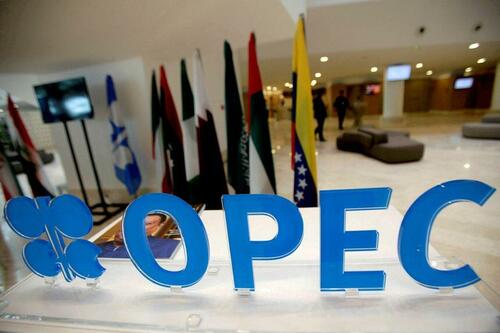
When the cartel said it would be cutting production, OPEC officials explained the reasons for the decision had to do with anticipating a drop in demand and saving spare production capacity for the eventuality of a sudden output outage such as one in Russia following the EU embargo entering into effect at the end of the year, for example.
The U.S. signaled it saw the move as a political one, amounting to a snub by Riyadh, which will be one of three OPEC members actually reducing production, and a declaration of siding with Russia.
The latter Riyadh already did six years ago when OPEC+ was born, so it shouldn’t have come as a surprise, but the snub appears to have come as a shock to Washington, prompting President Biden to threaten “consequences” of a yet unidentified nature.
While the White House ponders its options, some analysts have noted that the move of OPEC+ would tighten an already tight oil market. Recession worry seems to be reigning in oil markets right now, but the risk of an oil shortage is there, and none other than OPEC has been warning about it, most vocally Saudi Arabia in the face of its energy minister.
Meanwhile, there is more bad news: global oil inventories are in a decline that would be difficult to reverse. This is what Reuters’ John Kemp noted in a column this week, saying U.S. inventories have shed 480 million barrels in the past two years, to reach the lowest level for this time of the year since 2004.
The situation with fuel inventories is even more worrying, with U.S. distillate inventories down to the lowest since records began in 1982, and European distillate inventories at the lowest since 2002. Distillate inventories in Singapore are also at a multi-year low, shedding 9 million barrels over the past two years.
The fall in distillate inventories is perhaps even more concerning than the decline in crude stocks because distillates are used to make diesel fuel, and diesel fuel is used in the freight transport of goods, which is vital for every economy. A reserve depletion means price hikes, and price hikes mean good fuel for inflation.
Still, despite the precarious state of global oil and distillate inventories, Saudi Arabia just said this week that the decision to reduce output was a purely economic one. In an official response to U.S. accusations, the Saudi foreign ministry issued a statement that said:
“The Kingdom clarified through its continuous consultations with the U.S. administration that all economic analyses indicate that postponing the OPEC+ decision for a month, according to what has been suggested would have had negative economic consequences.”
Whatever the motives for the decision, it has been made, and those unhappy with it have few options at their disposal for punishing those that made it. Oil prices remain subdued, meanwhile, although analysts updated their fourth-quarter price forecasts after the OPEC+ decision.
Again, this is largely because the fear of recession has been fuelled by a stable flow of pessimistic forecasts, the latest coming from the IMF this week. Indeed, the immediate future of the global economy does not look good, and when the economic outlook is bad, so is the oil price outlook. Yet a shortage of oil could certainly change this, especially when it coincides with an oil embargo and a price cap.
END
8 EMERGING MARKET& AUSTRALIA ISSUES & OTHER EMERGING NATIONS
end
Your early currency/gold and silver pricing/Asian and European bourse movements/ and interest rate settings FRIDAY morning 7:30 AM
Euro/USA 0.97144 DOWN 0.0052 /EUROPE BOURSES // ALL GREEN
USA/ YEN 147.75 UP 0.436 /NOW TARGETS INTEREST RATE AT .11% AS IT WILL BUY UNLIMITED BONDS TO GETS TO THAT LEVEL…//YEN TOTALLY COLLAPSES
GBP/USA 1.1179 DOWN 0.01256
Last night Shanghai COMPOSITE CLOSED UP 58.35 PTS OR 1.85%
Hang Seng CLOSED UP 198.53 POINTS OR 1.31%
AUSTRALIA CLOSED UP 1.67% // EUROPEAN BOURSE: ALL GREEN
Trading from Europe and ASIA
I) EUROPEAN BOURSES ALL GREEN
2/ CHINESE BOURSES / :Hang SENG CLOSED UP 198.53 PTS OR 1.31%
/SHANGHAI CLOSED UP 58.35 PTS OR 1.85%
AUSTRALIA BOURSE CLOSED UP 1.67%
(Nikkei (Japan) CLOSED UP 853.34 PTS OR 3.25%
INDIA’S SENSEX IN THE GREEN
Gold very early morning trading: 1656.40
silver:$18.67
USA dollar index early FRIDAY morning: 113.15 UP .89 CENT(S) from THURSDAY’s close.
FRIDAY MORNING NUMBERS ENDS
xxxxxxxxxxxxxxxxxxxxxxxxxxxxxxxxxxxxxxxxxxxxxxxxxxxxxxxxxxxxxxxxxxxxxxxxxxxxxxxxxxxxxxxxxxxxxxxxxxxxxxxxxxxxxx
And now your closing FRIDAY NUMBERS 1: 00 PM
Portuguese 10 year bond yield: 3.43% UP 6 in basis point(s) yield
JAPANESE BOND YIELD: +0.243% DOWN 0 AND 0/10 BASIS POINTS /JAPAN losing control of its yield curve/
SPANISH 10 YR BOND YIELD: 3.53%// UP 7 in basis points yield
ITALIAN 10 YR BOND YIELD 4.81 UP 7 points in basis points yield ./ THE ECB IS QE ITALIAN BONDS/SELLING GERMAN BUNDS
GERMAN 10 YR BOND YIELD: RISES TO +2.357% UP 6 BASIS PTS
END
IMPORTANT CURRENCY CLOSES FOR FRIDAY
Closing currency crosses for day /USA DOLLAR INDEX/USA 10 YR BOND YIELD/1:00 PM
Euro/USA 0.9743 DOWN .0025 or 25 basis points
USA/Japan: 148.48 UP 1.173 OR YEN DOWN 117 basis points/
Great Britain/USA 1.1211 DOWN .0091 OR 91 BASIS POINTS
Canadian dollar DOWN .01124 OR 112 BASIS pts to 1.3876
xxxxxxxxxxxxxxxxxxxxxxxxxxxxxxxxxxxxxxxxxxxxxxxxxxxxxxxxxxxxxxxxxxxxxxxxxxxxxxxx
The USA/Yuan, CNY: closed ON SHORE (CLOSED ..(DOWN) AT 7.1911
THE USA/YUAN OFFSHORE: (YUAN CLOSED (DOWN)…. 7.2192
TURKISH LIRA: 18.59 EXTREMELY DANGEROUS LEVEL/DEATH WISH/HYPERINFLATION TO BEGIN.
the 10 yr Japanese bond yield at +0.243
Your closing 10 yr US bond yield UP 6 IN basis points from THURSDAY at 4.018% //trading well ABOVE the resistance level of 2.27-2.32%) very problematic
USA 30 yr bond yield 3.987 UP 6 in basis points
Your closing USA dollar index, 112.97 UP 74 PTS ON THE DAY/1.00 PM/
Your closing bourses for Europe and the Dow along with the USA dollar index closing and interest rates FRIDAY: 12:00 PM
London: CLOSED UP 21.18 PTS OR 0.31%
German Dax : CLOSED UP 102.81POINTS OR 0.83%
Paris CAC CLOSED UP 62.95 PTS OR 1.07%
Spain IBEX CLOSED UP 41.30 OR 0.86%
Italian MIB: CLOSED UP 192.82PTS OR 0.33%
WTI Oil price 86.27 12: EST
Brent Oil: 92.35 12:00 EST
USA /RUSSIAN /// RUBLE RISES TO: 61.96 UP 1 AND 67/100 RUBLES/DOLLAR
GERMAN 10 YR BOND YIELD; +2.357
CLOSING NUMBERS: 4 PM
Euro vs USA: 0.97264 DOWN .0040 OR 40 BASIS POINTS
British Pound: 1.1179 DOWN .01225 or 123 basis pts
USA dollar vs Japanese Yen: 148.63 UP 1.32//YEN DOWN 132 BASIS PTS
USA dollar vs Canadian dollar: 1.3885 UP 0.0121 (CDN dollar, DOWN 121 basis pts)
West Texas intermediate oil: 85.61
Brent OIL: 91.75
USA 10 yr bond yield UP 5 BASIS pts to 4.000%
USA 30 yr bond yield UP 4 BASIS PTS to 3.968%
USA dollar index:112.29 DOWN 85 CENTS
USA DOLLAR VS TURKISH LIRA: 18.59
USA DOLLAR VS RUSSIA//// ROUBLE: 62.10 UP 1 AND 52/100 ROUBLES
DOW JONES INDUSTRIAL AVERAGE: DOWN 395.05 PTS OR 1.32 %
NASDAQ 100 DOWN 341.52 PTS OR 3.10%
VOLATILITY INDEX: 32.20 UP 0.26 PTS (0,81)%
GLD: $152.98 DOWN 1.93 OR 1.25%
SLV/ $16.82 DOWN $.57 OR 3.27%
end)
USA trading day in Graph Form
Catrusstrophe & Consumer Prices Clobber Bonds, Bullion, & Big-Tech
BY TYLER DURDEN
FRIDAY, OCT 14, 2022 – 04:01 PM
UK u-turns, soaring CPI, short-squeezes, endless FedSpeak, and Putin pontifications… what a week…
Amid the chaotic headlines from the UK (and the apparent end of BoE’s pension fund bailout), cable ended the week marginally stronger (though dumping today)…
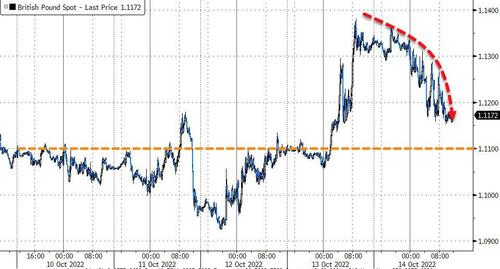
Source: Bloomberg
…but gilt yields were notably higher after an ugly selloff today into the UK close (30 Gilt yields rose 60bps from their lows today)…
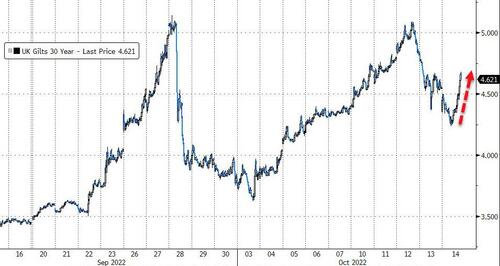
Source: Bloomberg
We suspect nothing is solved across the pond.
In the US, Treasury yields are all higher on the (shortened) week with the short-end underperforming (2Y yields closed the week above 4.5%)…
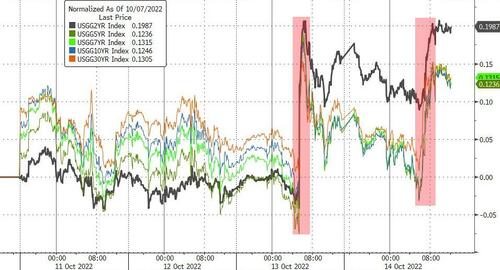
Source: Bloomberg
10Y Yields rose back above 4.00% again today and stalled there…
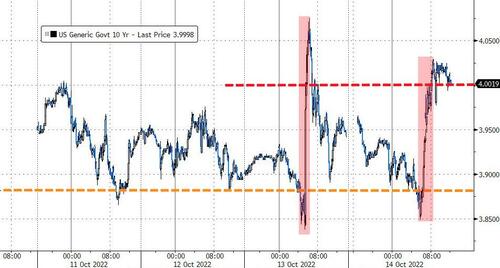
Source: Bloomberg
30Y Yields tagged 4.00% yesterday briefly and tried today but were unable…
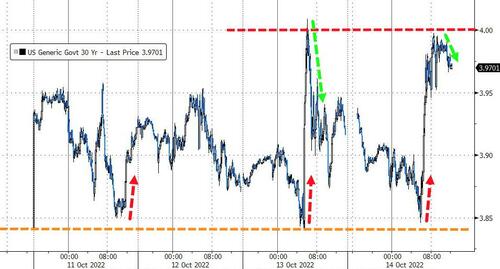
Source: Bloomberg
At the short-end, the market’s expectation for The Fed’s terminal rate (hawkishly) surged to 4.96% (in March 2023). At the same time, market expectations of post-recession rate-cuts also surged (but dovishly)…
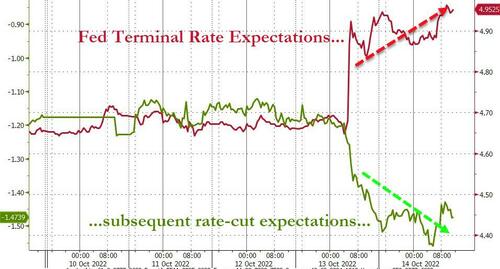
Source: Bloomberg
While stocks bounced back yesterday after the CPI print, the hawkish shift in rate expectations continued today and stocks started to catch down to that reality today…
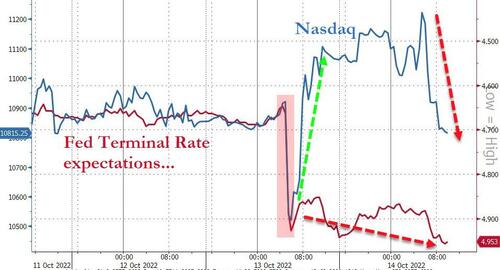
Source: Bloomberg
US equity markets were just as chaotic as bonds after yesterday’s CPI puke and panic-buying squeeze which led to today’s reality check lower. A late-day dump meant the Nasdaq ended the day down over 3.0% after being up 1.5% pre-market…

On the week, only The Dow managed to close green with Nasdaq dumping all of yesterday’s gains and then some, closing down over 3%…
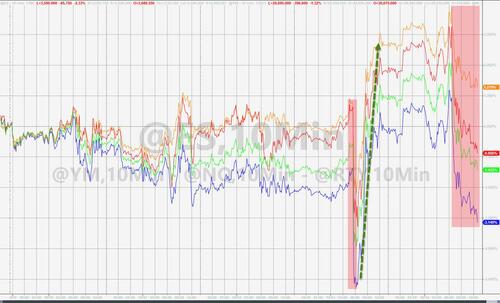
One bright spot is that today’s lows were above yesterday’s CPI-spike-down lows.
The S&P seemed to find support around 3600…
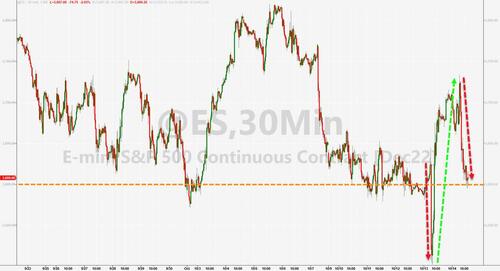
On the week, Staples & Healthcare outperformed while Discretionary and Tech were the laggards
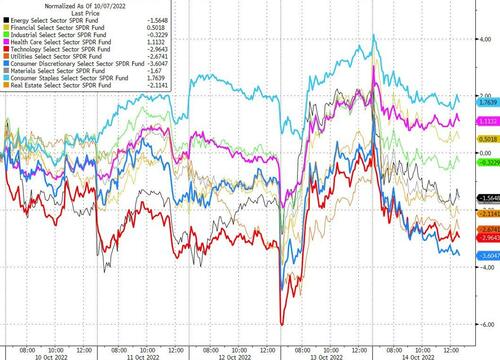
Source: Bloomberg
Wells Fargo and JPMorgan outperformed today after earnings beats while Morgan Stanley missed and dumped almost 5%…
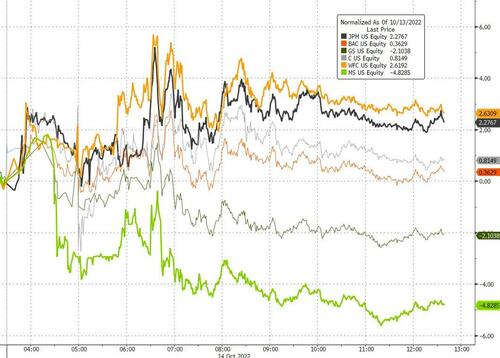
Source: Bloomberg
The dollar rallied for a second straight week, albeit with some crazy volatility…
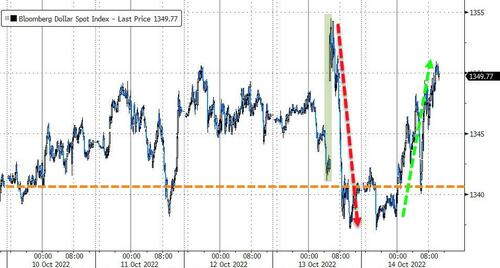
Source: Bloomberg
JPY was a shitshow this week (down 8 days in a row and down 9 weeks in a row), crashing to its weakest against the dollar since 1990 (almost at the Maginot Line of 150)…

Source: Bloomberg
Despite yesterday’s surge higher, cryptos ended the week lower (with Bitcoin the prettiest horse in the glue factory, holding above $19k)….
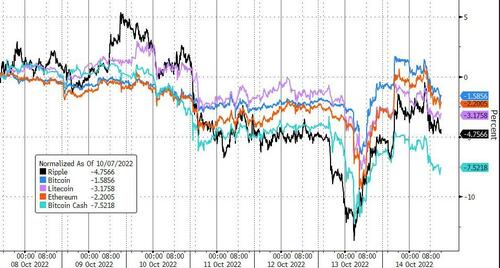
Source: Bloomberg
Gold suffered its worst week since July (after 2 weeks of gains), unable to hold its bounce back above $1700…
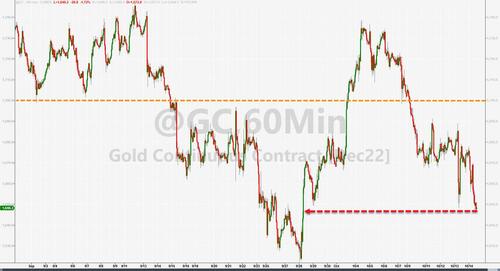
After last week’s surge higher, oil prices tumbled this week with WTI unable to hold $90 (falling further today after an unexpected jump in the rig count)…

Finally, the 2008/9 analog continues to play out…
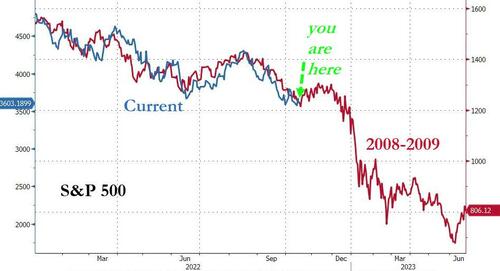
So is a bounce into the FOMC meeting set?
However, the market’s real fear gauge is surging higher… (FRA-OIS is an indicator of interbank funding stress)

Something’s going wrong in the market’s pipes.
Simply put, if the FRA-OIS spikes another 10-15 points, the Fed will have no choice but to emerge from its paralysis and reassure markets that the financial system isn’t about to experience another paralysis.
I) / EARLY MORNING// TRADING//CPI RELEASE
AFTERNOON TRADING//FOMC MINUTES
ii) USA DATA/
USA economy faltering badly: real uSA retail sales (ex inflation) tumbles again in Sept.
(zerohedge)
Real US Retail Sales Tumble (Again) In September
FRIDAY, OCT 14, 2022 – 08:37 AM
US retail sales were expected to rise 0.2% MoM in September but instead were disappointedly unchanged. On a year-over-year basis, retail sales (nominal) rose 8.2%, the weakest since April
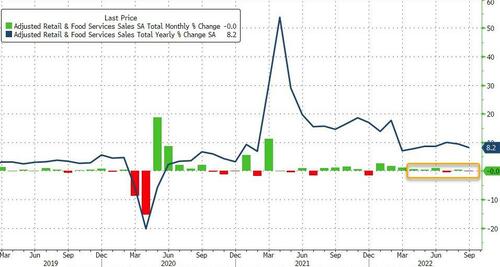
Source: Bloomberg
Ex-Autos and Ex-Autos and Gas both rose more than expected (+0.1% vs -0.1% exp and +0.3% vs +0.2% exp respectively). On a YoY basis, core retail sales rose 6.6%., exactly in line with Core CPI’s 6.6% YoY rise…
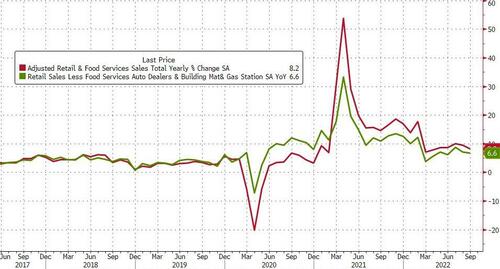
The control group – which feeds directly into GDP – rose 0.4% MoM (above the +0.3% expectation).
Under the hood, motor vehicles sales were down, food & beverage up, gas stations down, and miscellaneous store retailers down hard…
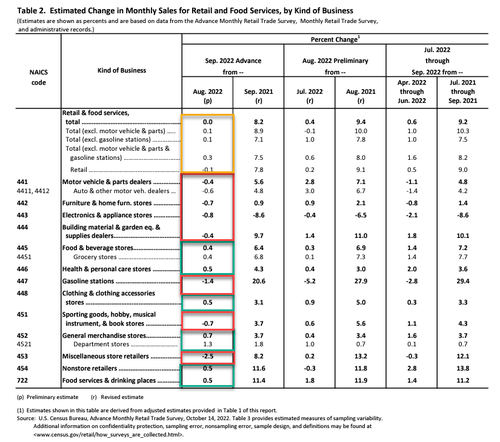
Store Retailers saw sales tumble 2.5% MoM – the biggest monthly drop since May 2021…

Source: Bloomberg
And finally, we remind readers that retail sales data is nominal – i.e. not adjusted for inflation. While we know very well that adjusting headline retail sales by headline CPI is not apples to apples, it is a good rough guide to what is really going on…
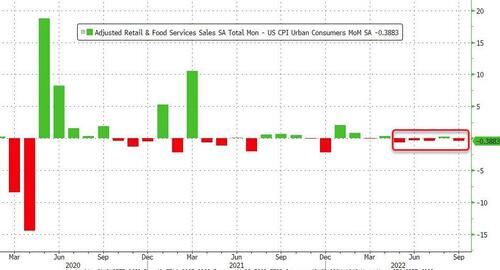
Source: Bloomberg
This means the ‘real’ retail sales in September fell for the 4th month of the last 5… “strong consumer”?
end
UMich Inflation Expectations Unexpectedly Jumped In October
FRIDAY, OCT 14, 2022 – 10:05 AM
UMich headline sentiment was expected to rise very modestly in preliminary October data and did – beating expectations with a 59.8 print against 58.8 expectations. However, this was driven by a jump in current conditions offsetting a drop in future expectations…
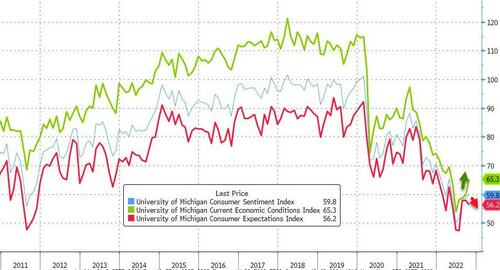
Source: Bloomberg
Continued uncertainty over the future trajectory of prices, economies, and financial markets around the world indicate a bumpy road ahead for consumers.
However, what most investors were watching for was inflation expectations which unexpectedly spiked higher…
The median expected year-ahead inflation rate rose to 5.1%, with increases reported across age, income, and education. Last month, long run inflation expectations fell below the narrow 2.9-3.1% range for the first time since July 2021, but since then expectations have returned to that range at 2.9%. After 3 months of expecting minimal increases in gas prices in the year ahead, both short and longer run expectations rebounded in October.
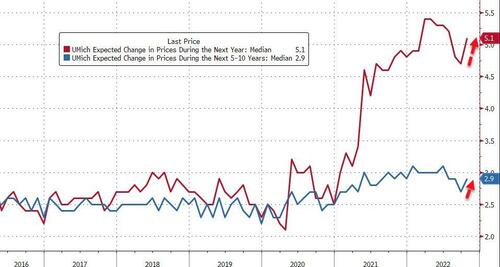
Source: Bloomberg
Do not forget that inflation expectations are likely to remain relatively unstable in the months ahead, as consumer uncertainty over these expectations remained high and is unlikely to wane in the face of continued global pressures on inflation.
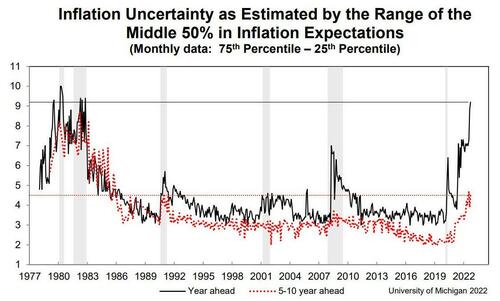
Home-buying conditions plunged to nbew cycle lows (40 year lows)…
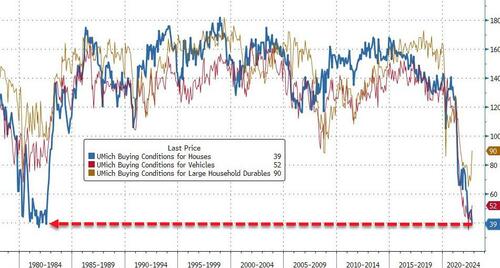
Finally, we note that confidence in The Fed has plunged (especially this year for Independents and Democrats)…
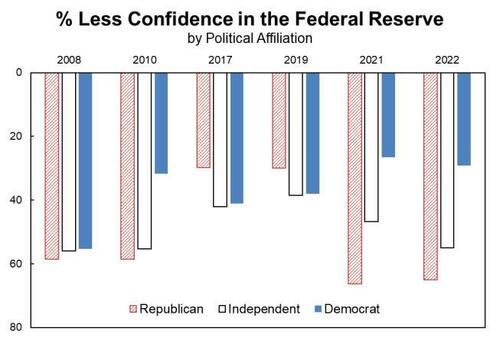
With the usual assumption that a high level of confidence in the Fed would be associated with more favorable prospects for the national economy, consumer views suggest there may be headwinds that may dampen the outlook for the economy.
III) USA ECONOMIC STORIES
Jaime Dimon slams Biden’s begging for Saudi oil
(zerohedge)
“This Is A F**king War”: Jamie Dimon Slams Biden Begging Saudis For Oil, Says Investors “Don’t Give A Shit” About ESG
THURSDAY, OCT 13, 2022 – 05:20 PM
Three days after Jamie Dimon sparked a marketwide selloff which sent stocks to fresh 2022 lows after he predicted a US recession in “6 to 9” months citing drivers including rising interest rates, persistent inflation and Russia’s invasion of Ukraine, and warned stocks could drop another 20%, the JPMorgan CEO who is expected to report earnings tomorrow (and hopefully clarify why his bank refuses to move its deposit rate above 0.01% in the process keeping $2.2 trillion in liquidity locked inside the overnight funding facility), doubled down today saying the Fed can’t cool the red-hot economy without bringing on a recession.
“I don’t know if it could be a soft landing — I don’t think so, but it might,” the JPMorgan chief executive officer said at an industry conference in Washington Thursday, adding that the alternatives would be a mild or a severe recession. “In a tough recession, you could expect the market to go down another 20% to 30%”, adding an additional 10% to the number he first floated on Monday.
It got worse: besides predicting a hard-landing and a 30% crash, the CEO of the largest US bank also said his “gut” tells him that the Fed funds rate will probably have to rise higher than the 4% to 4.5% level many economists are predicting, as inflation persists.
Still, Dimon said he has “total faith and trust” in Fed Chair Jay Powell, and that stagflation is far worse than most of the other potential outcomes as the Fed works to cool price pressures.
And in a sign that markets may be getting ahead of themselves, Dimon also said that the consumer could be strong for another nine months (around the time the recession hits). In other words, Dimon, who has warned about recession and a further stocks crash, has also repeatedly stressed that consumers are still healthy. We are confident that Jamie will tell us when in his view consumers are finally crashing.
Some other notable statements by Jamie include:
- JPMorgan is sitting on $1.2 trillion in cash
- China can micro-manage growth at 3-4%
- CCAR has become untethered from reality (which we know since clearly nobody could have possibly predicted the UK’s pension fund crisis)
- Commodity prices around the world are very fragile
Excerpts below: https://www.zerohedge.com/markets/fking-war-jamie-dimon-slams-biden-begging-saudis-oil-says-investors-dont-give-shit-about
In separate – and far more provocative -c omments made earlier in the day during a JPMorgan investor seminar where he led a fireside chat moderated by JPMorgan’s Gergana Thiel, Dimon made some extremely outspoken comments which however you won’t hear on the mainstream media, telling a small group of listeners that was closed to the press that the “President of the Unites States needs to stand up and say we may not meet our 2050 climate objectives because this is a fucking war”.
He also said “time to stop going hat in hand to Venezuela and Saudi and start pumping more oil & gas in the USA”
Echoing what he has said before, Jamie said this is the way the USA maintains its standing, as the future of the world is by pumping more oil and gas and using energy security to ensure Western unity.
And he did say when it comes to ESG “investors don’t give a shit” warning not to “cede governance to do-gooder kids on a committee”.
Finally, he stressed the need for strong American leadership that is not being provided by either party. His conclusion: the world needs American diplomacy and neither Trump or Biden can lead the USA.
end
Bank of America: USA is a long way from the market bottom
(zerohedge)
Bank of America Has Bad News For Its Clients: We Are A Long Way From The Market Bottom
THURSDAY, OCT 13, 2022 – 09:20 PM
Two days ago, before today’s monster market reversal, Bank of America’s quant team published an interesting note in which the BofA strategist Jill Carey Hall wrote recent client flows “suggest investors believe market may have bottomed.”
Why did she make this observation? As she explains, “last week, during which the S&P 500 rallied 1.5% off recent lows, clients were big net buyers of US equities ($6.1B; third largest inflow in our data history since ’08 and the fifth consecutive week of inflows).” Digging into the details, BofA’s clients bought both single stocks and ETFs (biggest single stock inflows since April), and bought both large and mid caps while selling small caps for a second week.
- Clients bought ETFs across styles/sizes, led by large cap and Value ETFs. Value ETF flows were the fourth largest in our data since 2017 and the ninth week of inflows.
- Clients bought ETFs in six of the 11 sectors, led by Energy (biggest inflows since late July). Materials and Financials ETFs saw the largest outflows
Unlike previous weeks when client group flows mutually offset each other, this time all client groups (hedge funds, institutional, private clients) were net buyers, led by Institutional clients (first inflow in a month and biggest inflow since Dec. 2020).
Meanwhile, as we have been warning for weeks, stock buybacks have slowed to a trickle (max blackout window was last Friday), and begin to pick up over the next four weeks of earnings, with Halloween expected to be the day most buybacks are again in the market.
And with stocks today staging a powerful reversal off of 2022 lows and exploding higher in a powerful thrust, which many say is a telltale sign of market bottoms, many are wondering – are Bank of America’s clients right in believing that we have finally bottomed?
The answer, according to the bank itself, is that we have a long way to go still before the market bottoms.
As BofA head quant Savita Subramanian writes, there are two reasons why it is far too early to declare a bottom. The first one comes from the bank’s Regime Indicator, to wit:
Our US Regime Indicator declined for the 14th consecutive month in September, still in Late Cycle but inching closer to Downturn (from 0.5 in August to 0.4). Historically, the Late-Late cycle phase (i.e., moving from the +0.5 level to negative territory) has lasted ~4 months, which means the current Late Cycle might persist through year-end, favoring Value, Risk, Low Quality and Small Caps for 4Q22. In our history since 1990, once the Regime Indicator declined below the 0.5 level in Late Cycle, it inevitably proceeded to decline into the next phase, Downturn.

It’s not just the macro regime indicator, however, as BofA’s bull market signposts – a composite of 10 indicators that have historically signaled market bottoms – continue to suggest risk that the market hasn’t yet bottomed. In fact, of the 10 indicators, only 20% were triggered in September, down from 40% a month ago, when the unemployment rate and the ISM both declined (no longer triggered). As BofA notes, “prior market bottoms coincided with over 80% being triggered” so we have a long way to go.

Bottom line: today’s rally was just the latest spectacular bear-market rally, a combination of a short squeeze, technicals, positioning and a little chart voodoo. But for the true bottom, what the market needs more than anything is a capitulation by the Fed: that won’t happen until inflation moderates, which won’t happen for a long time, if ever, since most of the remaining inflation is supply-driven and the Fed has no control over that, or when something really big finally breaks. Our money is on the latter.
More in the full note available to pro subs.
end
III B USA COMMODITY PROBLEMS//INFLATION WATCH
Beans piling up on shores//farms along the Mississippi as barges cannot meet harvest demand
(zerohedge)
Massive Bean Piles Spotted Up And Down Mississippi River As Barges Can’t Meet Harvest Demand
THURSDAY, OCT 13, 2022 – 08:00 PM
Bean and other farm goods are piling up at farms up and down the Mississippi River as barges can’t be fully loaded due to dangerously low water levels. Barges have reduced weight to improve the draft, which means less availability and unable to meet harvest demand.
Due to a barge shortage, some farmers have no choice but to store beans and other farm goods outside in massive piles. Twitter user “Will Nicholson” captured footage of an enormous bean pile west of Memphis, Tennessee.
Another person took a picture of a bean pile in Tunica, Mississippi.
One person said:
“I’m hearing of lots of beans being piled on the ground along the lower Mississippi due to no barge traffic. It’s a regular occurrence here in SESD… but we are prepared with pads/bunks/air/tarps. Some warm and wet weather down south and I see very bad things happening.”
Someone tweeted an image that some farmers were resorting to trucks rather than barges as traffic on the Mississippi ground to a halt last week.
Here’s a shocking image of the dried-up Mississippi River.
…

Did we mention barge prices on the Mississippi have hyperinflated due to vessel scarcity?
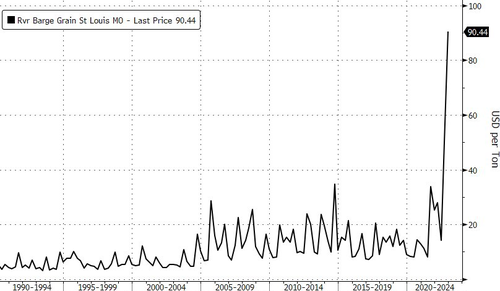
Most of these beans and other farm goods were slated for major export terminals in the Gulf of Mexico. How long can these freshly harvested crops be piled up outside until they go bad?
end
Price inflation grew faster than wages
(Mises)
Americans Are Getting Poorer: Price Inflation Grew Faster Than Wages Again In September
FRIDAY, OCT 14, 2022 – 02:40 PM
Authored by Ryan McMaken via The Mises Institute,
The federal government’s Bureau of Labor Statistics released new price inflation data today, and according to the report, September was yet another month of soaring inflation. According to the BLS, Consumer Price Index (CPI) inflation rose 8.2 percent year over year during September, before seasonal adjustment. That’s the nineteenth month in a row of inflation above the Fed’s arbitrary 2 percent inflation target, and it’s seven months in a row of price inflation above 8 percent.

Month-over-month inflation rose as well, with the CPI rising 0.2 percent from August to September. September’s month-over-month growth also shows some acceleration in monthly price inflation growth. Month-to-month growth had been approximately zero in July and August following nineteenth months of monthly growth.
September’s increase keeps price inflation near forty-year highs. June’s year-over-year increase of 9 percent was the largest CPI increase since 1981, but September’s increase percent still keeps price inflation well within the same range as the inflationary years of the early 1980s. September’s increase was the seventh-largest increase in forty years.
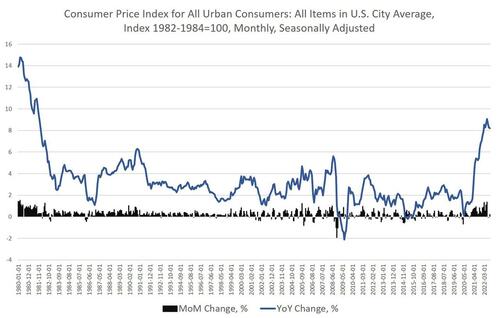
The ongoing price increases largely reflect price growth in food, energy, transportation, and shelter. In other words, the prices of essentials all saw big increases in August over the previous year.
For example, “food at home”—i.e., grocery bills—was up 13.0 percent in September over the previous year. Gasoline continued to be up, rising 18.2 percent year over year, while new vehicles were up 9.4 percent. Shelter registered one of the more mild increases, with a rise of “only” 6.6 percent according to the BLS.
This is bad news for the Biden administration, as this is the final price inflation report before the November elections. The administration has repeatedly attempted to downplay the relentless increases to the cost of living being inflicted on Americans after years of deficit spending, which has helped fuel inflationary monetary policy.
On Thursday, for example, the Biden attempted to claim that price inflation increase “2 percent” by slicing and dicing the numbers into an annualized rate composed of only the past three months.
In a written statement, the president insisted “Today’s report shows some progress in the fight against higher prices, even as we have more work to do … Inflation over the last three months has averaged 2%, at an annualized rate…”
In the real world, however, Americans have lost an immense amount of purchasing power. That purchasing power is lost forever unless there is sizable price deflation in coming years, and the deflation-phobic central bank is sure to intervene to make sure that doesn’t happen.
In terms of real earnings, this has been devastating for many wage earners. According to the BLS, average hourly earnings in September came in at $32.40. That’s an increase of 4.92 percent, year over year. This might be good news were it not for the fact that price inflation was up 8.2 percent during the same period.
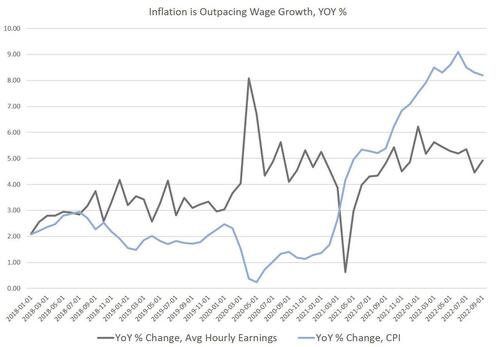
So, the gap between wage growth and price inflation in September was –3.3. This means September was the eighteenth month in a row during which price inflation has outpaced earnings.

This is bad news for the administration, and it’s also bad news for the Federal Reserve. The persistent price inflation is a repeated reminder of just how far behind the curve the Fed is, and how reckless the Fed was in essentially printing nearly $5 trillion between February 2020 and April 2022. Over the past two years, the Fed repeatedly assured the public that creating vast amounts of new money would be no problem and that price inflation would never be anything more than “transitory.”
Once that narrative was disproven, the Fed then began to admit late in 2021 that CPI inflation was not transitory but that the Fed would not allow it to become “entrenched.” Price inflation did indeed become entrenched, but the Fed waited more than six months, from the fall of 2021 to spring 2022, to actually begin raising the target federal funds rate. The Fed’s lack of real action can further be seen in the fact that the Fed’s portfolio—which grew by $8 trillion with newly created money from 2008 to early 2022—has dropped by only 2.3 percent this year. That may be enough to spook markets, but it’s hardly enough to promote any sort of return to real prices in asset markets or normality in monetary policy.
There are only painful options for bringing price inflation under control at this point, and that’s all thanks to the Fed’s creation of countless bubbles and malinvestments over the past decade. The Fed has created a bubble economy that’s desperately addicted to quantitative easing, ultra-low interest rates and other forms of easy money. So, putting the brakes on new money creation, even without any real effort at quantitative tightening, will lead to soaring defaults, and attempts to save on expenses by laying off workers.
The only “good” news here—considering the options—is that this will lead to falling prices as unpaid debts evaporate thus shrinking the money supply. Demand destruction will also occur and people lose their jobs and higher interest rates mean less spending. We’re already starting to see some evidence of this. According to the Case-Shiller index, home price growth if finally slowing. Meanwhile, job opening as fallen to a fourteen-month low, savings rate have fallen to a post-2008 low, and disposable income growth has collapsed.
That will slow price inflation, but not without also bringing a lot of pain to ordinary people trying to make a living.
Michael Snyder…..
The end of cheap food and cheap gasoline
(Michael Snyder)
The Era Of Cheap Food And Cheap Gasoline Is Over
FRIDAY, OCT 14, 2022 – 07:20 AM
Authored by Michael Snyder via TheMostImportantNews.com,
All of our lifestyles are about to change in a major way, but the vast majority of the population still does not understand what is coming. Throughout our entire lives, we have always been able to depend on a couple of things. There would always be cheap gasoline to fuel our vehicles and there would always be mountains of cheap food at the grocery store. No matter who was in the White House and no matter what else was going on in the world, those two things always remained the same. Unfortunately, those days are now over and they aren’t coming back.

We have entered the greatest energy crisis that any of us have ever experienced, and it isn’t going to go away any time soon.
So you might as well get used to high gas prices. Earlier this month, brand new all-time record highs were set all over southern California…
- Los Angeles-Long Beach – $6.46 (Record high)
- Orange County – $6.42 (Record high Saturday)
- Ventura County – $6.40
- Riverside County – $6.33 (Record high)
- San Bernardino County $6.32
But that isn’t the real problem.
The real problem is with natural gas.
Thanks to the war in Ukraine, supplies of natural gas in Europe have become extremely tight, and this has pushed prices into the stratosphere.
Needless to say, this is going to greatly affect food productions in the months ahead. According to Bloomberg, over two-thirds of all fertilizer production capacity in Europe has already been shut down due to soaring natural gas costs…
Europe’s fertilizer crunch is deepening with more than two-thirds of production capacity halted by soaring gas costs, threatening farmers and consumers far beyond the region’s borders.
This is an absolutely massive story, but hardly anyone in the United States is covering it.
Global fertilizer production is going to be greatly reduced, and that is going to have very serious implications for agricultural production all over the world…
“Nitrogen plant shutdowns in Europe are not simply a problem in Europe,” she said. “Reduced supply on the scale seen this week not only raises the marginal cost of production of nitrogen fertilizers, but will also tighten the global market, putting pressure on plant nutrients’ availability in Europe and beyond.”
We’re already seeing prices elsewhere rise again. The price of the common nitrogen fertilizer urea in New Orleans rose over 20% in weekly prices Friday, the most since March, a few weeks after the war began, according to Green Markets.
I know that fertilizer may not be the most exciting topic for a lot of people, but the truth is that approximately half the global population would starve if we didn’t have any…
In fact, it’s estimated that nitrogen fertilizer now supports approximately half of the global population. In other words, Fritz Haber and Carl Bosch — the pioneers of this technological breakthrough — are estimated to have enabled the lives of several billion people, who otherwise would have died prematurely, or never been born at all.
Let that paragraph sink in for a moment.
The only way we can even come close to feeding everyone on the planet is by using vast quantities of fertilizer, but now fertilizer plants all over Europe are being forced to shut down because of the price of natural gas.
As long as this global energy crisis persists, the global food crisis will also persist.
Russia is normally the largest exporter of natural gas in the entire world, and an end to the war in Ukraine would go a long way toward solving our current problems.
But there isn’t going to be an end to the war in Ukraine.
Once again, western leaders are assuring us that the war will not end until Russia is forced out of every inch of Ukrainian territory.
That includes Donetsk, Luhansk and Crimea.
Of course the Russians would use tactical nukes long before we ever get to that point.
And once the Russians use tactical nukes, the west will do the same.
As it currently stands, there is no “off ramp” for this war.
Instead, we are simply counting down the days until it goes nuclear.
I am sorry to tell you that, but it is the truth.
If the American people truly understood what was at stake, there would be massive peace protests all over the nation right now.
Meanwhile, the worst multi-year megadrought in 1,200 years continues to absolutely ravage agricultural production in the western half of the United States.
A reporter from FOX recently visited the cornfields of Wayne County, Nebraska and what he discovered is extremely chilling…
“I’m standing in the middle of a cornfield that, if this was a normal year or in other words, if the corn was growing the way it was supposed to be, you wouldn’t even really be able to see me right now,” FOX Business’ Connell McShane reported from Wakefield, Nebraska. “It would be way up above my head. But now I look at this, maybe knee-high at best.”
McShane visited field after field in Wayne County and found the same short stalks with very sparse ears. Over 99% of that county is in exceptional drought.
This drought has been going on for years and years.
And it just keeps getting worse.
On the west coast, we are being warned that production of tomatoes, garlic and onions will be very disappointing this year due to the drought.
As a result, prices are going to go much higher in 2023…
In addition to tomatoes, other crops like garlic and onion are also expected to be impacted.
“What you’re seeing harvested this summer that really hasn’t even hit the grocery shelf is a 25% increase in the cost of the product to the processors — the canners, the buyers downstream,” California State Board of Food and Agriculture President Don Cameron told Reuters. “The onions and garlic have already been negotiated for 2023 with another 25% increase in price.”
This is really happening.
Food prices may seem high to you right now, but the truth is that this is the lowest that they are going to get.
The cost of living is becoming extremely oppressive, and countless people out there are really struggling to make it from month to month.
Earlier today, I came across a tweet from a 47-year-old lawyer that really hammered this point home…
-20 years ago, working as a server, I lived in a corner 1 bdrm apt downtown with amazing water views for $700/month.
-A similar apt now $3,600/month, more than 5x as much.
-As a lawyer at age 47 I am unable to afford living in the apartment I did at age 27 while waiting tables
Sadly, what we have been through so far is just the beginning.
The cost of gasoline is going to continue to go up.
The cost of natural gas is going to continue to go up.
The cost of food is going to continue to go up.
In fact, the cost of just about everything is going to continue to go up.
The artificially-inflated lifestyles that we were able to enjoy for decades are now disappearing, and there is a tremendous amount of pain on the horizon.
We were warned that this would happen, and now a day of reckoning is here.
I would encourage you to prepare accordingly.
* * *
SWAMP STORIES
Atlanta Fed’s Bostic joins an exclusive club of trading violators
(zerohedge)
Atlanta Fed President Reveals Five Years Of Trading Violations; Claims He “Didn’t Understand” Disclosure Obligations
BY TYLER DURDEN
FRIDAY, OCT 14, 2022 – 03:23 PM
One year after the Fed was rocked by a trading scandal which cost the jobs of three Fed henchmen, including Dallas and Boston Fed presidents, Kaplan and Rosengren, and Fed vice-chair Richard Clarida (who couldn’t wait to be sacked for cause or otherwise just to get back to Pimco) after financial disclosures showed they had been trading extensively in individual stocks in 2020 during a period in which the Fed engaged in extraordinary market interventions as a result of the coronavirus pandemic, moments ago Atlanta Fed president Raphael Bostic joined the club of inglorious Fed traders when he revealed he had improperly disclosed financial transactions for the past five years because he incorrectly interpreted policies governing personal investments.
As the WSJ reports, according to amended disclosures filed Friday, dozens of sales or purchases of mutual funds and other investment vehicles by Bostic hadn’t previously been disclosed. Adding insult to injury, more than 150 of those transactions had settled on dates when they weren’t allowed because they were during blackout periods before and after Fed policy meetings. And the cherry on top: last year Bostic also held more than $50,000 in Treasury securities, exceeding the then-permitted limit on such holdings for Fed officials.
In other words, the first black and openly gay president of the Atlanta Fed was violating pretty much every rule in the book. His excuse? It was “inadvertent.”

Bostic said the lapses were due to his flawed interpretation of central bank policies. He said he had sought to correct his filings and overhaul how he manages his personal accounts “as soon as I became aware that my financial reporting did not meet the expressed or implicit expectations necessary to maintain the public’s trust.”
He added, “At no time did I knowingly authorize or complete a financial transaction based on nonpublic information or with any intent to conceal or sidestep my obligations of transparent and accountable reporting.”
In a statement Friday, Bostic said that he was not aware of the specific trades or timing of the transactions, which were made by a third party manager in accounts where he did not have ability to direct trades. He detailed the transactions in corrected disclosure forms posted to the Atlanta Fed’s website.
“I take very seriously my responsibility to be transparent about my financial transactions and to avoid any actual or perceived conflicts of interest,” Bostic said in the statement adding that he “sincerely regrets” if his actions raise questions (they do). So “seriously” that it took Bostic one year after the Fed’s trading scandal to go over his own disclosures and find that pretty much nothing had been disclosed in them.
The chairwoman of the Atlanta Fed’s board, Elizabeth Smith, said the board had accepted Bostic’s explanation and that the directors were confident Mr. Bostic hadn’t sought to profit from any private policy-setting deliberations.
“We are satisfied with his revised financial disclosures and the changes he has made in managing his investments,” Smith said in a statement released Friday. “The board is also satisfied that President Bostic has established procedures to ensure that future violations do not occur.”
Statement from Federal Reserve Bank of Atlanta Board Chair Elizabeth A. Smith
For immediate release: October 14, 2022
The Federal Reserve Bank of Atlanta’s board of directors has been made aware of inaccuracies in President Raphael Bostic’s forms that disclose his personal financial assets and transactions. Furthermore, we learned of transactions that took place during blackout periods and of holdings that violated guidelines set out by the Federal Open Market Committee, or FOMC.
After reviewing the documents and discussing these issues with President Bostic and the Atlanta Fed’s chief ethics officer, the board acknowledges the violations and accepts President Bostic’s explanation. My board colleagues and I have confidence in President Bostic’s explanation that he did not seek to profit from any FOMC-related knowledge.
The directors appreciate that President Bostic has thoroughly corrected his financial forms, going back to when he first joined the Atlanta Fed. We are satisfied with his revised financial disclosures and the changes he has made in managing his investments. The board is also satisfied that President Bostic has established procedures to ensure that future violations do not occur.
We are also aware that the Office of Inspector General for the Board of Governors of the Federal Reserve System will review this matter. We welcome this review and will cooperate fully to ensure this matter is effectively resolved.
In response to the Fed’s latest trading scandal, Jerome Powell had asked its inspector general to conduct an independent review.
“We look forward to the results of their work and will accept and take appropriate actions based on their findings,” said a Fed spokesperson.
Powell unveiled sweeping personal-investing restrictions on senior officials a year ago to address the stock-trading controversy. Those restrictions took effect earlier this year, and Bostic’s violations were uncovered by Fed ethics officials in Washington as part of a review of officials’ disclosures this year. In other words, contrary to his excuse, it wasn’t a voluntary disclosure but instead Bostic merely got caught.
As the WSJ reports, since becoming the bank’s president in 2017, Bostic placed his financial holdings into accounts managed by a third party that neither he nor his personal investment adviser had the ability to direct. Bostic said he had taken these steps in an effort to avoid conflicts of interest.
But in a seven-page letter disclosing the violations, Bostic said he had recently learned that while he didn’t have the ability to direct individual trades, those trades should have been listed on his disclosures. Moreover, Bostic said the third-party manager had conducted transactions during restricted periods even though such transactions were approved outside of those so-called blackout periods.
Bostic’s disclosures also showed dozens of transactions—none of them in individual stocks—during the most turbulent periods in March and April 2020. Readers can go through these at the following links:
- 2021 Atlanta Fed President Financial Disclosure
- 2020 Atlanta Fed President Financial Disclosure (previously filed 2020 form)
- 2019 Atlanta Fed President Financial Disclosure (previously filed 2019 form)
- 2018 Atlanta Fed President Financial Disclosure (previously filed 2018 form)
- 2017 Atlanta Fed President Financial Disclosure (previously filed 2017 form)
For some context, below is Bostic’s latest financial disclosure (pdf link)https://www.scribd.com/embeds/600572261/content?start_page=1&view_mode=scroll&access_key=key-LZhLbD94voj5zkL2OkbR
KING REPORT
| The King Report October 14, 2022 Issue 6865 | Independent View of the News |
| Since March, the usual suspects have been forecasting and proclaiming that a Fed pivot was nigh. Those delusions were forcefully debunked on Thursday due to a disappointing US September CPI Report. US September CPI 0.4% m/m & 8.2% y/y, 0.2% m/m & 8.1% y/y expected; Core CPI 0.6% m/m & 6.6% (40-yr high), 0.4% m/m and 6.5% y/y were consensus. Real Avg. Hourly Earnings -3.0%; Real Avg. Weekly Earnings -3.8% https://www.bls.gov/news.release/cpi.nr0.htm https://www.bls.gov/news.release/pdf/cpi.pdf Core US Inflation Rises to 40-Year High, Securing Big Fed HikePrices excluding food and energy increased 6.6% from year agoShelter, food and medical care contribute most to broad riseFood costs rose 0.8% for a second month and were 11.2% higher from a year agoThe food at employee sites and schools index rose a record 44.9% from the prior month, reflecting the expiration of some free school lunch programsUsed car prices dropped for a third month, while new car prices continued to rise at hefty clipAirfares climbed. While gasoline prices subsided in Sept., they’ve since started climbing againAmericans also experienced higher prices for utilities like natural gas and electricity in the monthServices prices less energy advanced by the most since 1990 on a monthly basis… https://www.bloomberg.com/news/articles/2022-10-13/core-us-inflation-rises-to-40-year-high-securing-big-fed-hike @jnordvig: For those saying CPI is high just because of rent/housing, here is a chart for you: Median inflation in services annualized well above 5% again in September. It is a broad-based-move, which you cannot ‘strip out’ https://t.co/Y9xiVAYYYB @joelgriffith: Inflation this past year of 8.2% (y/y) AGAIN near a 40-yr high. Fuel oil +58.6%, Electricity +15.5%, Pet food +14.0%, Airfare +42.9%, Eggs +30.5%, Chicken +17.2%, Milk +15.2%, Coffee +15.7%, Lunchmeat 17.0%, Flour +24.2%, Oranges +14.9%, Margarine +44.0%, Bread +14.7% Biden cites ‘progress’ in inflation data but admits ‘prices are still too high’ https://thehill.com/homenews/administration/3686368-biden-cites-progress-in-inflation-data-but-admits-prices-are-still-too-high/ Fed Swaps Lean Toward Back-to-Back Three-Quarter-Point Hikes The market for wagers on the Federal Reserve’s policy rate is leaning toward pricing back-to-back 75 basis point rate hikes in the next two central bank meetings after consumer prices rose more than forecast in September. The rate on the November overnight index swap contract rose to 3.86%, more than 75 basis points above the current effective fed funds rate, while the one referring to December climbed to 4.50%. A total of 142 basis points of rate hikes are now priced in for the next… https://news.yahoo.com/fed-swaps-fully-price-three-124956994.html @Schuldensuehner: Fed tightening forecasts are jumping w/cycle ceiling jumps to 4.9% (March-May 2023) after hot US inflation data. https://t.co/QABKmKJmd0 Fed’s Bowman says more big rate hikes on table if inflation will not cool Federal Reserve Governor Michelle Bowman said on Wednesday that if high inflation does not start to wane she will continue to support aggressive rate rises aimed at taming price pressures. “Inflation is much too high, and I strongly believe that bringing inflation back to our target is a necessary condition for meeting the goals mandated by Congress of price stability and maximum employment on a sustainable basis,” Bowman said in the text of a speech to be delivered before a gathering in New York City… https://news.yahoo.com/feds-bowman-says-more-big-223651891.html ESZs traded modestly positive but in a small range from the Asian open until 5 ET. They then rallied sharply until 7:35 ET on a report that UK PM Truss would abandon key tax cuts. Pound and U.K. bonds jump on reports government weighing further U-turns on budget Sky News reported that sources have said there’s discussion on “which bits might yet be junked” from the controversial U.K. budget announced in September by Chancellor of the Exchequer Kwasi Kwarteng. Earlier, The Times reported Prime Minister Liz Truss has been told to “rip up” last month’s budget by advisers… That mini-budget plan called for roughly £45 billion of tax cuts. Already the government has reversed one cut, to those making more than £150,000… https://www.marketwatch.com/story/pound-and-u-k-bonds-jump-on-reports-government-weighing-further-u-turns-on-budget-11665662584 UK’s Kwarteng, asked about new U-turn, says no change in his position “Our position hasn’t changed. I will come up with the medium-term fiscal plan on the 31st of October, as I said earlier in the week, and there will be more detail then,” Kwarteng told BBC television on Thursday on the sidelines of a meeting of finance leaders at the International Monetary Fund… https://finance.yahoo.com/news/1-uks-kwarteng-asked-u-135928095.html Friday Deadline for BOE Aid Looms as Kwarteng Scapegoats Bailey Chancellor of the Exchequer Kwasi Kwarteng said the Bank of England will be responsible if UK markets suffer renewed volatility after its bond-buying program ends on Friday… https://t.co/bdSQ0su7jc USZs traded similarly to ESZs except they were modestly negative until the rally into the CPI report. ESZs, stocks, and bonds tumbled after the ugly US September CPI Report. The US 10-year and 30-year bond yields jumped above 4%. The Japanese yen fell to 147.67 vs the dollar, the lowest level since 1990. ESZs plunged from a daily high of 3644.75 at 8:28 ET (buying for the expected post-CPI report rally) to 3510.25 at 8:31 ET. ESZs plodded lower, hitting a daily low of 3502.00 at 9:31 ET. Then dip-buyers, pattern traders, and algos aggressively bought ESZs and stocks for the post-CPI report rally and Q3 earnings season. After plodding higher, the ESZ rally went vertical after 11:00 ET. ESZs explosively surged to 3669.75 by 11:41 ET – a 173.50 rally from the low!!! WHY??? The ESZ surge coincided with a collapse in the dollar. The DXY (Dollar Index) peaked at 113.92 at 8:44 ET. It plunged to 112.227 at 11:41 ET. The catalyst was an explosive rally in the pound, which rallied furiously on this report about ousting UK PM Truss: Liz Truss under pressure as MPs plot to oust her Conservative MPs are talking seriously about whether Liz Truss should be ousted as their leader. Her performance last night at a meeting with the 1922 Committee of Tory backbenchers was seen, by common consensus, as disastrous. One backbench MP told The Times this morning that the mood was “deadly” for the prime minister, who is under pressure to change course with her economic plans. https://www.thetimes.co.uk/article/liz-truss-kwasi-kwarteng-corporation-tax-budget-follow-live-sn7c9b588 UK foreign minister says ousting PM Truss would be ‘disastrously bad idea’ https://www.reuters.com/world/uk/uk-foreign-minister-says-ousting-pm-truss-would-be-disastrously-bad-idea-2022-10-13/ @NileGardiner: A lot of crazy talk within Britain’s Conservative Party about ousting @trussliz and installing Rishi Sunak in some kind of coronation, scrapping leadership rules. If Tory MPs want to surrender to Labour and pave way for a far Left Socialist Govt in UK this is the way to do it. Yes, Virginia, the capital markets are so perverted and distorted reports of a newly installed UK PM possibly being ousted triggered a massive US equity rally! After a moderate retreat at midday, ESZs and stocks resumed their ascent. ESZs hit a peak of 3697.75 at 15:11 ET, a 195.75-point (5.6%) ESZ rally from the low! Here’s what happened on Thursday: Intermarket and/or macro traders and hedge funds that were short the pound against gilts or US bonds or stocks manically tried to cover their shorts. This forced traders that were solely short bonds or stocks to engage in panic short covering. USZs commenced their plunge at 7:28 ET, when misguided dolts poured into ESZs. Someone traded on non-public information. USZs hit the daily low of 122 28/32 at 9:03 ET, a three-point plunge from the daily high of 125 28/32. They rebounded to 125 11/32 at 12:36 ET. They fell moderately thereafter. @sentimentrader: Today was the 5th-largest intraday reversal from a low in the history of the S&P 500. It was the 4th-largest in the history of the Nasdaq Composite. (after Oct & Nov ‘08, March 2001 – ouch!) https://twitter.com/sentimentrader/status/1580650746462097408 Social Security recipients to see biggest COLA increase (8.7% in 2023) since 1981 Cost-of-living increase to benefit about 70M Americans receiving Social Security https://www.foxbusiness.com/money/social-security-recipients-see-biggest-cola-increase-1981 @patrick_saner: Lots of discussions on Fintwit around SNB’s use of the USD swap line with the Fed. Here a quick thread to explain this, but without the Fintwit conspiracy theories… banks in Switzerland started borrowing USD from SNB last month. SNB raises these dollars from the Fed through the USD swap lines that these two (and other) central banks have. This week roughly 6bn were borrowed, last week roughly 3bn. What’s important to recognize is that the FX market has de facto become an attractive source of funding for Swiss banks. The mechanics are tedious, but are roughly as follows: Domestic banks raise CHF through 1-week USD repos with SNB. Banks are loaned USD and swap them for CHF at around 20bps. SNB conducts daily 1-week CHF repo auctions at 45 bps. Banks can thus earn a profit of 25bps by lending CHF via the FX market back to SNB via CHF repo auctions. For those interested, the mechanism was actually laid out by #Zoltan about 2 years ago, see here: https://research-doc.creditsuisse.com/docView?language=ENG&format=PDF&sourceid=em&document_id=1083245921&serialid=MvU9cYr2d9%2FkFqYd258UUUBhpgYzKXw47VdcB90NMr0%3D&cspId=null Hence, in my view this drawing from USD swap lines is primarily a reflection of a spread pick-up in FX markets, rather than a sign of liquidity issues in the domestic banking sector. https://twitter.com/patrick_saner/status/1580439228856823808 Kremlin warns of nuclear World War III that ‘will be catastrophic’ https://t.co/flHIIMk5a3 Positive aspects of previous session Ousting Truss stories precipitated manic short covering in pounds, gilts, US bonds, ESZs, and stocks Negative aspects of previous session Potential demand for stocks and bonds was greatly reduced on Thursday The capital markets are egregiously distorted, corrupted, and perverted Ambiguous aspects of previous session When will capitulation occur? First Hour/Last Hour Action [S&P 500 Index]: 1st Hour from NYSE open: Down; Last Hour: Down Pivot Point for S&P 500 Index [above/below indicates daily trend to traders]: 3615.62 Previous session High/Low: 3685.41; 3491.58 @JackPosobiec: The Kingdom of Saudi Arabia confirms Biden attempted to coerce them to postpone oil cuts until after the midterms, announce they have rejected his quid pro quo https://t.co/MGNRbZVrRk Saudi Arabia publicly rejects Biden’s demands to lower oil price before US elections The administration claimed that the ask to Saudi Arabia to delay their cutback on oil production was not at all a political move. Saudi Arabia said that it was, and that their decision to cut production was an economic, not a political one… “So if you’re going to be impeached for quid pro quos that involve withholding military aid, then my question is, where is President Biden calling for impeachment on himself? It’s the exact same situation,” Posobiec said… “President Biden can sit there and admit that he’s coercing the Saudis, the same way that he admitted before, but he was coercing the Ukrainians with a $1 billion loan to get the Ukrainian prosecutor fired. This guy is the father of the quid pro quo… https://thepostmillennial.com/breaking-saudi-arabia-publicly-rejects-bidens-demands-to-lower-oil-price-before-us-elections @HansMahn This is extremely damning. In Trump’s case, the “victim” of the quid pro quo (Zelensky) emphatically denied that there was any suggestion of a quid pro quo. In Biden’s case, the victim is formally accusing the US of just that. Fox’s @JacquiHeinrich: A senior administration official tells me a US-Saudi meeting scheduled for Oct 17 has been cancelled, and confirms it was to “send a message” to Saudi Arabia after the OPEC cuts… @SenJoniErnst protested the meeting cancellation in a letter to Jake Sullivan. “Iran and its armed proxies continue to project malign influence throughout the Middle East, actions that threaten U.S. partners and continue to pose risks to the American homeland the United States should reliably implement defense efforts and proceed with the U.S.-GCC integrated air and missile defense working group without delay.” Opec+ row: The US has lost control of its Gulf allies – The Biden administration is now paying the price for its chaotic and inconsistent policy on Saudi Arabia https://www.middleeasteye.net/opinion/opec-us-gulf-row-lost-control-allies With Just 26 Days of Heating Oil, US Households Face Costliest Winter in DecadesInventories are at the lowest seasonal point in weekly dataHeating costs seen surging to the highest in at least 25 years https://t.co/0B7Bl8Nmxy JPMorgan Chase’s Jamie Dimon warns high inflation could push rates above 4.5% https://nypost.com/2022/10/13/jamie-dimon-warns-high-inflation-could-push-rates-above-4-5/ Jamie Dimon is braced for stocks to go down another 30% in a really severe recession Dimon… said he has “total faith and trust” in Federal Reserve Chair Jerome Powell… https://fortune.com/2022/10/13/jamie-dimon-severe-recession-stocks-down-another-thirty-percent/ @townhallcom: BIDEN: “Let me say a few words quickly about today’s report on inflation…it’s been true for years…fighting this battle every day is a key reason I ran for President of the United States.” https://twitter.com/abigailmarone/status/1580628790446723074?s=02 Biden: “Republican wins, inflation is gonna get worse. It’s that simple.” https://t.co/KhJO6f7Ggw Biden: Will Have More to Say about Lowering Gasoline Prices Next Week – BBG Biden heads to Los Angeles for big-ticket Democratic fundraiser with Nancy Pelosi as inflation runs hot https://t.co/YfoVoYjhZz The average Fed Funds Target Rate over the past 50 years is 4.91%. The peak was 20% in March 1980. From 12/08 to 9/15 rates were at 0.25% and 0.50% for the next year. They were 0.25% from 3/20 to 12/21. Real Fed Funds Target Rate (vs CPI y/y) hit a record -7.35% in June 2021. It is -4.95% now. Fed Balance Sheet: -$84 million; Central bank liquidity swaps +$3.007B (Swiss National Bank) Inflation: The Fed Becomes an Issue for 2024 – Central bankers have gotten an inflated idea of their abilities to manipulate economies to align with their Keynesian policy dreams. Judy Shelton writes in the Wall Street Journal, that “central banks have become too powerful, too prominent and too political… When,” she asks, “did unelected monetary officials gain the authority to tell political leaders what to do?”… Central banks created trillions under Quantitative Easing, James Grant writes, calling the dollars “into existence as a sorcerer might summon the spirits.”… https://www.nysun.com/article/inflation-the-fed-becomes-an-issue-for-2024 Kwarteng Races Back to London with UK Preparing Tax-Cut U-Turn – BBG 20:25 ET Kwarteng is departing early from the International Monetary Fund’s meetings in Washington… Officials at 10 Downing Street and the Treasury are drafting (Budget) options for Truss and Kwarteng… Today –The BoE claims that today is the final day of their gilt intervention. The magnitude of short covering in pounds, gilts, US bonds, ESZs, and stocks that occurred on Thursday is unknown. However, a lot of potential demand for stocks and bonds was eradicated on Thursday. A panicky short-covering rally is a staple of bear markets. By reducing future demand, the rallies prolong the bear markets. We’d guess that stocks, bonds, and currencies should experience increased volatility after European bourses close and US afternoon trading progresses – ahead of the weekend. How will ESZ and USZs trade before gilts close at noon ET and BOE intervention ends? If Team Biden would sabotage the US-Middle East alliance to rig oil and gasoline markets for the Midterm Elections, why wouldn’t they try to rig the US stock market for the Midterm Elections? ESZs are -2.00 and USZs are +1/32 at 20:40 ET. Today is the Friday before expiry week. Expected economic data: Sept Retail Sales 0.2% m/m & 6.3% y/y, ex-Autos -0.1%, ex-Autos & Gas 0.2%; Sept Import Price Index -1.1% m/m, ex-Petroleum -0.4%; Exports -1.0% & +9.4% y/y; Aug Business Inventories +0.9%; Oct UM Sentiment 58.8, Current Conditions 59.5, Expectations 58; KC Fed Pres George 10 ET & Fed Gov Cook 10:30 ET on economic outlook, Fed Gov Waller 12:15 ET Expected earnings: PNC 3.70, UNH 4.43, JPM 2.88, FRC 2.19, USB 1.61, WFC 1.09, C 1.43 S&P 500 Index 50-day MA: 3945; 100-day MA: 3939; 150-day MA: 4061; 200-day MA: 4167 DJIA 50-day MA: 31,437; 100-day MA: 31,557; 150-day MA: 32,289 200-day MA: 32,933 S&P 500 Index – Trender trading model and MACD for key time frames Monthly: Trender and MACD are negative – a close above 4610.41 triggers a buy signal Weekly: Trender and MACD are negative – a close above 4019.66 triggers a buy signal Daily: Trender is negative; MACD is positive – a close above 3734.32 triggers a buy signal Hourly: Trender and MACD are positive – a close below 3560.00 triggers a sell signal Turley: Secretary Mayorkas should resign. Homeland Security Secretary Mayorkas knew all along that the narrative about his agents ‘whipping’ Haitian migrants was false. But he pushed it anyway https://t.co/jKNTqjn5YE Biden admin announces border op with Mexico, increased removals of Venezuelans US will immediately begin returning Venezuelans to Mexico, unless they enter via a parole program https://www.foxnews.com/politics/us-launch-large-scale-joint-border-op-mexico-combat-migrant-surge Border Patrol Union – NBPC @BPUnion: DHS made a big deal about a new program sending Venezuelans back to MX. What didn’t they tell you? There’s a daily cap on how many MX will accept – a small percentage of what’s actually coming in. They can come right back once the daily cap is exceeded. Basically a PR stunt. Treasury Department investigating DeSantis over migrant flight after Dems beg for probe Richard Delmar, deputy inspector general of the Treasury Department, confirmed in a letter dated Oct. 7 that his office is investigating whether DeSantis improperly used COVID-19 pandemic relief funds to finance the migrant flight… https://www.theblaze.com/news/treasury-department-investigating-desantis-migrant-flight DOJ sued for refusing to explain why it ignored protests at Supreme Court justices’ homes https://t.co/eMpOjlHWMZ The FBI is still trying to withhold records about Seth Rich and CrowdStrike The FBI wants two more weeks so it can prepare a motion for reconsideration… https://lawflog.com/?p=2611 Billionaire LA mayoral candidate sparks derision after declaring he’s not white because he’s Italian (Is being a white man now a political detriment?) https://t.co/8vZ0CPXfeV Los Angeles staggers under cascade of scandals – A tape in which city officials make racist comments is only the latest controversy in California’s biggest city. Racist backroom plotting. Federal corruption cases. A mayor accused of a coverup… https://www.politico.com/news/2022/10/11/los-angeles-scandals-city-council-00061295 Trump ordered ‘immediate’ troop withdrawal from Afghanistan and Somalia in December 2020 because he ‘knew he lost’ the election and wanted Biden to deal with it – despite warnings it would be ‘catastrophic’, January 6 committee says https://t.co/6BxaSO8HUk Jan. 6 committee votes unanimously to subpoena Trump to appear before the committee https://justthenews.com/government/congress/jan-6-committee-public-hearing-underway-new-video-evidence-expected-be The last attempt to subpoena an ex-POTUS was Truman on 11/9/53. He ignored it. The DJT subpoena is a desperate Dem ploy ahead of what appears to be a horrid Midterm Election for Dems. https://www.trumanlibrary.gov/library/research-files/summons-harry-s-truman Washington, Jefferson, Monroe, Jackson, Tyler, Polk, Fillmore, Buchanan, Lincoln, Grant, Hayes, Cleveland, Teddy Roosevelt, Coolidge, Hoover, and FDR ignored Congressional subpoenas. https://www.trumanlibrary.gov/library/research-files/harry-s-truman-harold-h-velde @varadmehta re: DJT subpoena: Pee-Wee Herman was arrested for doing this. “Deception is a state of mind and the mind of the State.” – James Jesus Angleton, notorious CIA titan @RepKenBuck: On January 17, 1955, the U.S. became the world’s first nation to successfully commission a nuclear-powered submarine through the brilliance of Admiral Hyman Rickover. The Russians have suffered at least fourteen nuclear accidents. America: zero. |
GREG HUNTER REPORT FOR FRIDAY
usawatchdog.com/gloves-off-in-ukraine-gabbard-quits-dems-inflation-boiling/
Gloves Off in Ukraine, Gabbard Quits Dems, Inflation Boiling
By Greg Hunter On October 14, 2022 In Weekly News Wrap-Ups3 Comments
By Greg Hunter’s USAWatchdog.com (WNW 551 10.14.22)
As the say in the hood, “paybacks are a m##########r.” This perfectly describes the payback that Russia is delivering to Ukraine this week in the aftermath of blowing up a big chunk of Kerch Bridge that joins Russia with Crimea. Russia has set off a huge wave of air attacks throughout Ukraine, which is something it has not done since the start of the invasion. That’s not the only escalation. Last week, Putin assigned a new general to take command of the Ukraine war. He is described as “ruthless and brutal.” This is a sign the gloves are off in Ukraine. This conflict has been taken up several notches, and it is not going to end anytime soon. Both sides are now calling each another terrorists, and the West is sending even more money and weapons to Ukraine.
Former Congresswoman Tulsi Gabbard announced this week that she is quitting the Democrat Party. Gabbard says, “Today’s Democratic Party is now under complete control of an elitist cabal of warmongers driven by cowardly wokeness . . . and it is anti-white.” Gabbard is now stumping for retired army general Don Bolduc who is the Republican candidate for the U.S. Senate in New Hampshire. AOC is also taking heavy criticism recently in her New York City Congressional district about inviting and funding nuclear war in Ukraine. By the way, Biden’s real approval rating is now down to just 9%, according to my confidential source.
The most recent inflation numbers have come out, and the news is not going to help Democrats win the midterm elections. The government says the official number is 8.3%, but everybody knows the government numbers are a lie. The current inflation number over at ShadowStats.com is the true inflation number, and it’s 16.5%, which is at a 75-year high according to economist John Williams. Mortgage rates are now just below 7% for a 30-year home loan, and the Fed is vowing to keep raising rates until the inflation subsides. What’s going down first? Inflation or the entire economy? It’s looking more and more like the answer is the entire economy. Greatest Depression here we come, weeeeeeeee!!!!!!!
There is much more in the 56-minute newscast.
Join Greg Hunter of USAWatchdog.com as he talks about these stories and more in the Weekly News Wrap-Up for 10.14.22.
usawatchdog.com/gloves-off-in-ukraine-gabbard-quits-dems-inflation-boiling/()
After the Interview:
Financial expert and publisher of “The Solari Report,” Catherine Austin Fitts, will be the guest for the Saturday Night Post. She will give us the latest on the globalists’ plans, the economy and the rumors of war—everywhere.
WILL SEE YOU MONDAY



[…] by Harvey Organ, Harvey Organ Blog: […]
LikeLike
[…] by Harvey Organ, Harvey Organ Blog: […]
LikeLike